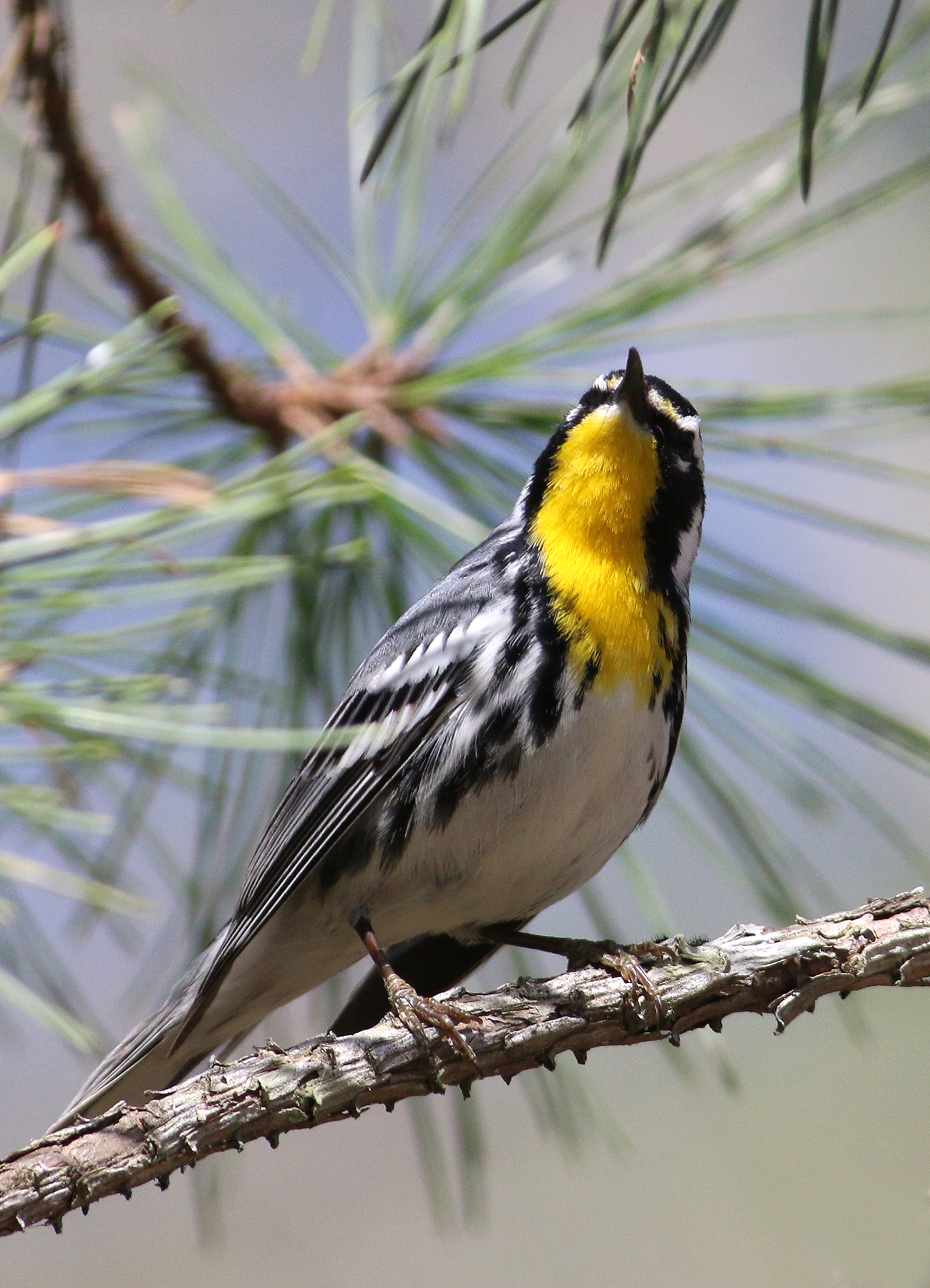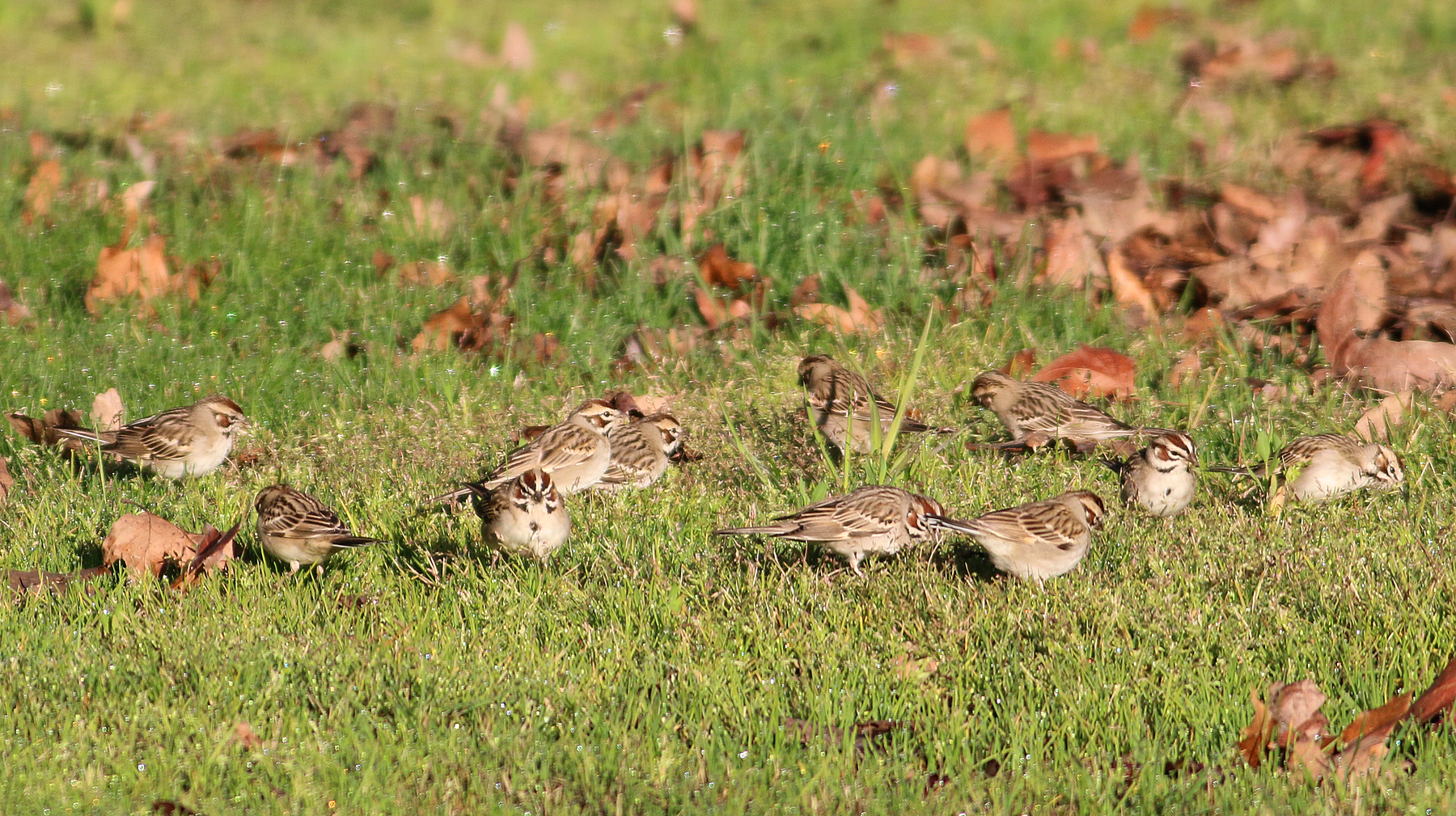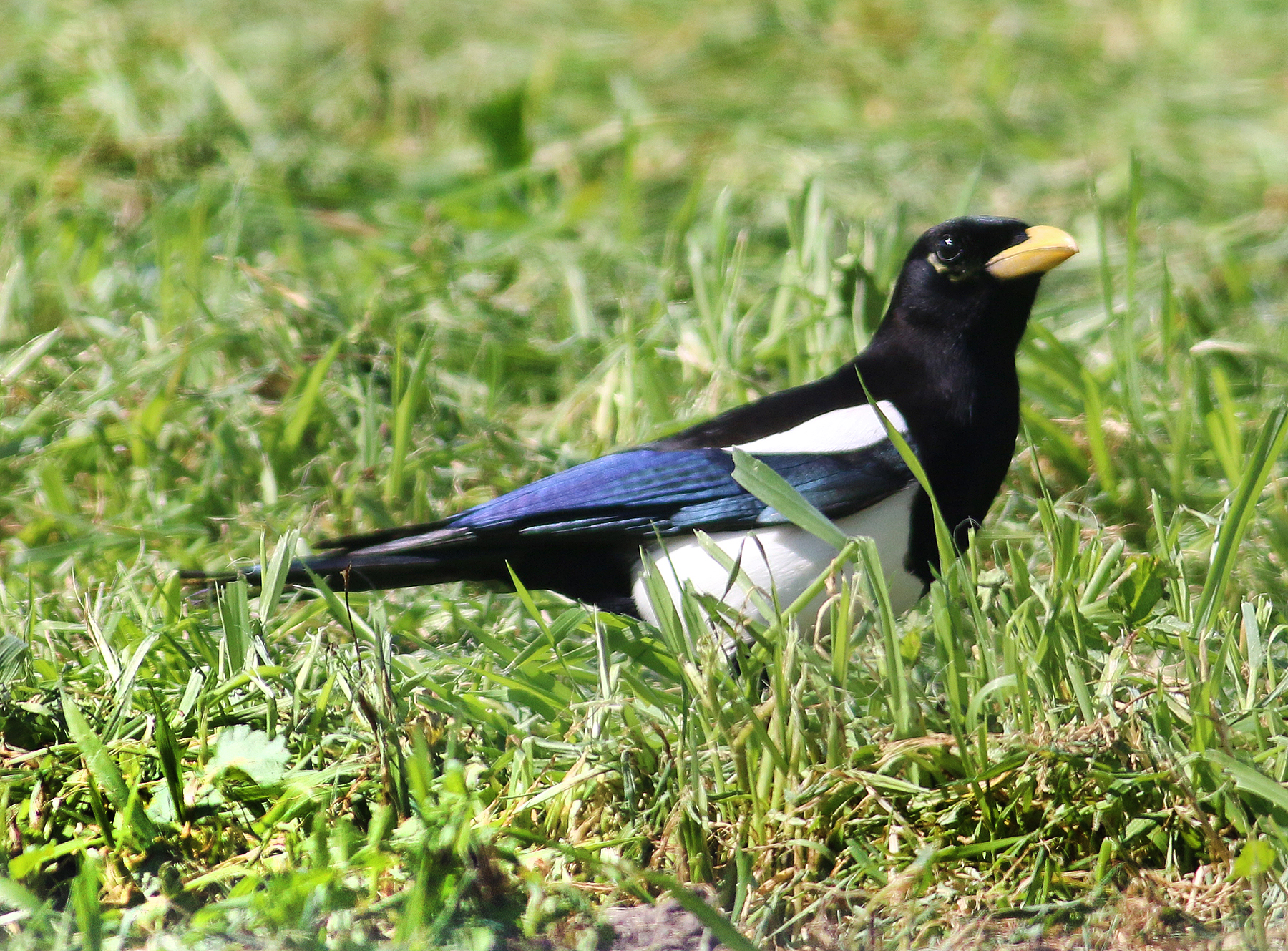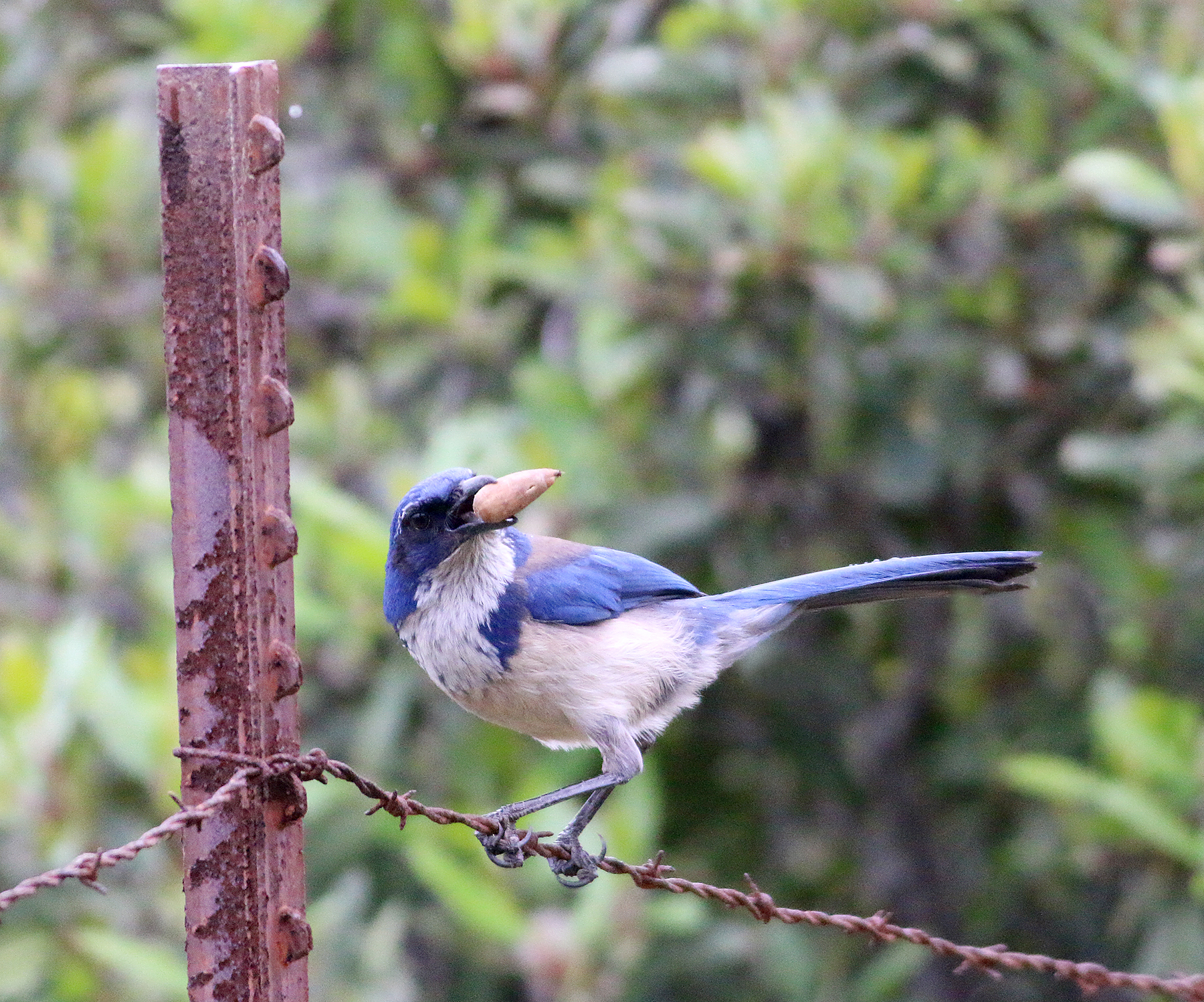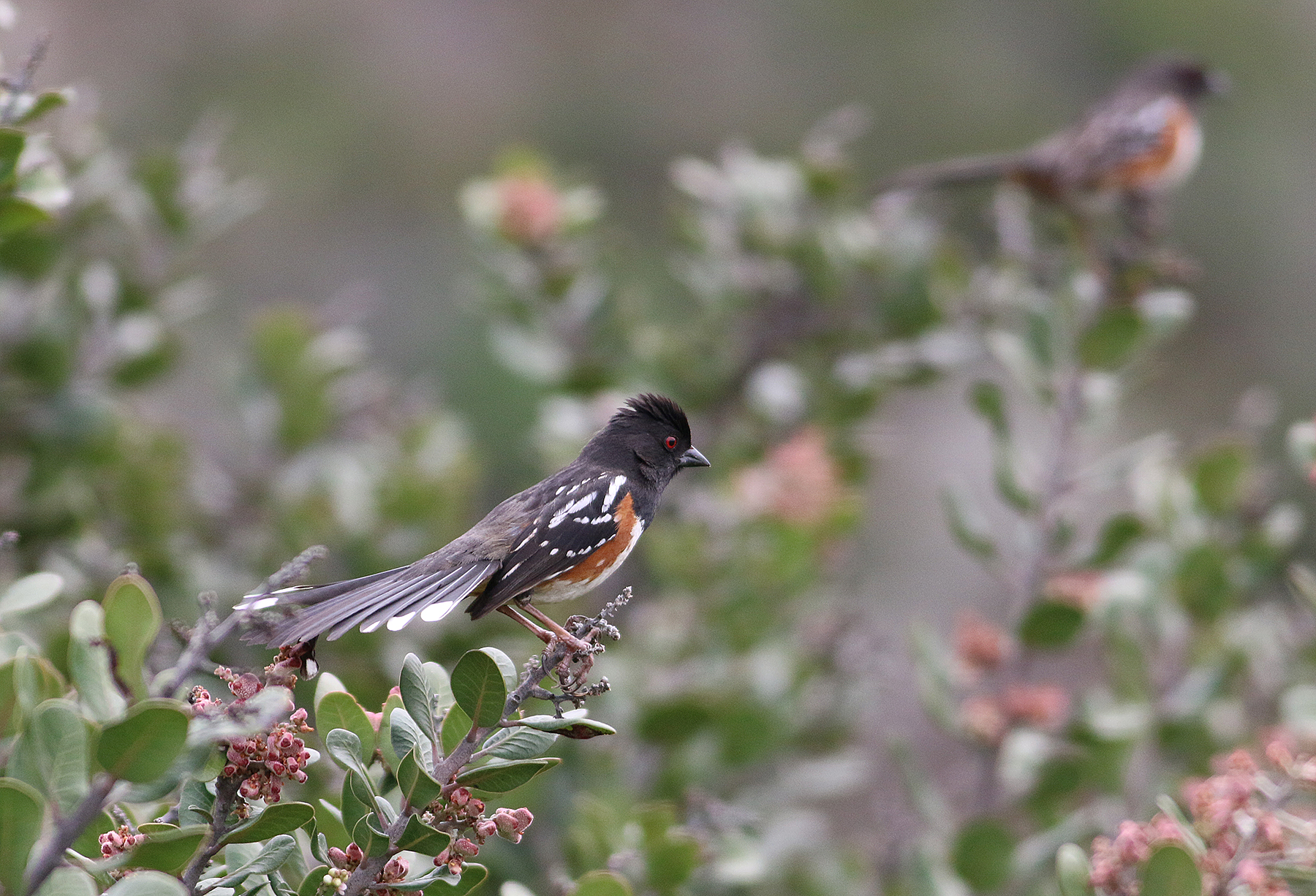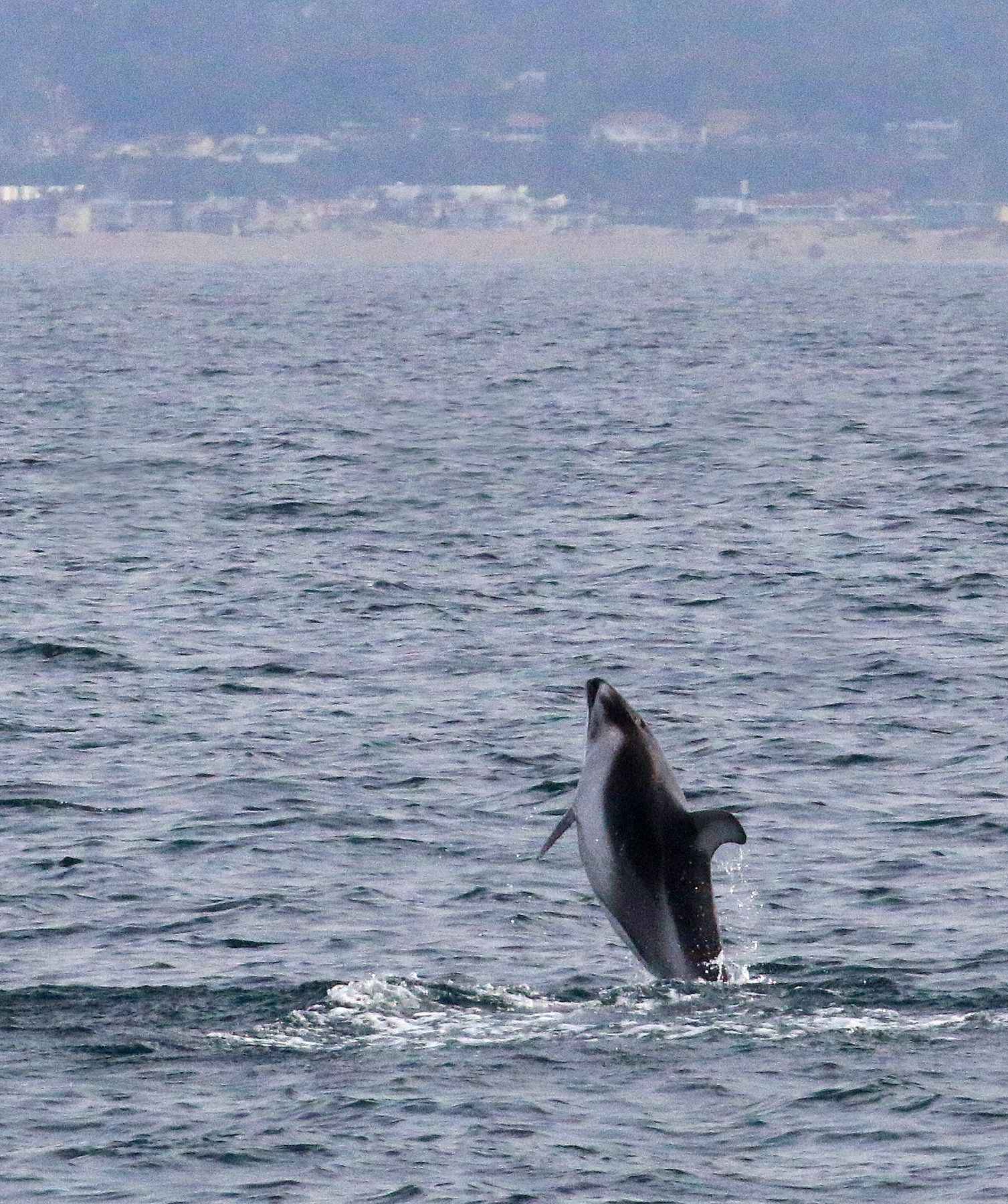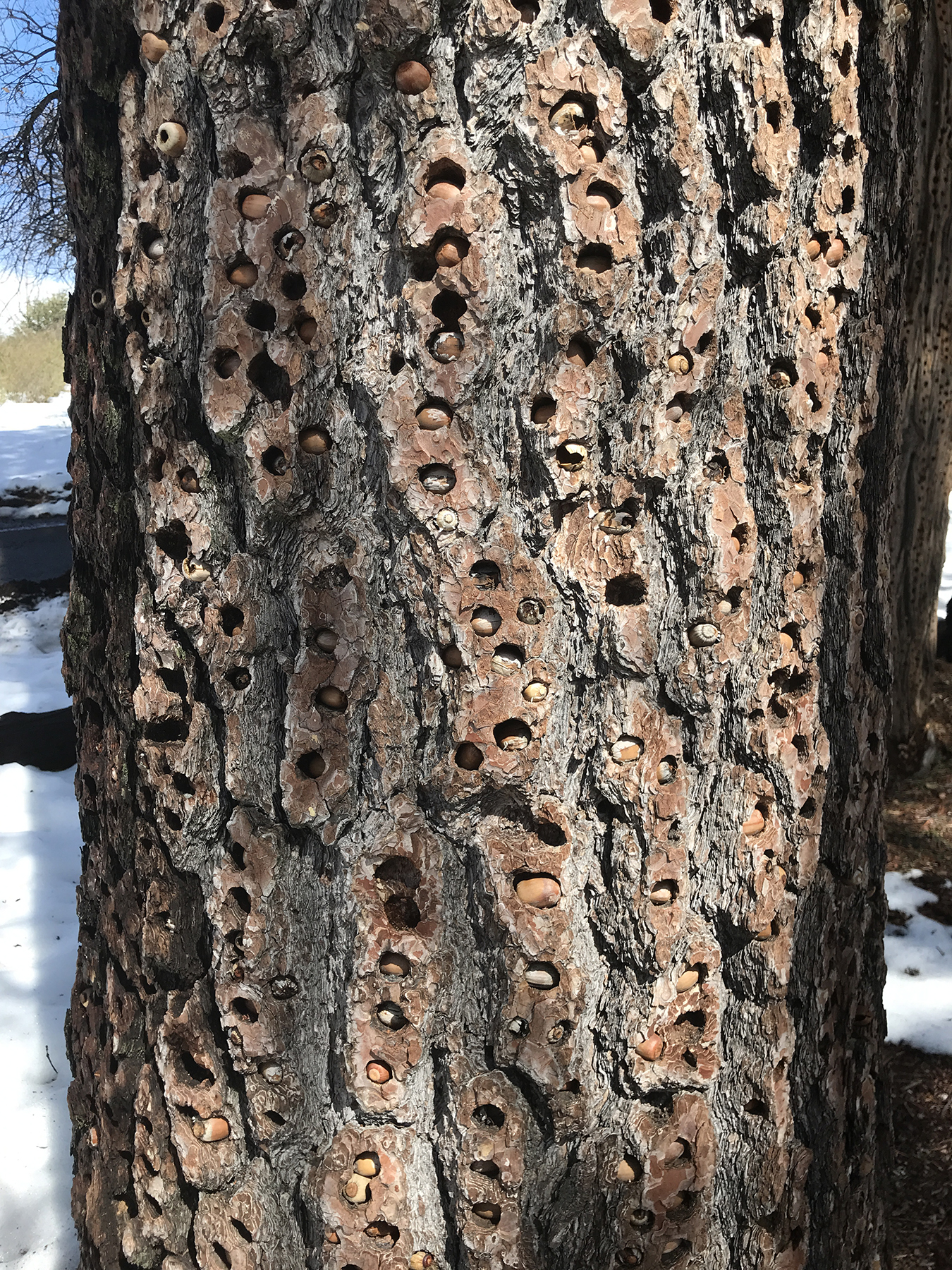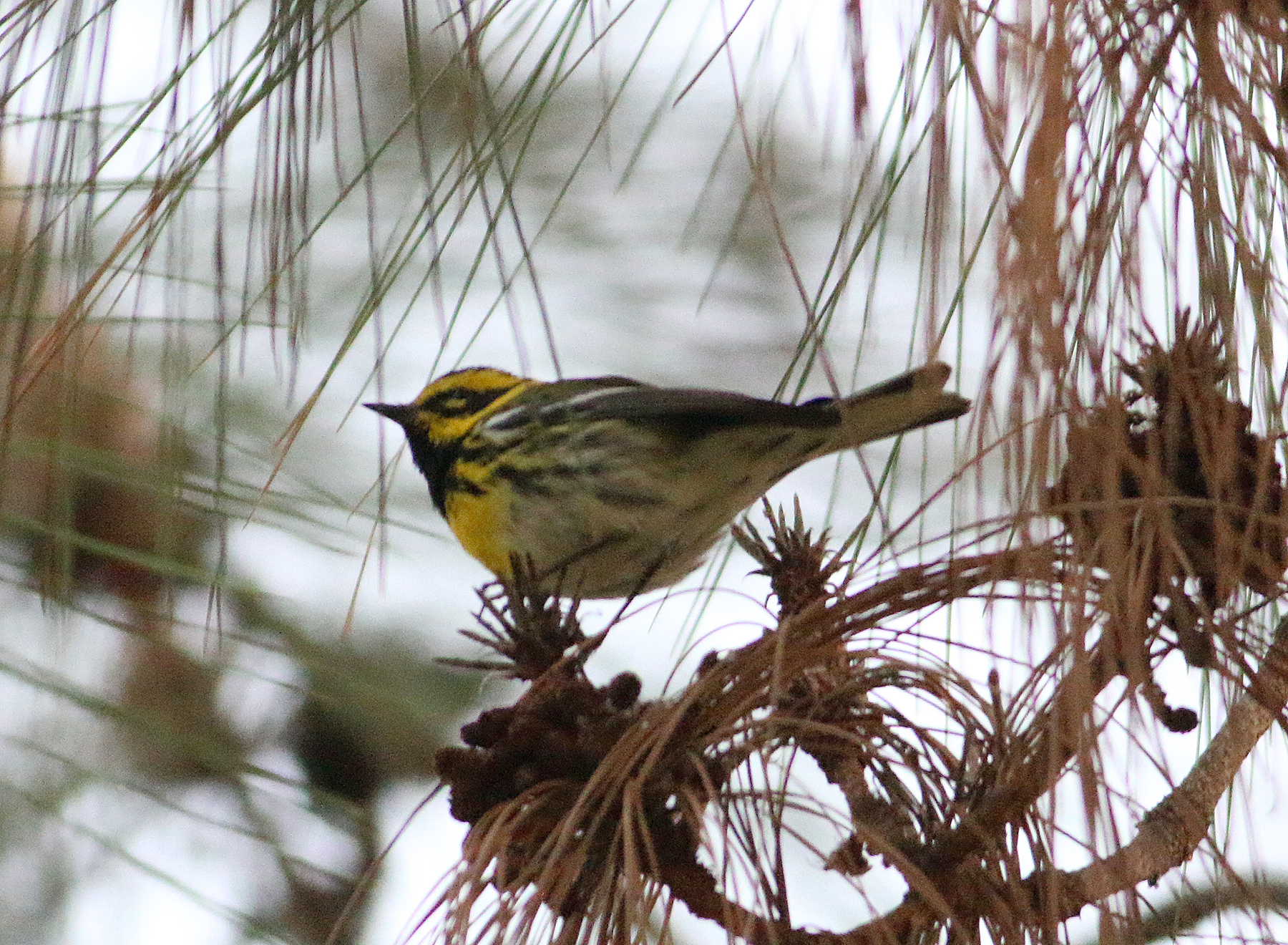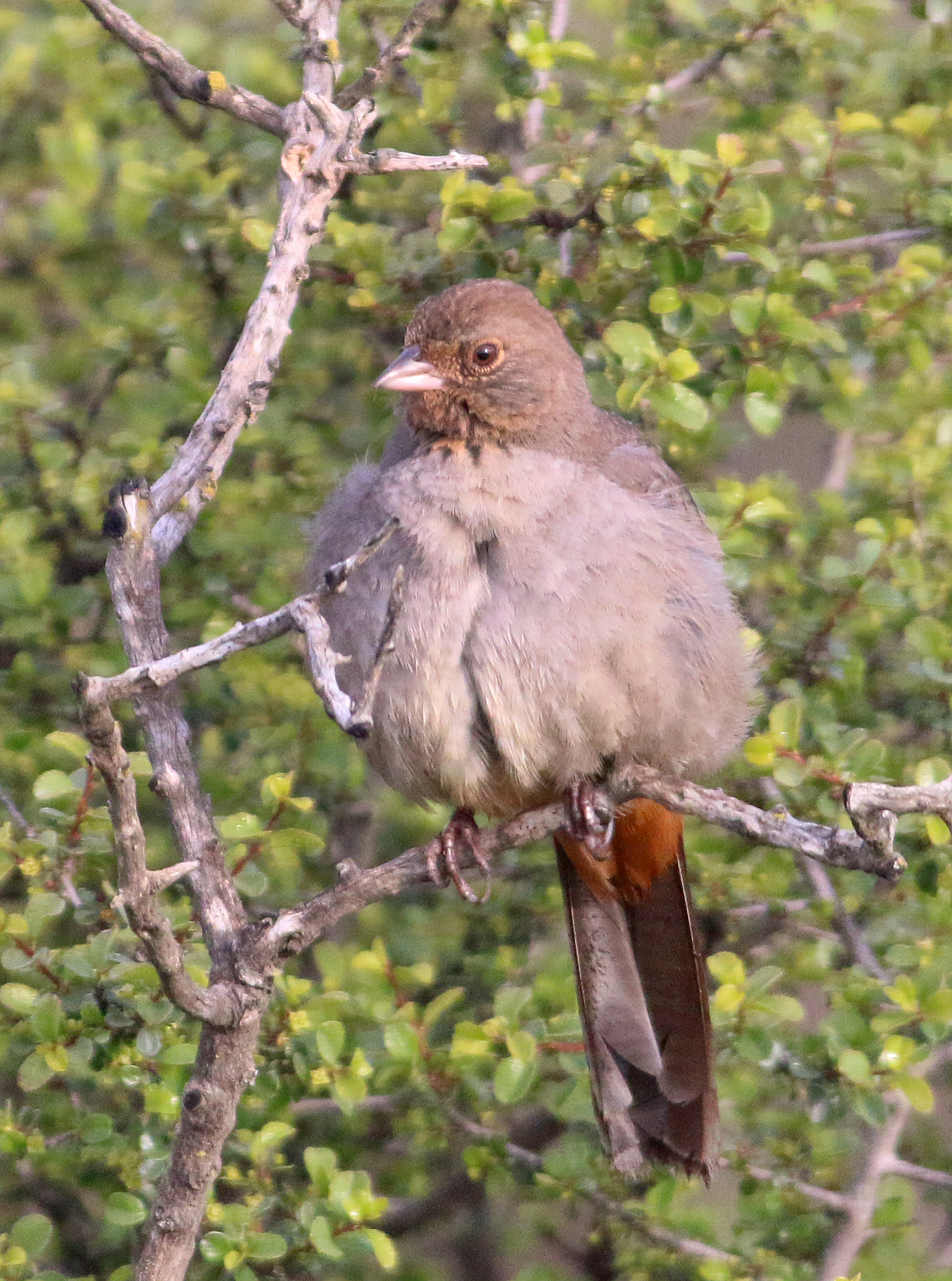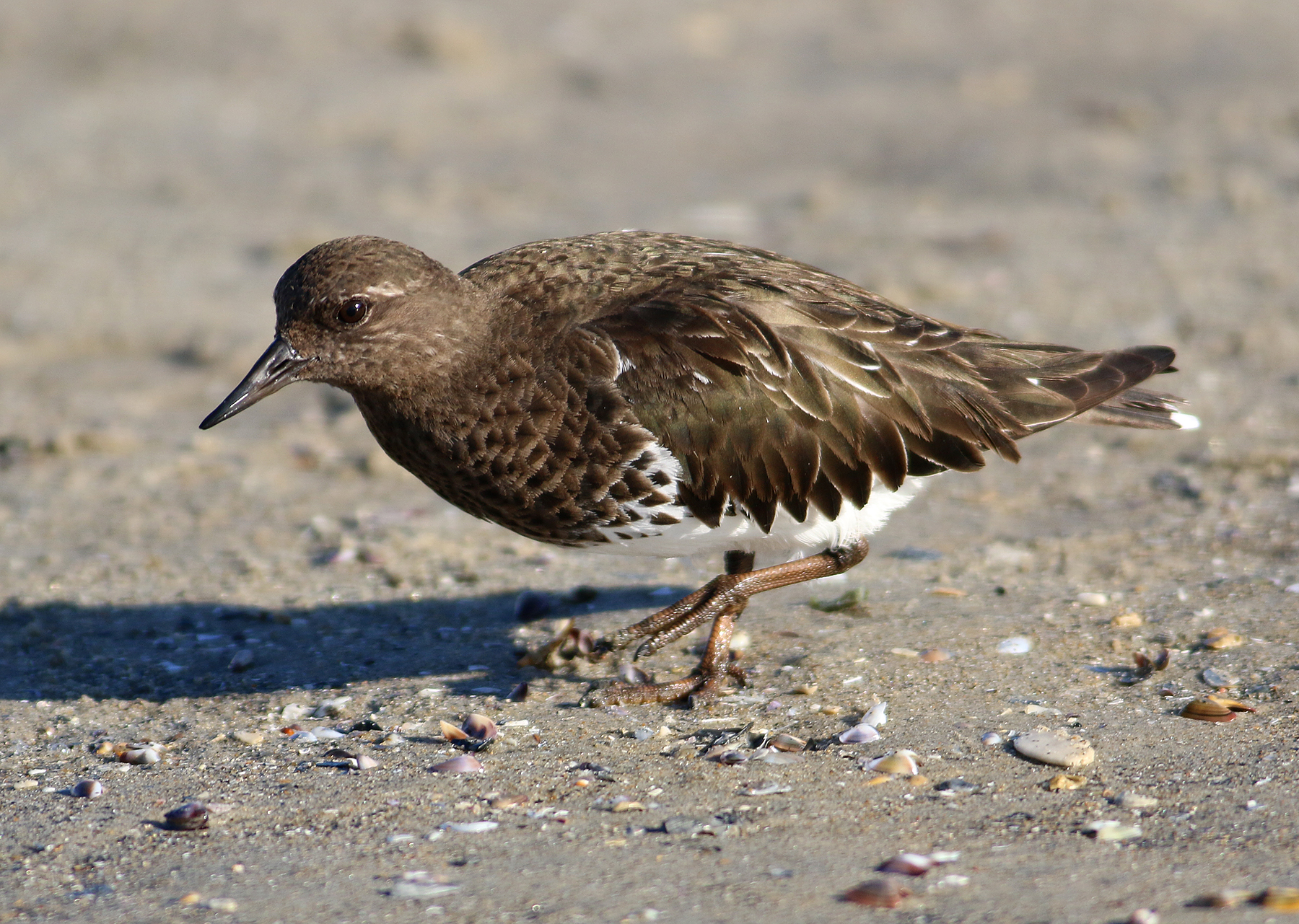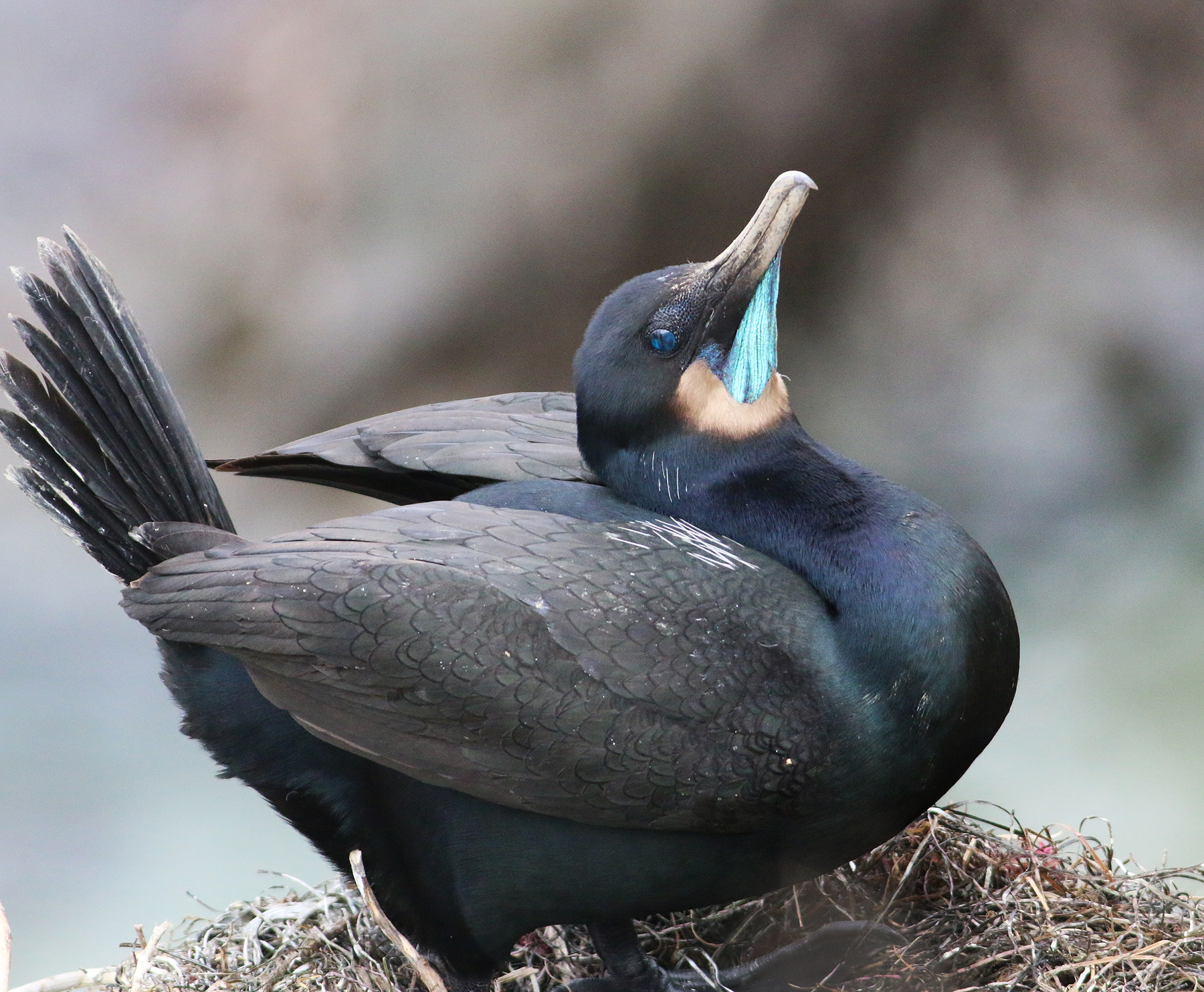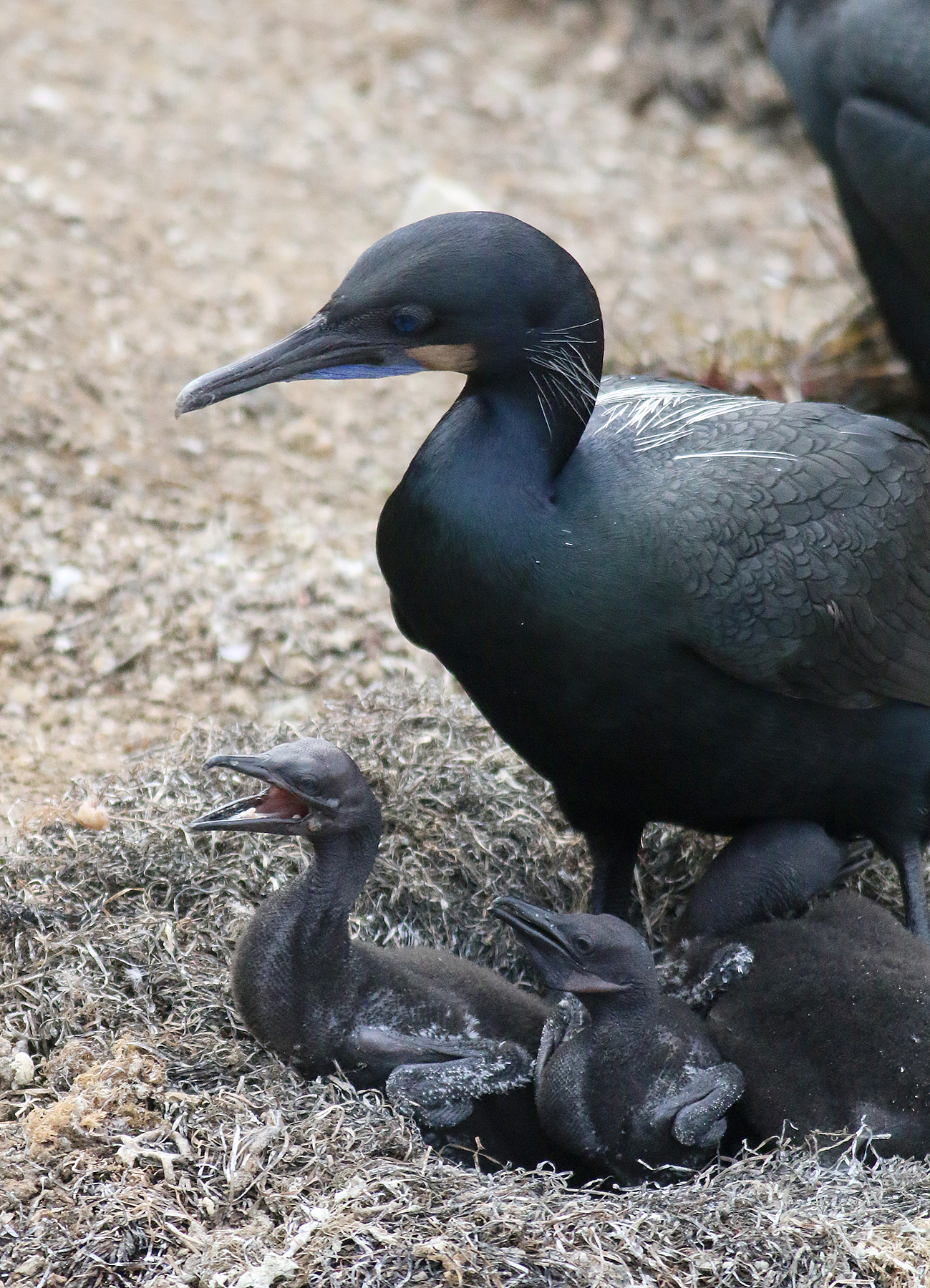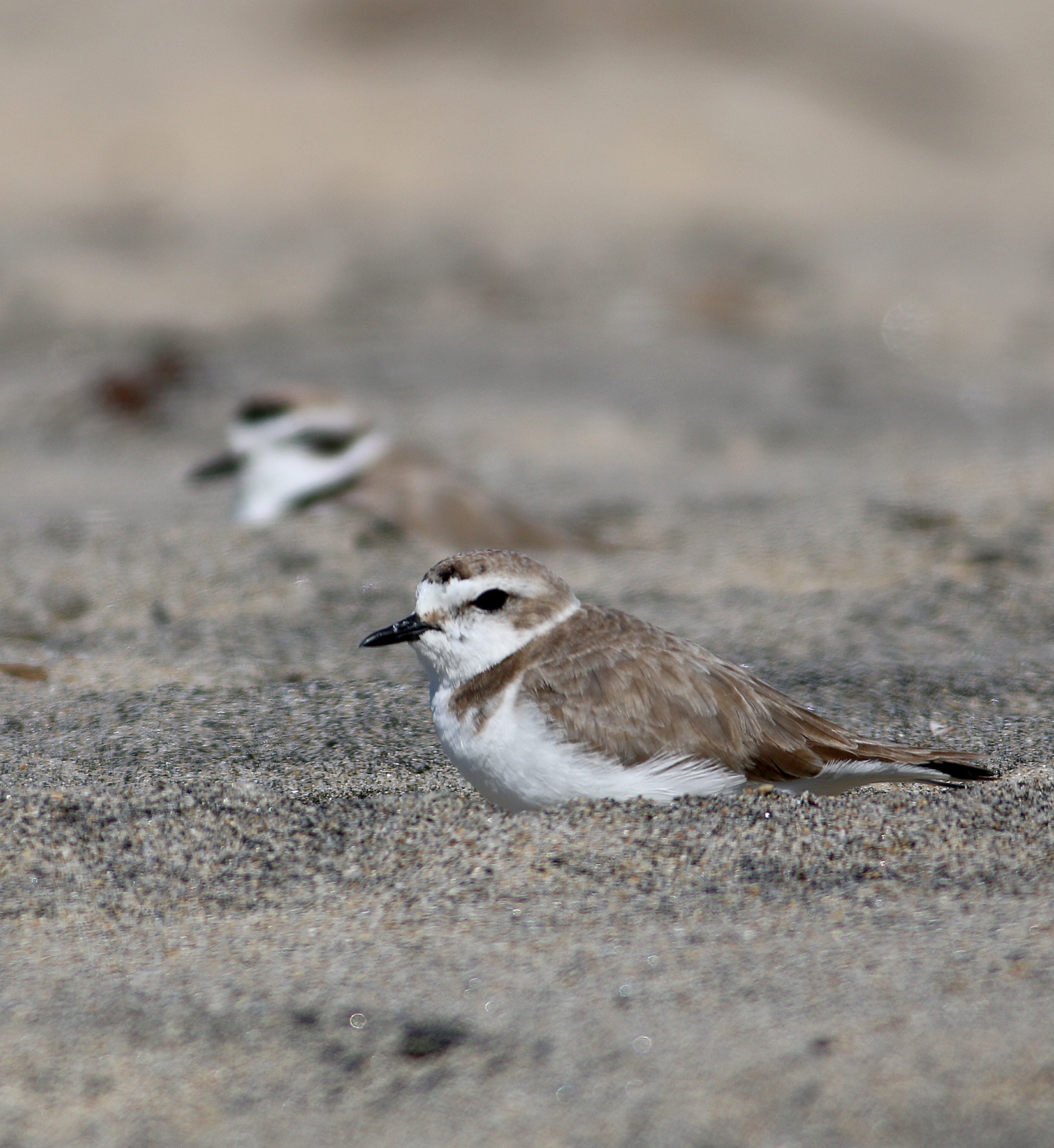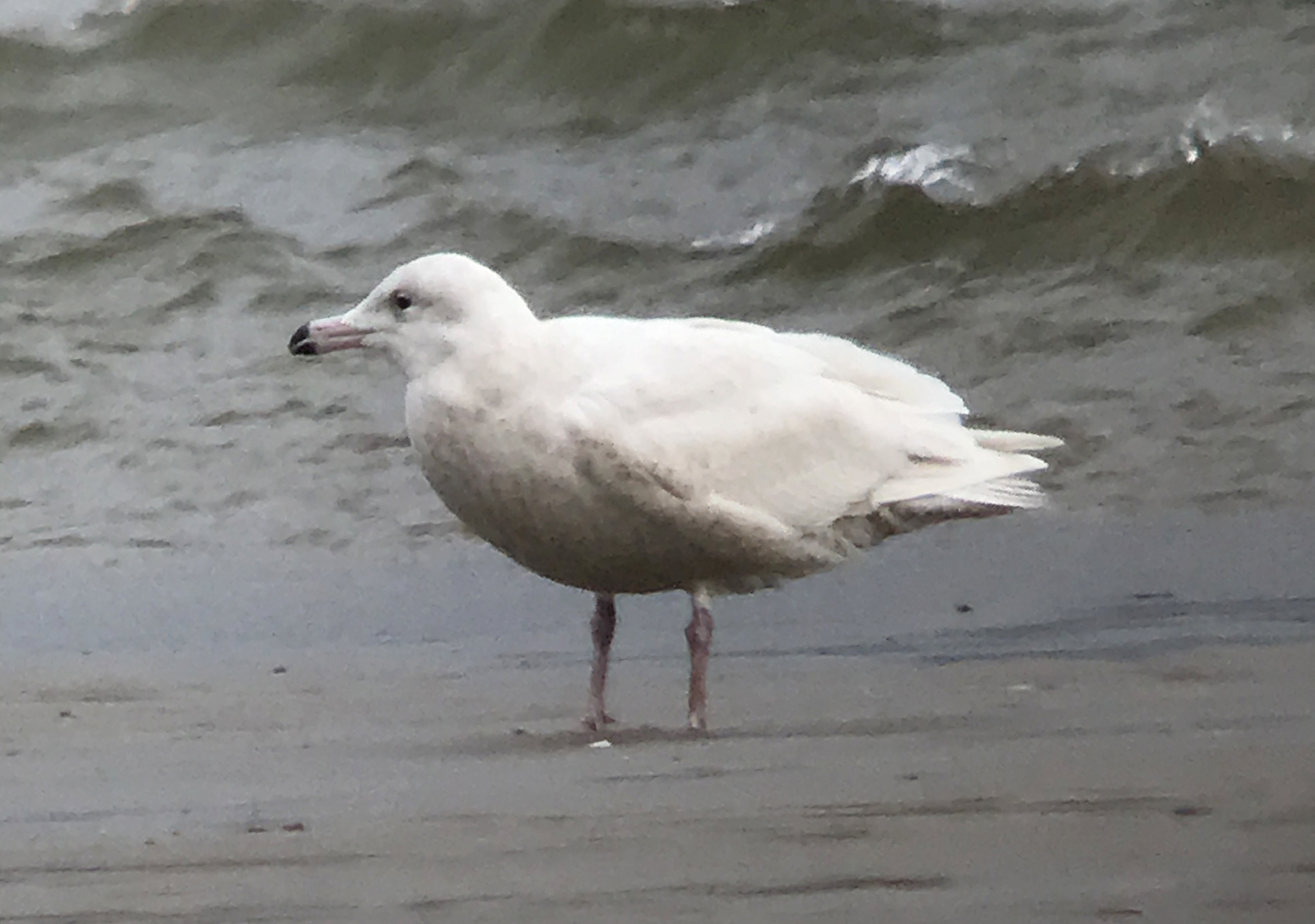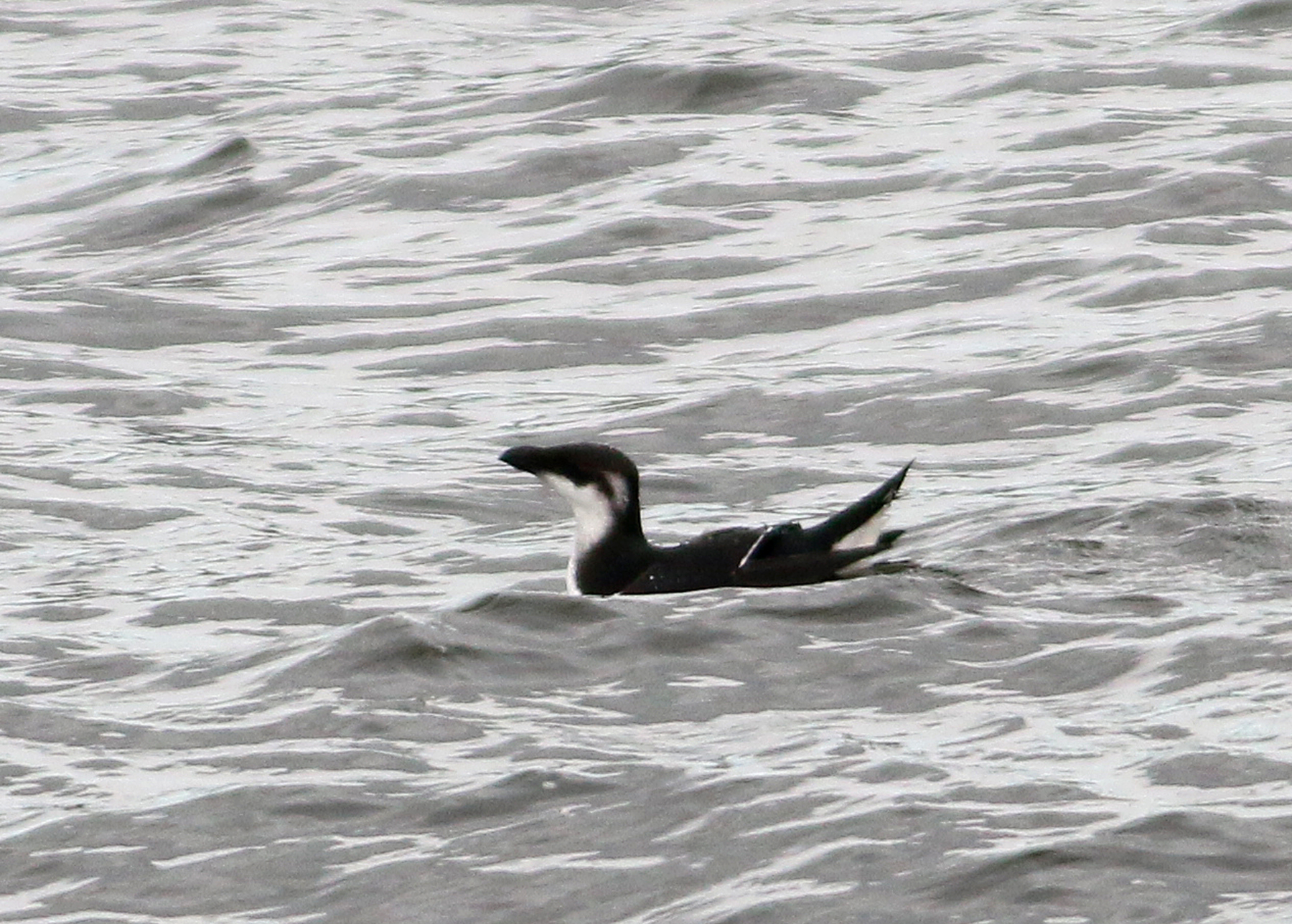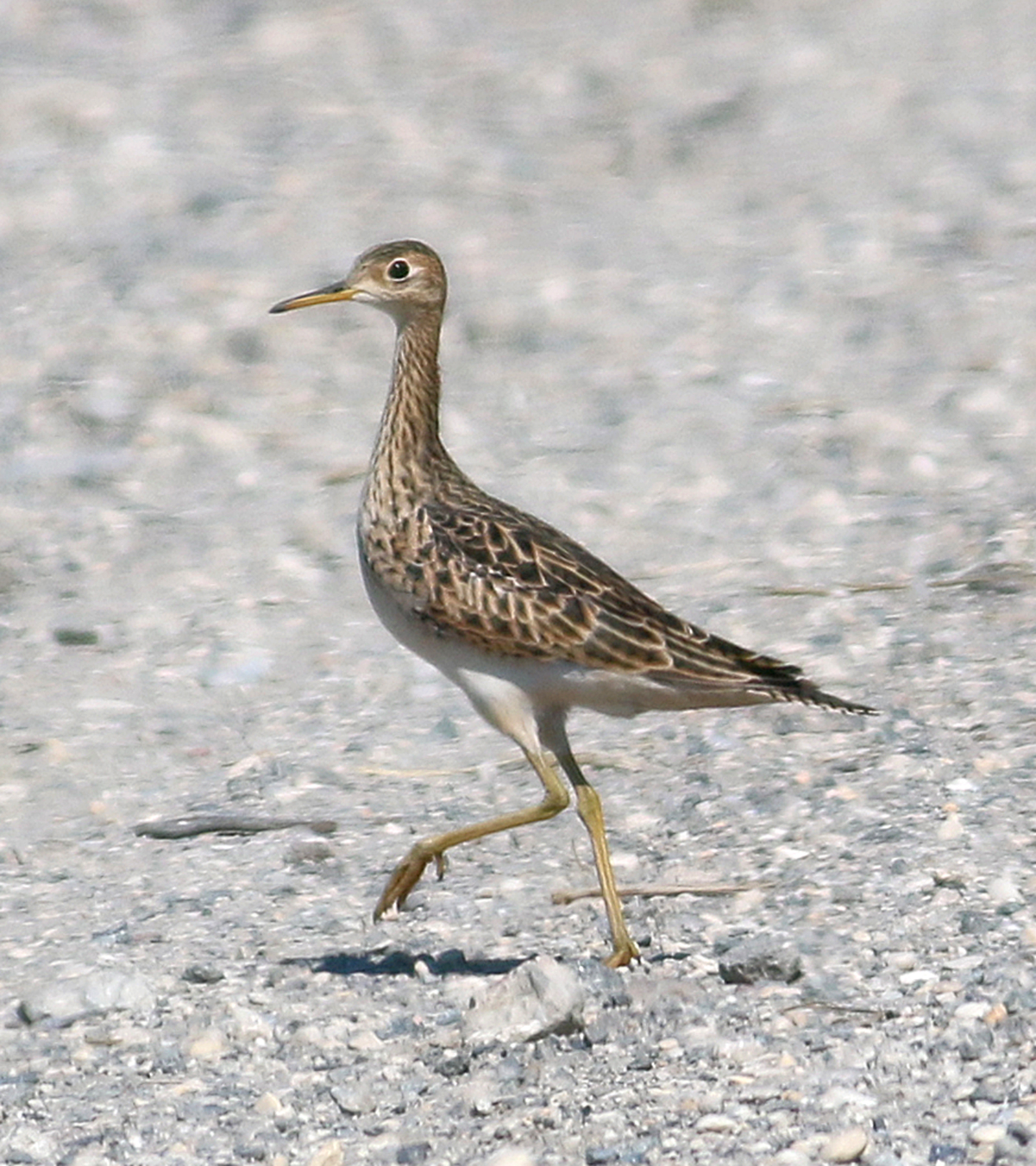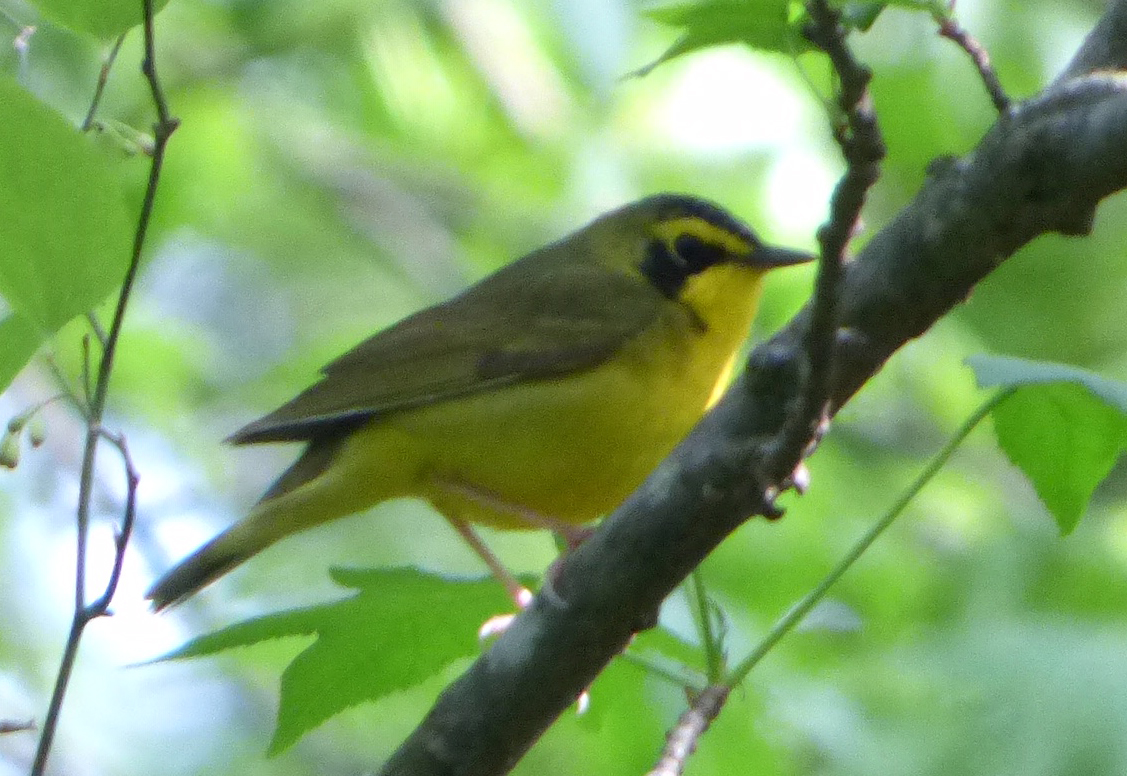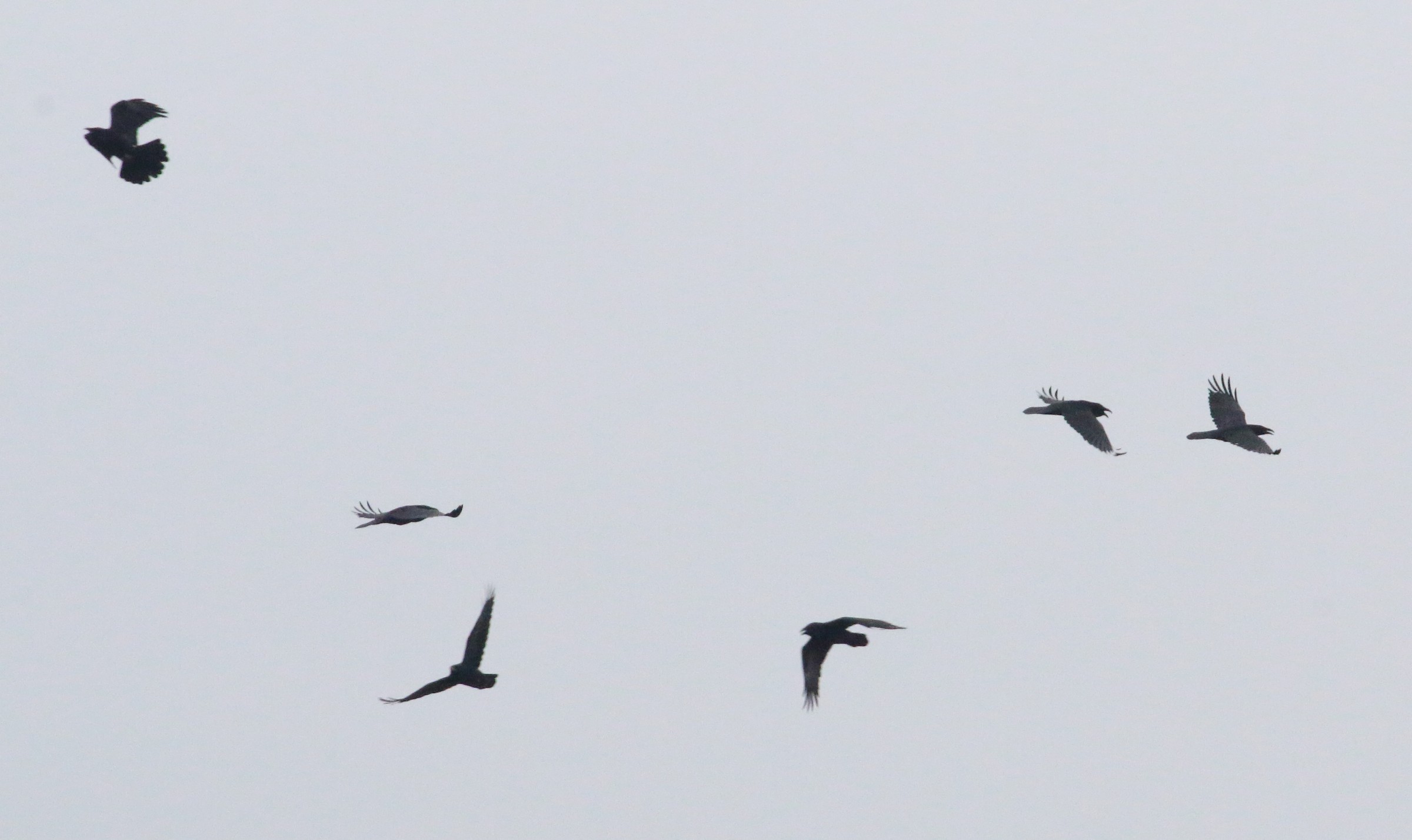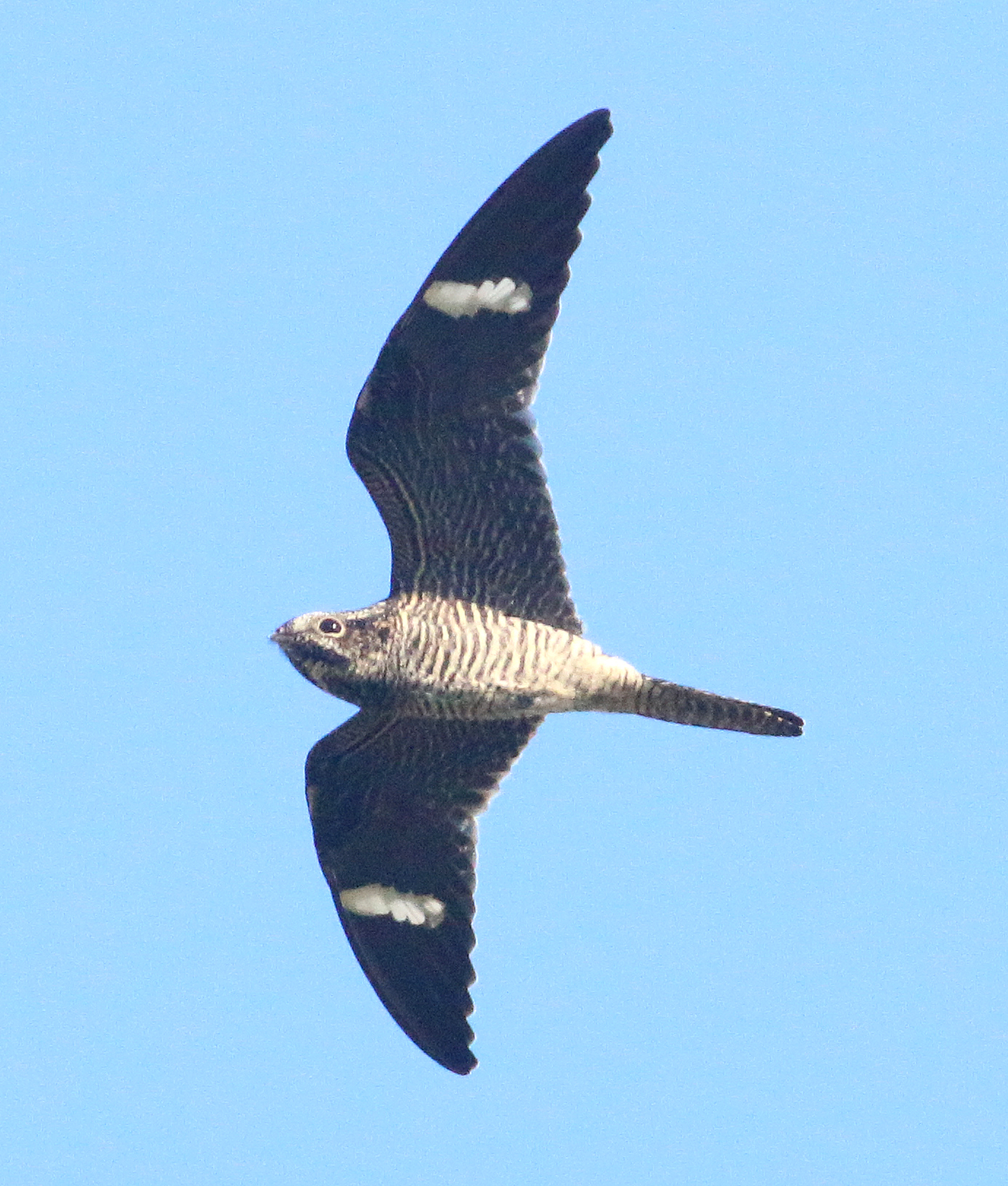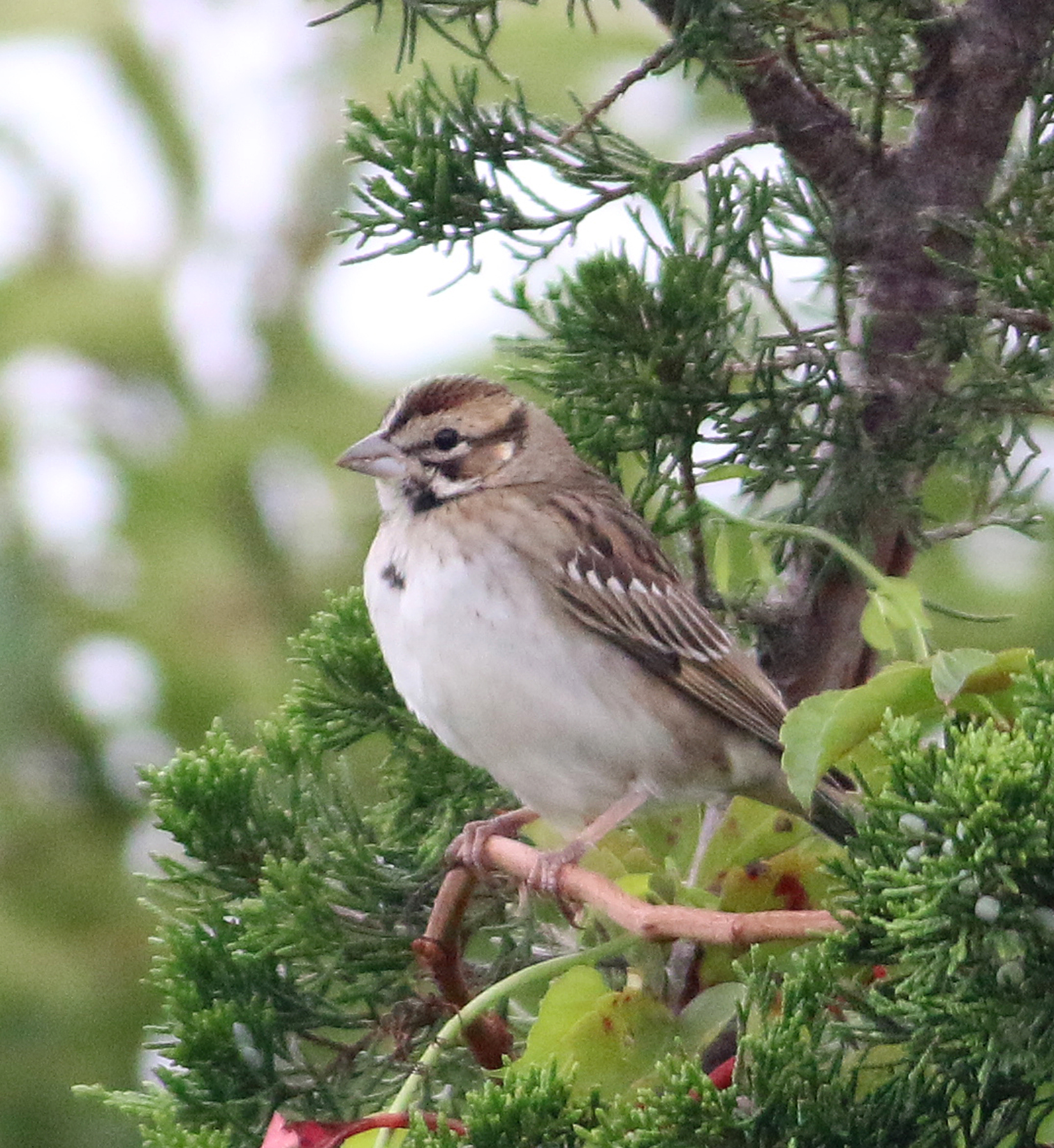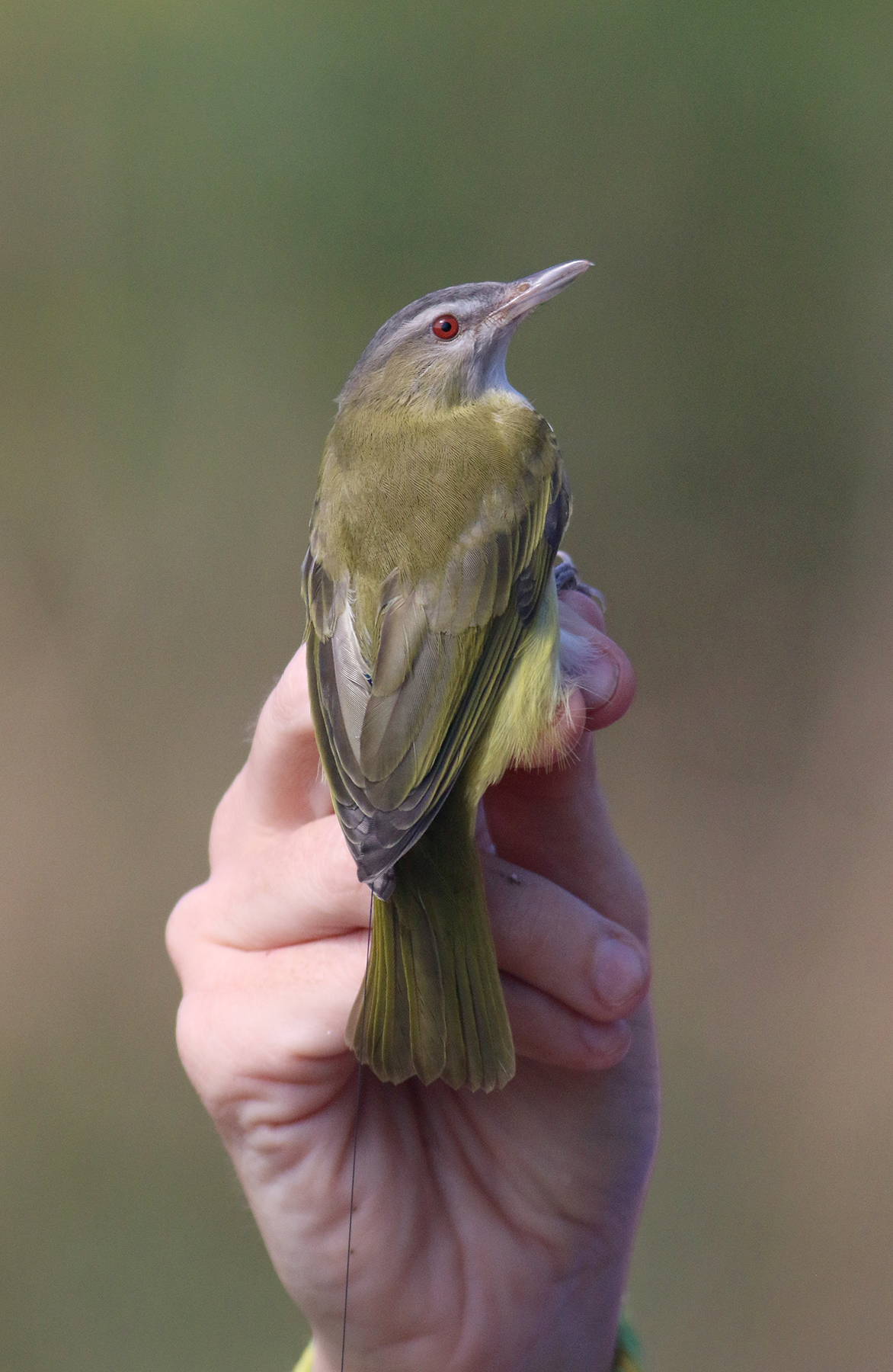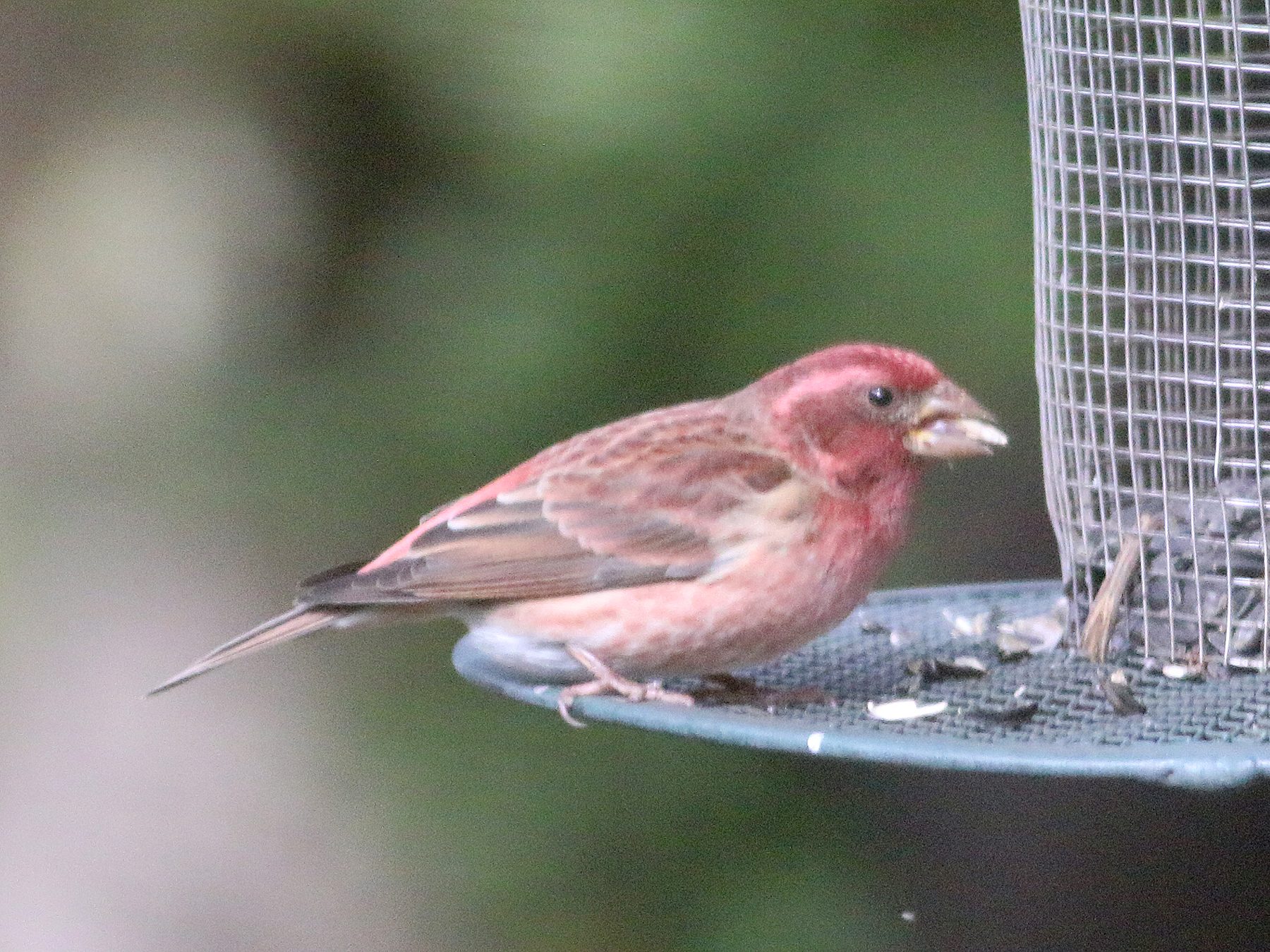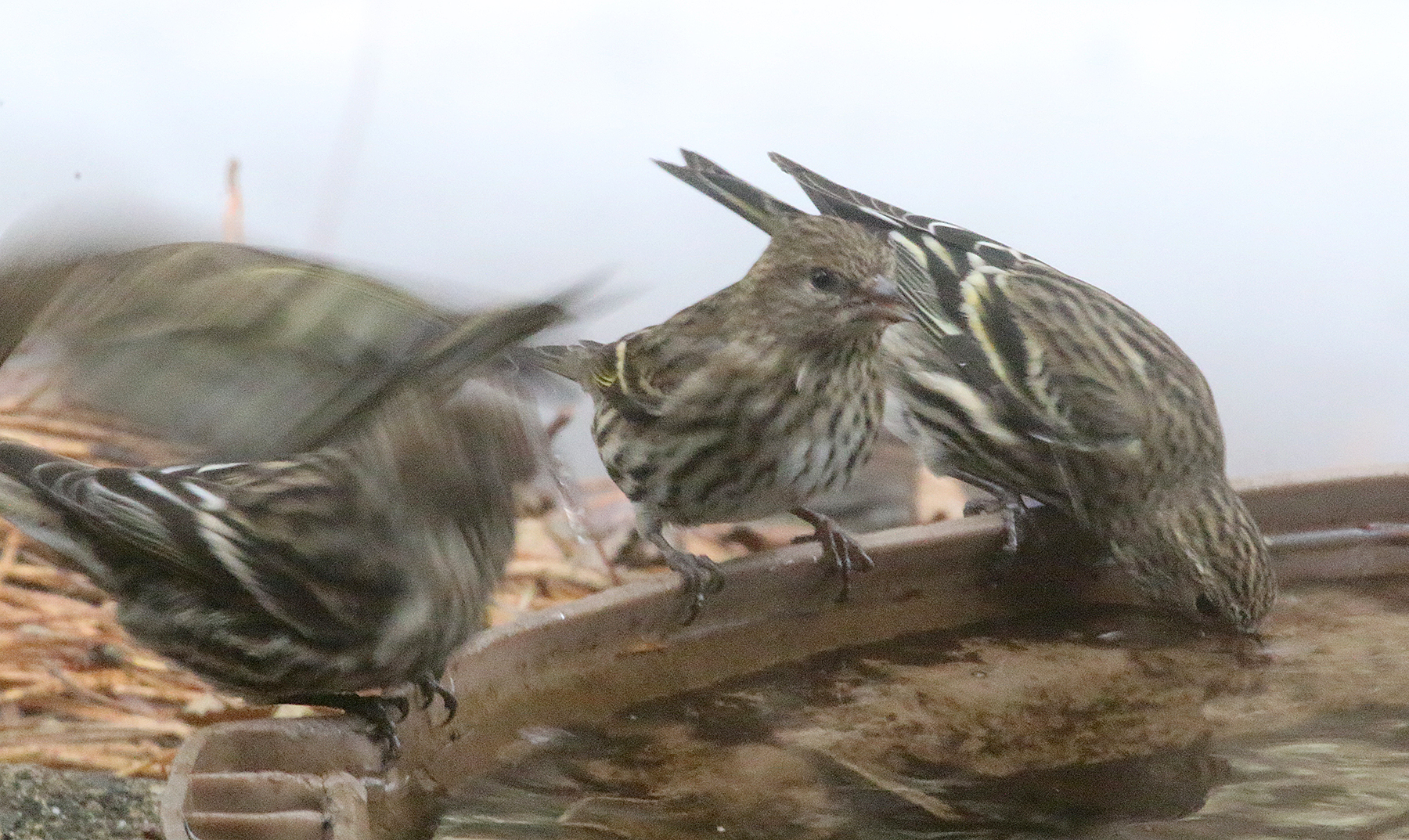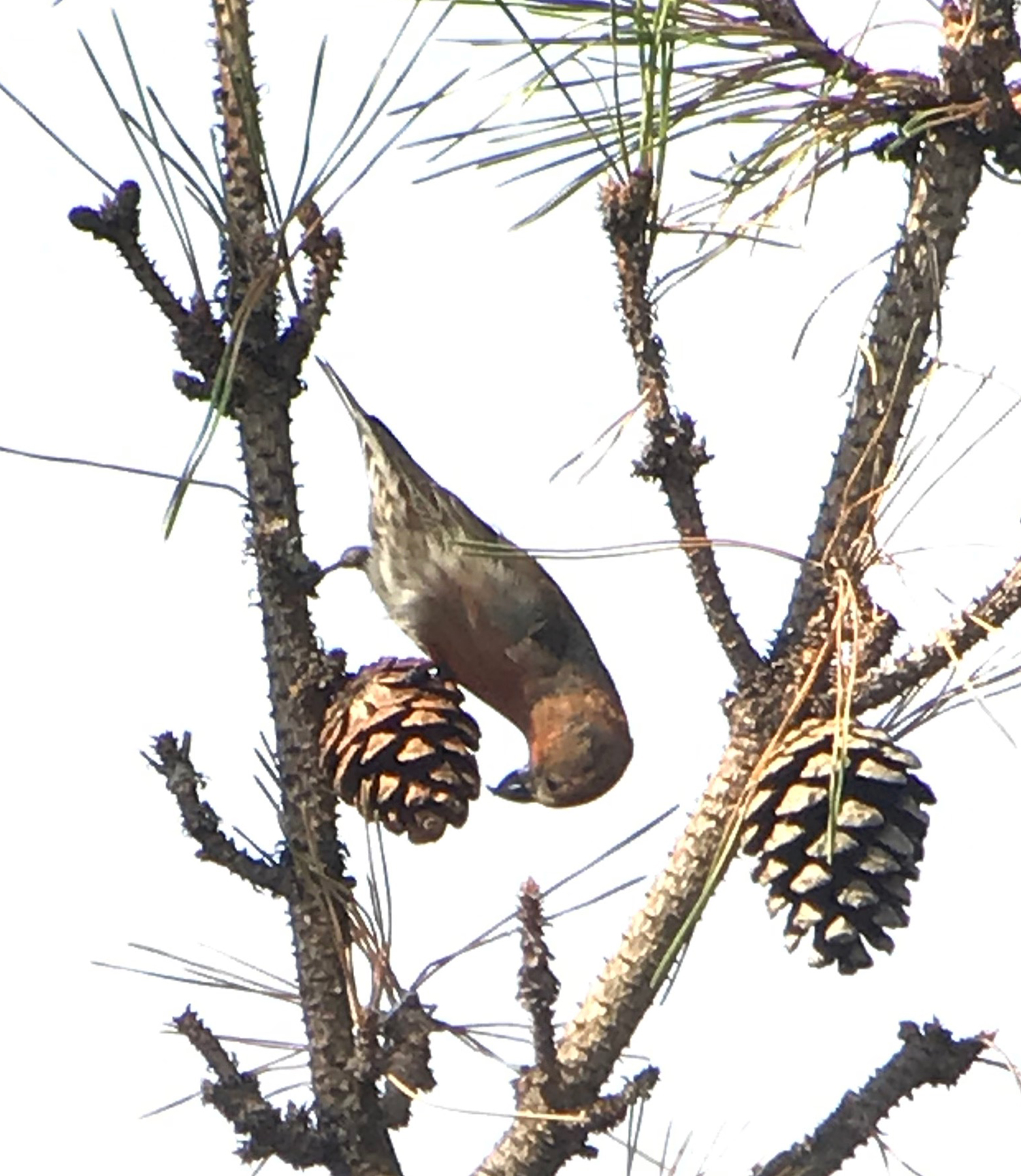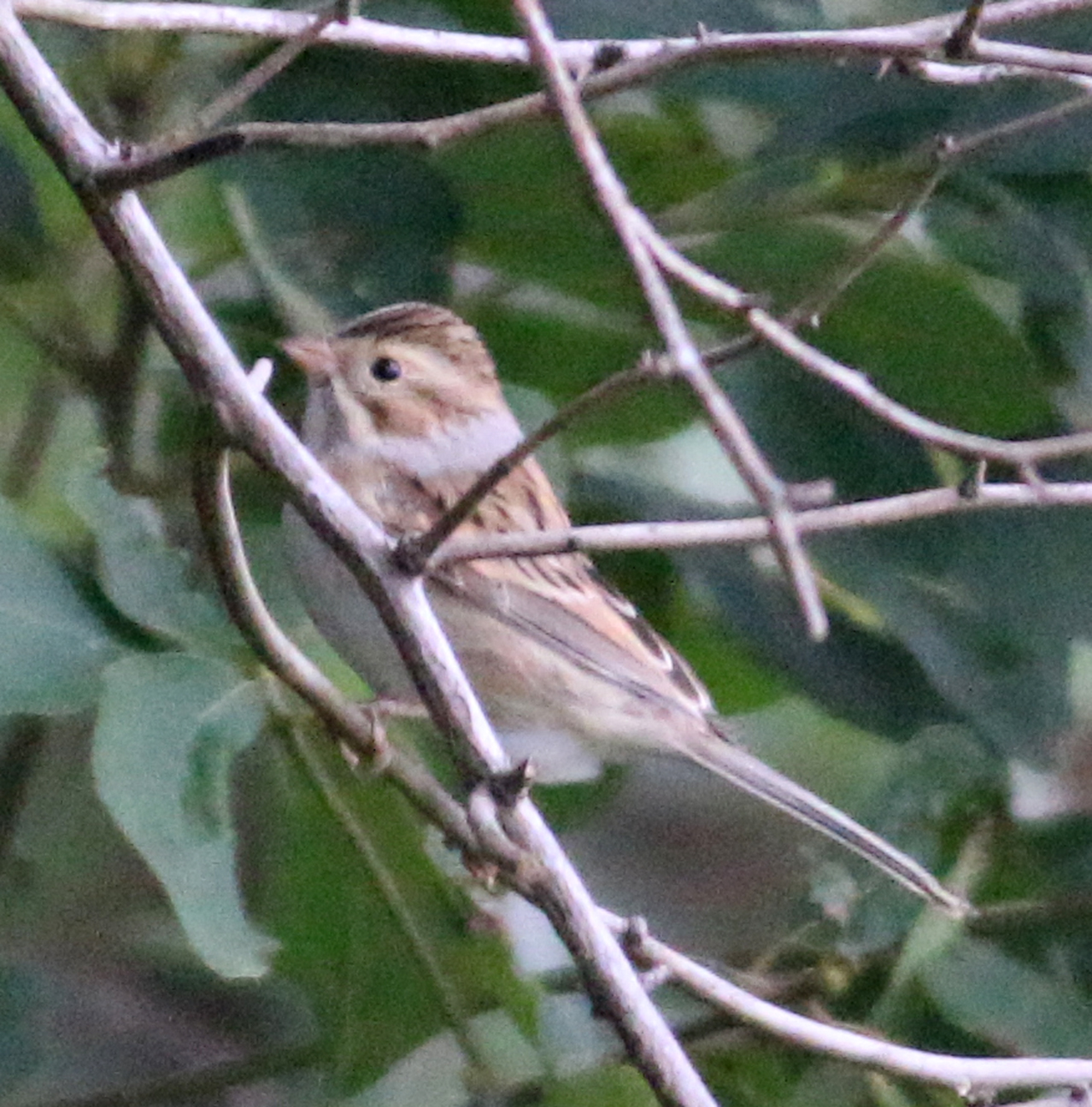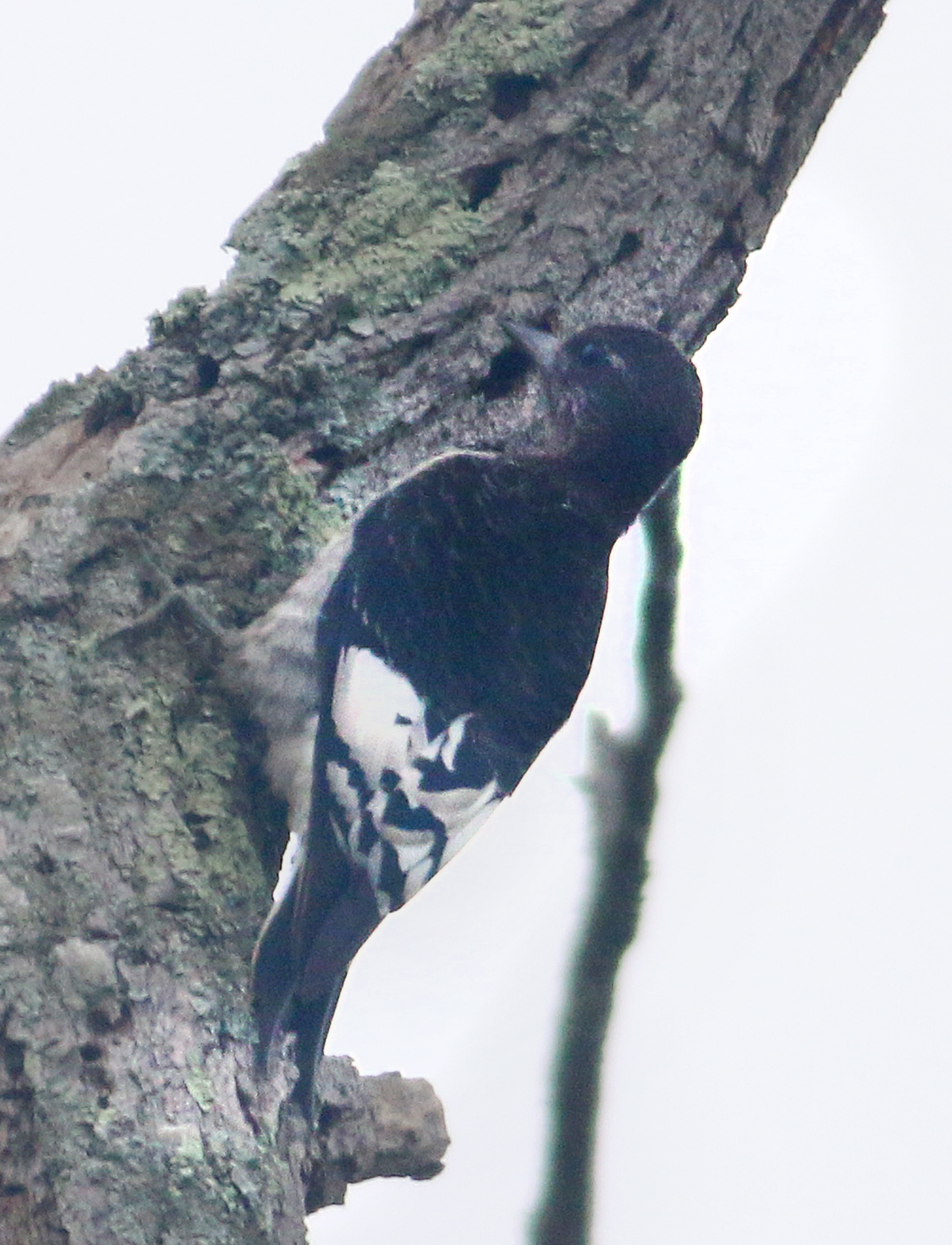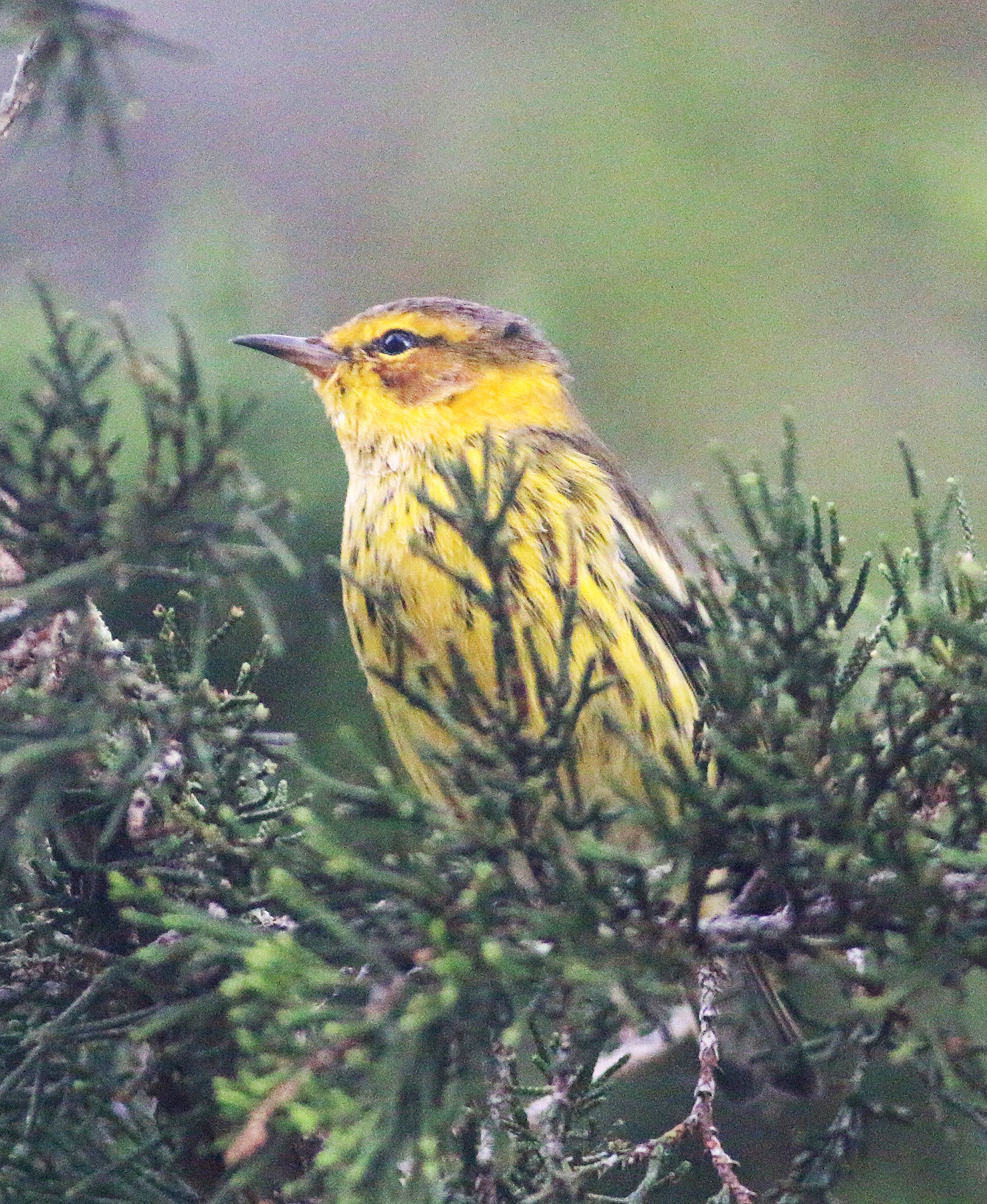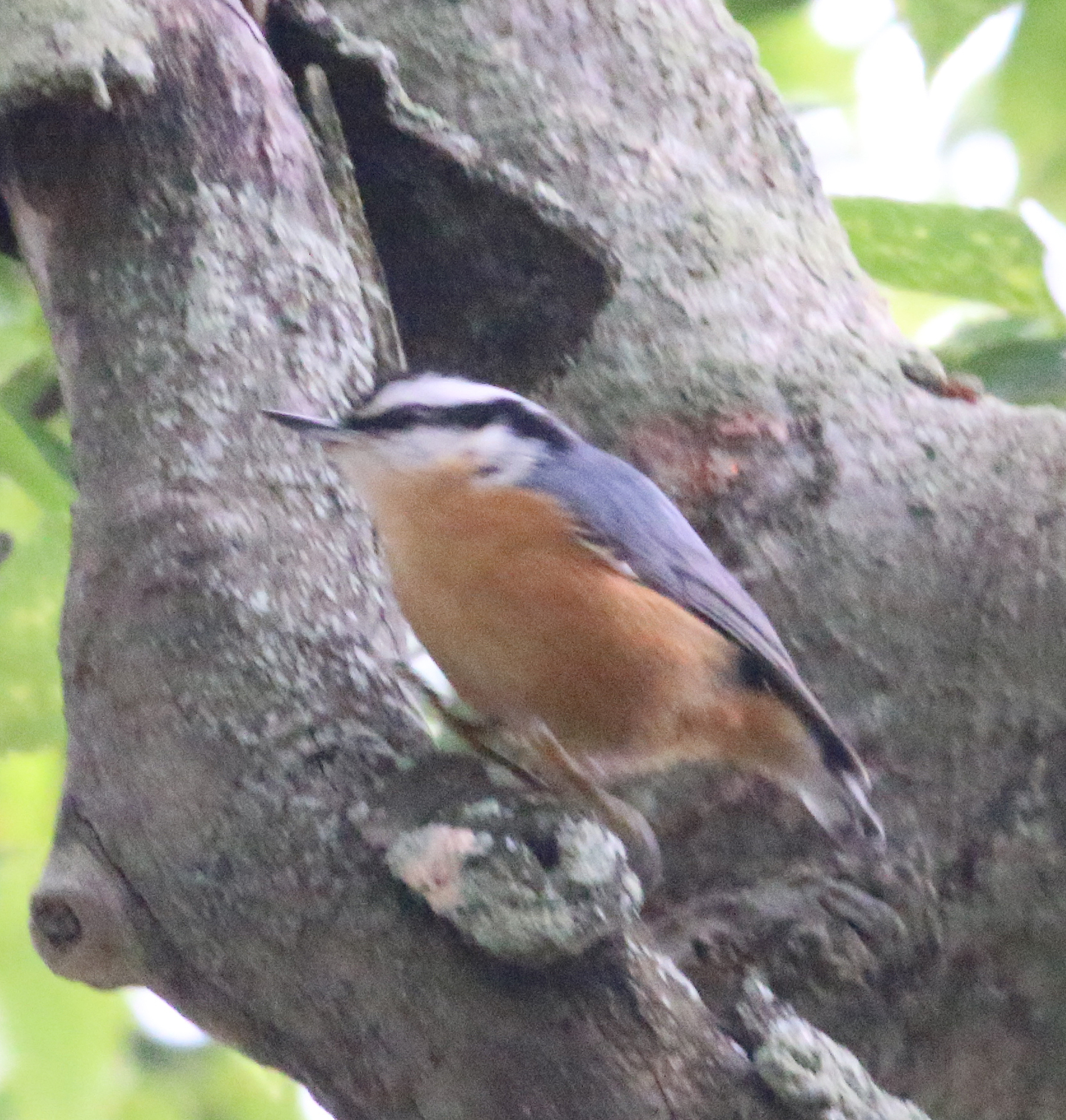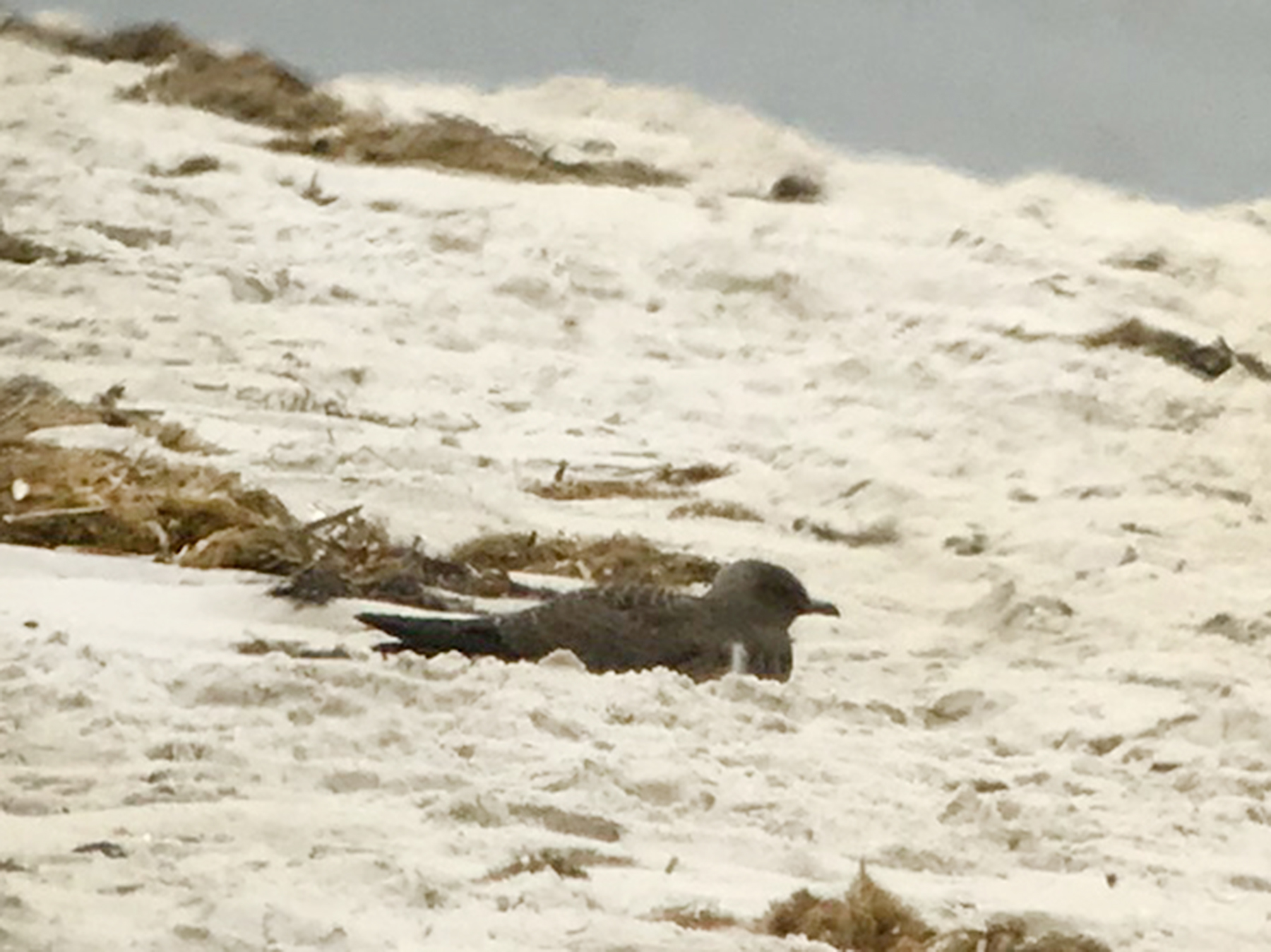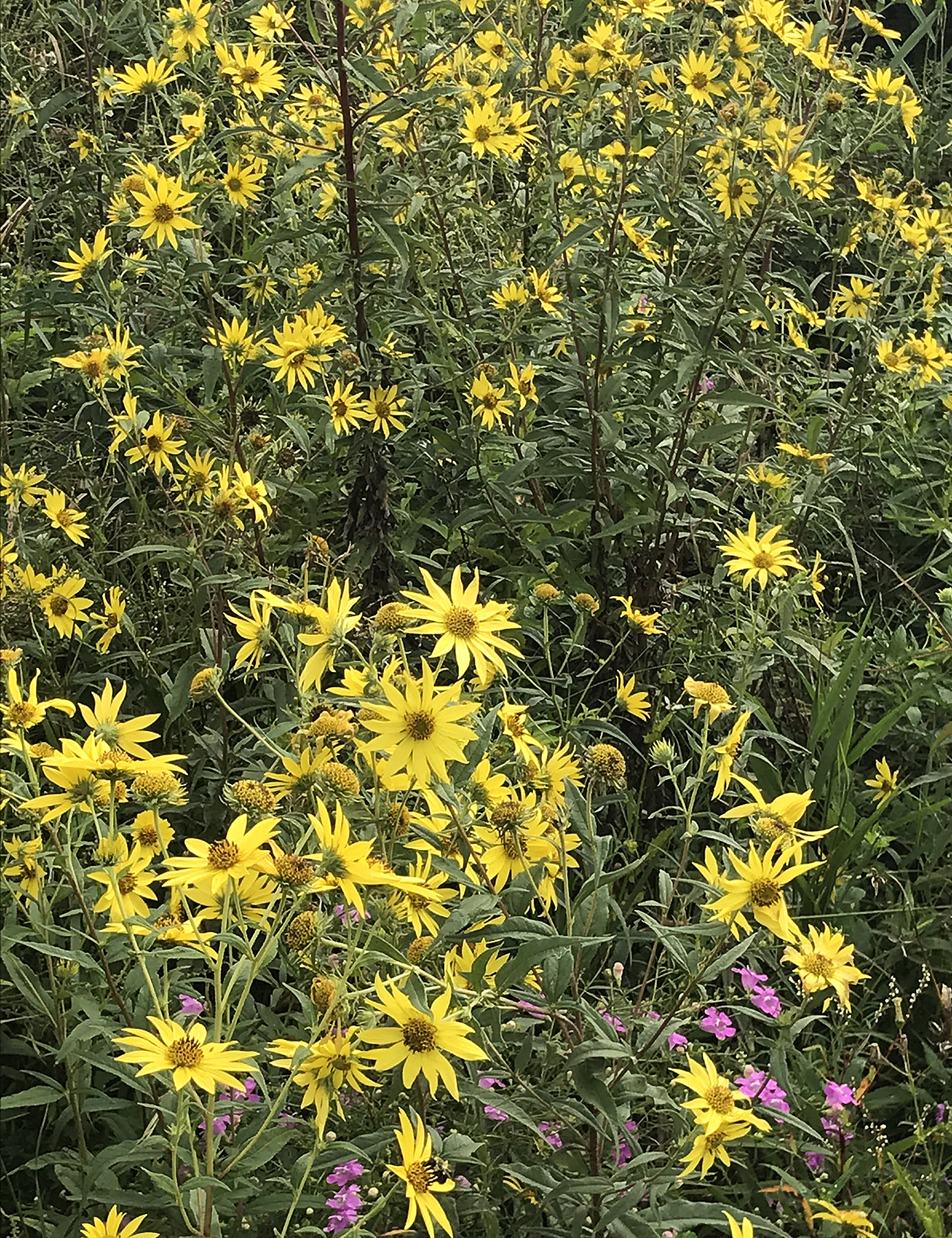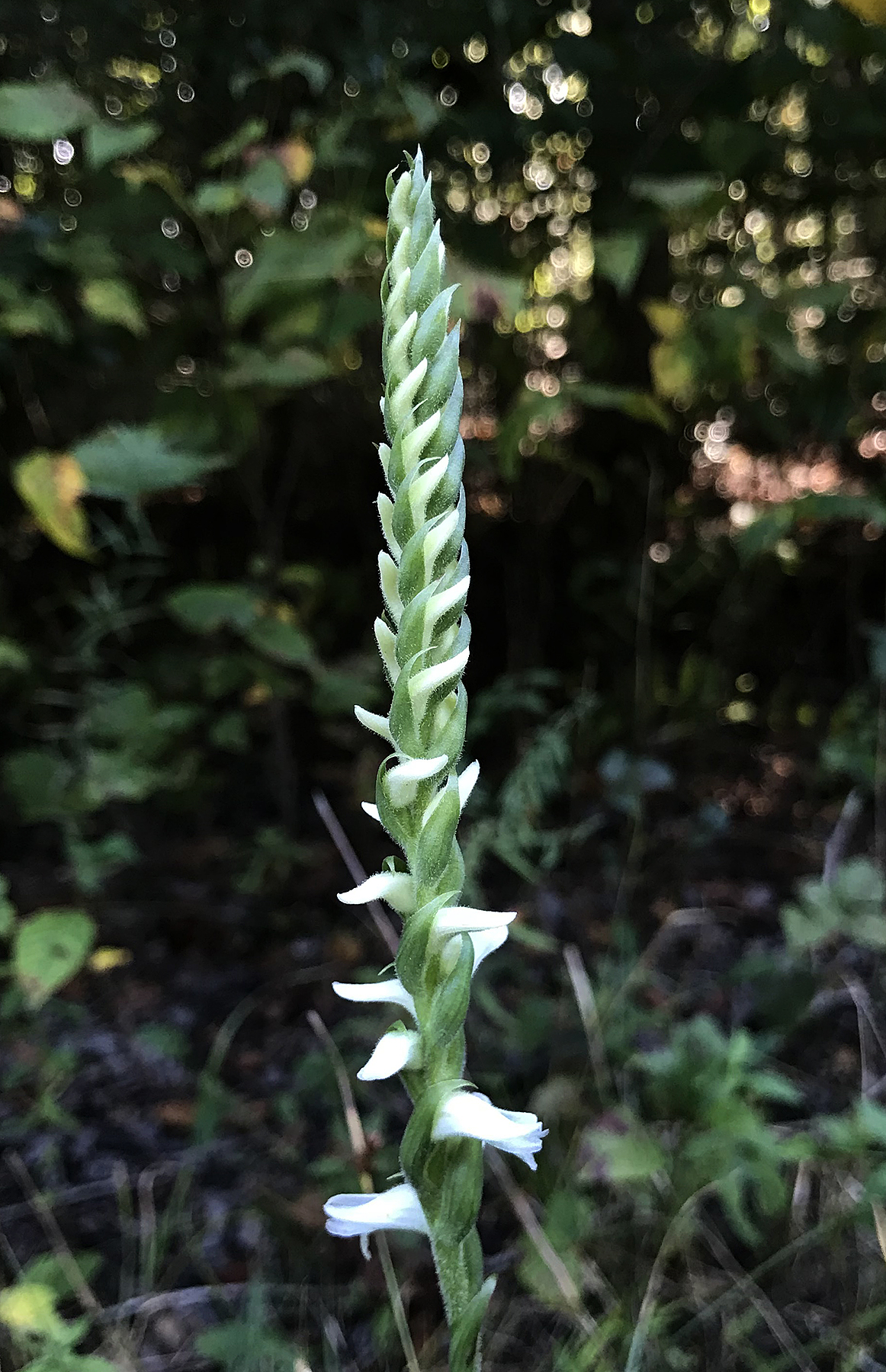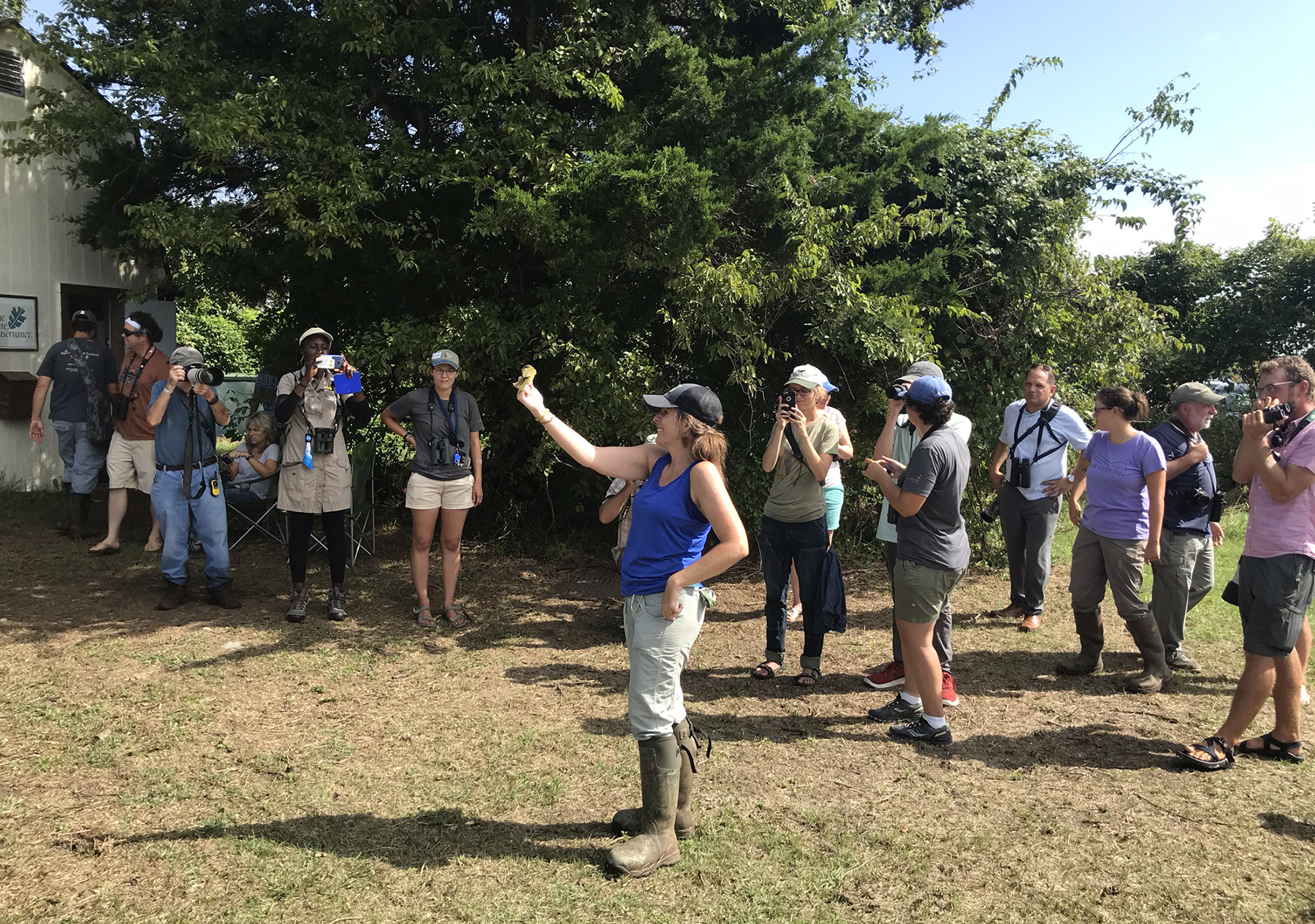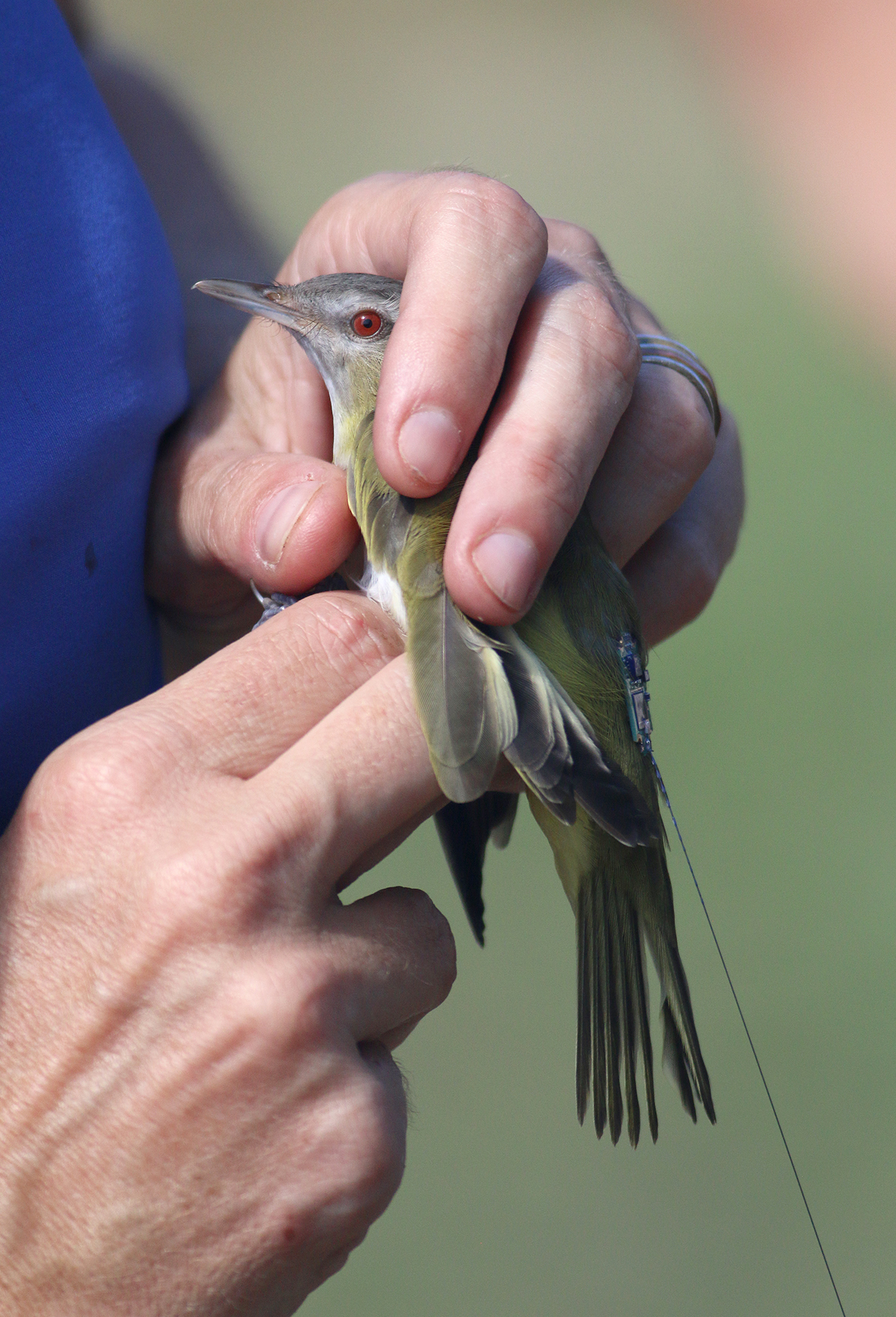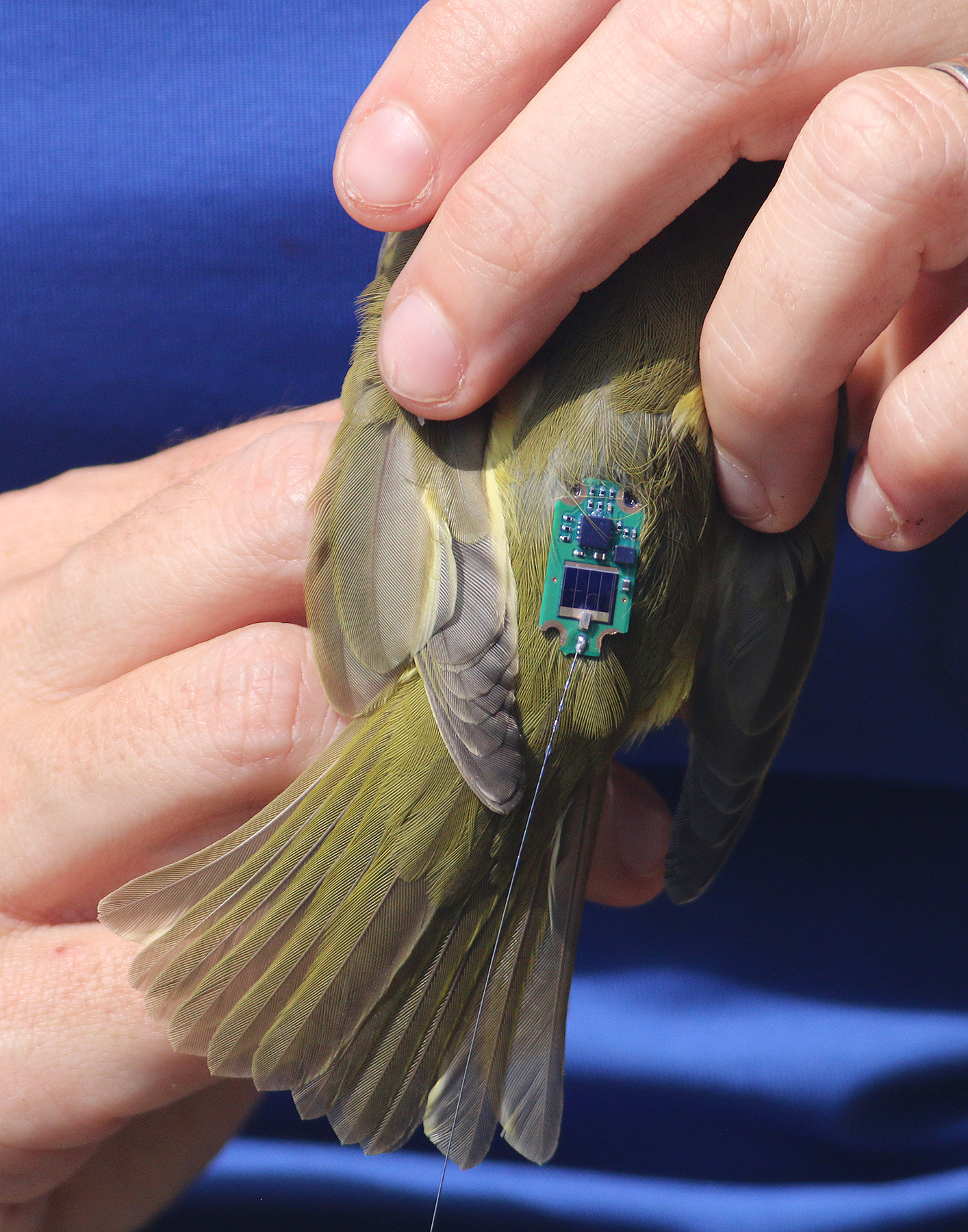Warblers are starting to arrive here in the northeast, with Pine Warblers singing on territories and Yellow-throated Warblers appearing. Prothonotaries and Louisiana Waterthrushes and Palms and Black-and-white Warblers will be arriving next. Are you ready for them?? If not, brush up using our Warbler BirdQuiz by clicking here.
The final portion of our trip moved north of LA into the Santa Barbara area. Our goal here shifted somewhat, from just finding good overall birding areas, towards looking for rarities with other species as bonuses. Our first stop was Lake Piru Recreation Area, where we were hoping to spot California Condors. We had been watching reports from this location for the past week or two before starting our trip, as it seemed to be the most reliable southern location for condors. Apparently there was a dead cow in the area that the birds were feeding on (Was it was placed there intentionally? We don’t know.). But during our trip a report came out saying that the carcass was nearly gone, so we were desperately hoping that the condors would remain for us.
As background, it is perhaps worthwhile to realize how rare California Condors are. In 1982 there were only 23 California Condors left in the wild, so they were all captured and put into captive breeding programs. As of 2017, the total population was up to 463 birds, with 173 in captivity and 290 in the wild, in California (170), Arizona/Utah (82), and Baja MX (38).
We arrived at Lake Piru in early morning, assuming that they would take off on the thermals when the air started warming up. It wasn’t clear to us where they were being seen, so we just started birding, keeping a watchful eye on the clear blue sky. There was quite a bit of activity, but mostly due to the species that we now had grown accustomed to: Say’s and Black Phoebes, Cassin’s Kingbird, Audubon’s Warblers, Spotted Towhee, Lesser Goldfinch, Bewick’s Wren, Western Bluebird, California Scrub-jay, and Common Ravens. The first new bird for the trip was a flock of ~26 Lark Sparrows. We get Lark Sparrows in New Jersey in fall as vagrants, so seeing even one is normally a treat. Seeing 26 of them on the ground at once seemed like a dream. I assume that to California birders it is absolutely normal, but we enjoyed it thoroughly.
Our second new bird was a condor. After about 30 minutes or so of birding, Jeanine suggested that we just scan the trees near the rolling pasture at one end of the lake to see if we can spot any perched condors. I thought it was a longshot, but went along with the suggestion. Thankfully I was wrong again. Within five minutes we spotted two condors in adjacent trees. Like most condors, they are wing-tagged for identification purposes, and these were condors ‘blue 16’ and ‘blue 26’. They eventually flew into another tree maybe 300 yards away where they were joined by an immature bird that lacks the orange head of the adults. After watching the distant birds through the scope and attempting distant photos, the birds flew off and rode the thermals up the ridge and out of view. We soon decided to move on too, but on our way out of the park, I noticed what I thought were condors flying above us. Pete pulled off to the side of the road, and indeed, we had at least six condors flying directly above our car, rapidly gaining altitude. What a treat. There on that California hillside we were viewing ~2% of all the wild California Condors in the world.
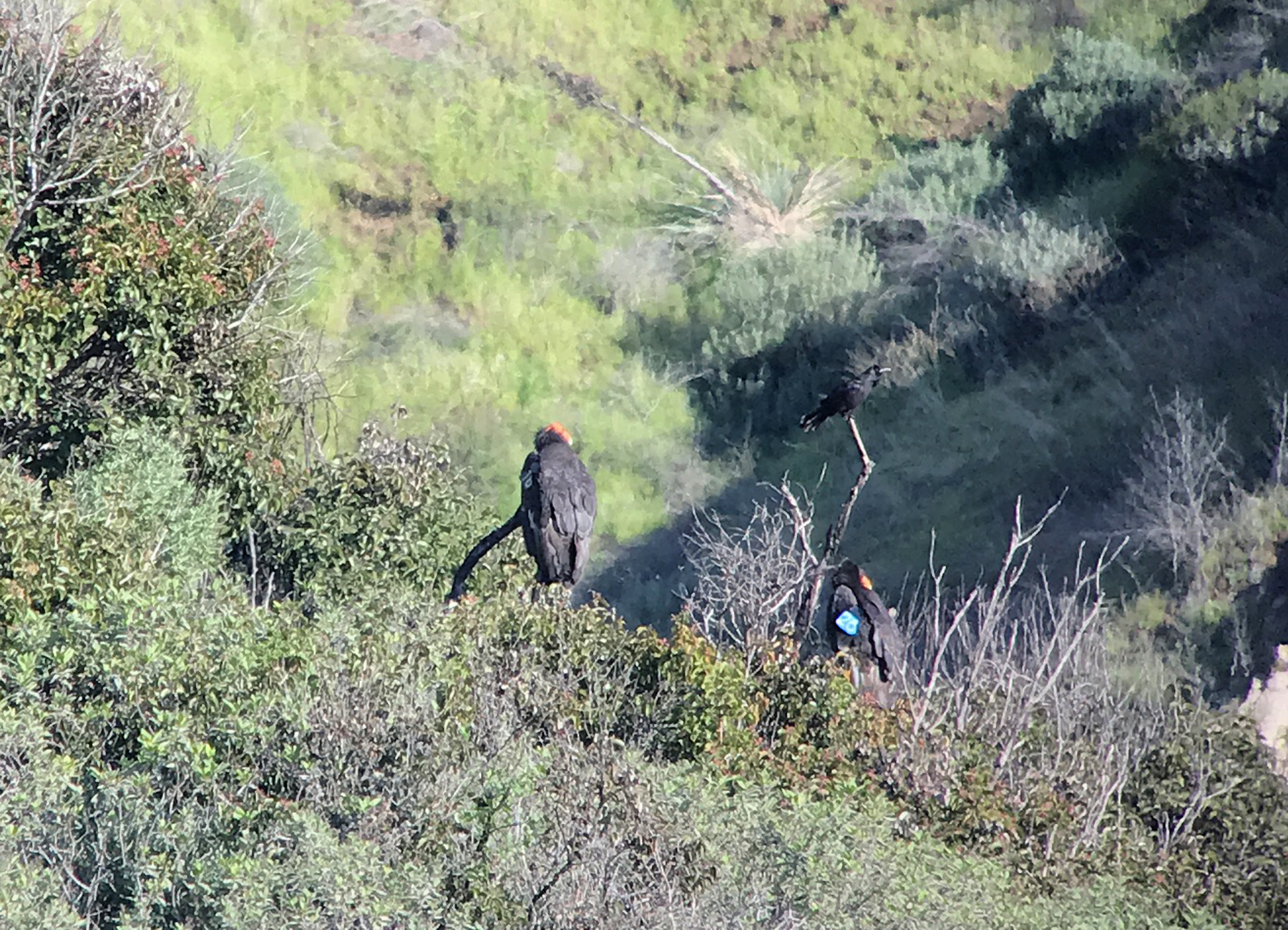
Our first view of two perched California Condors, with a Common Raven perched between them. The wing marker ‘blue 26’ can be seen on the rightmost bird.
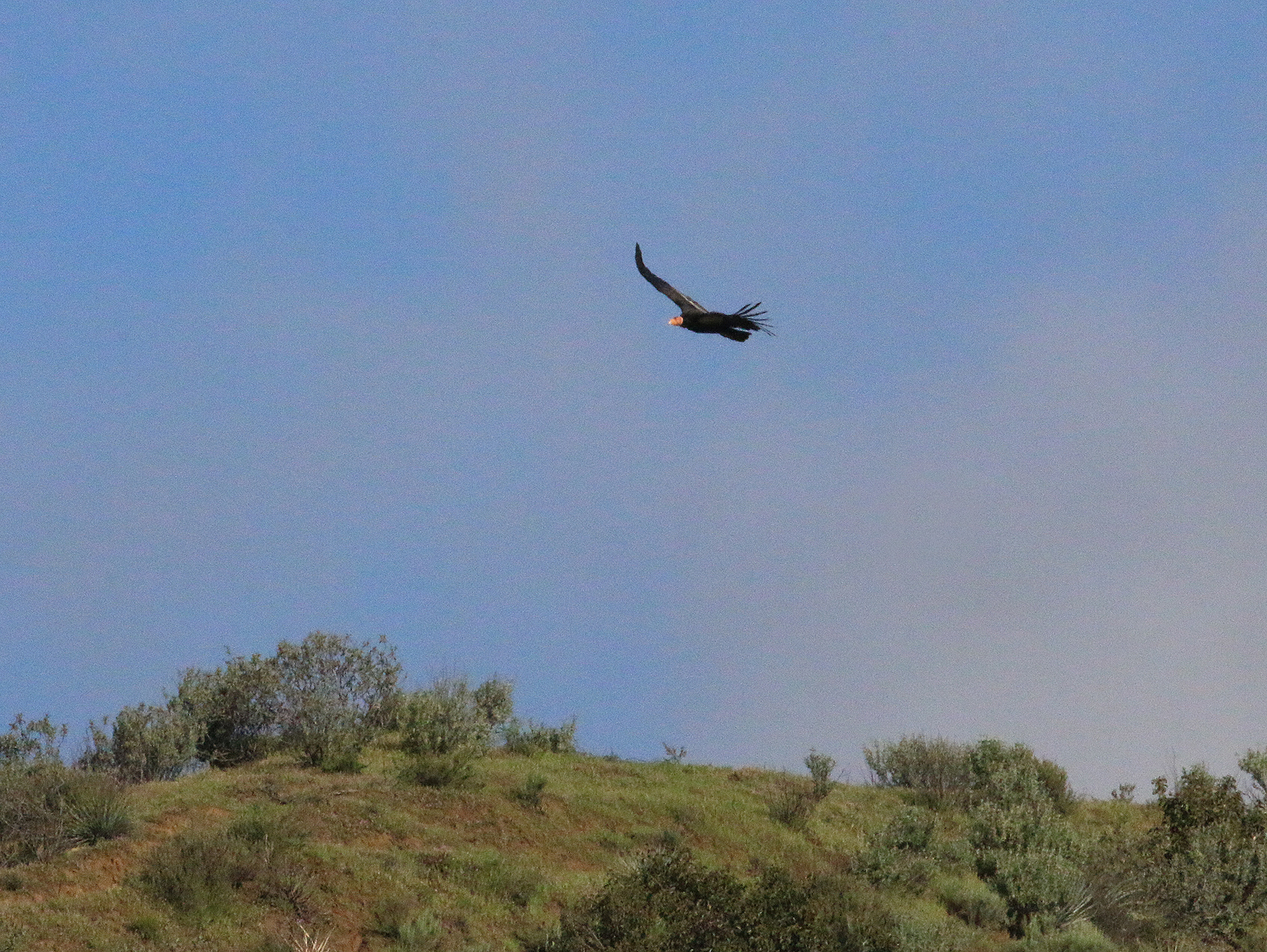
An adult California Condor soaring over the California countryside. If it weren’t for the effort of the past few decades to revive this species, this sight would have been gone forever.
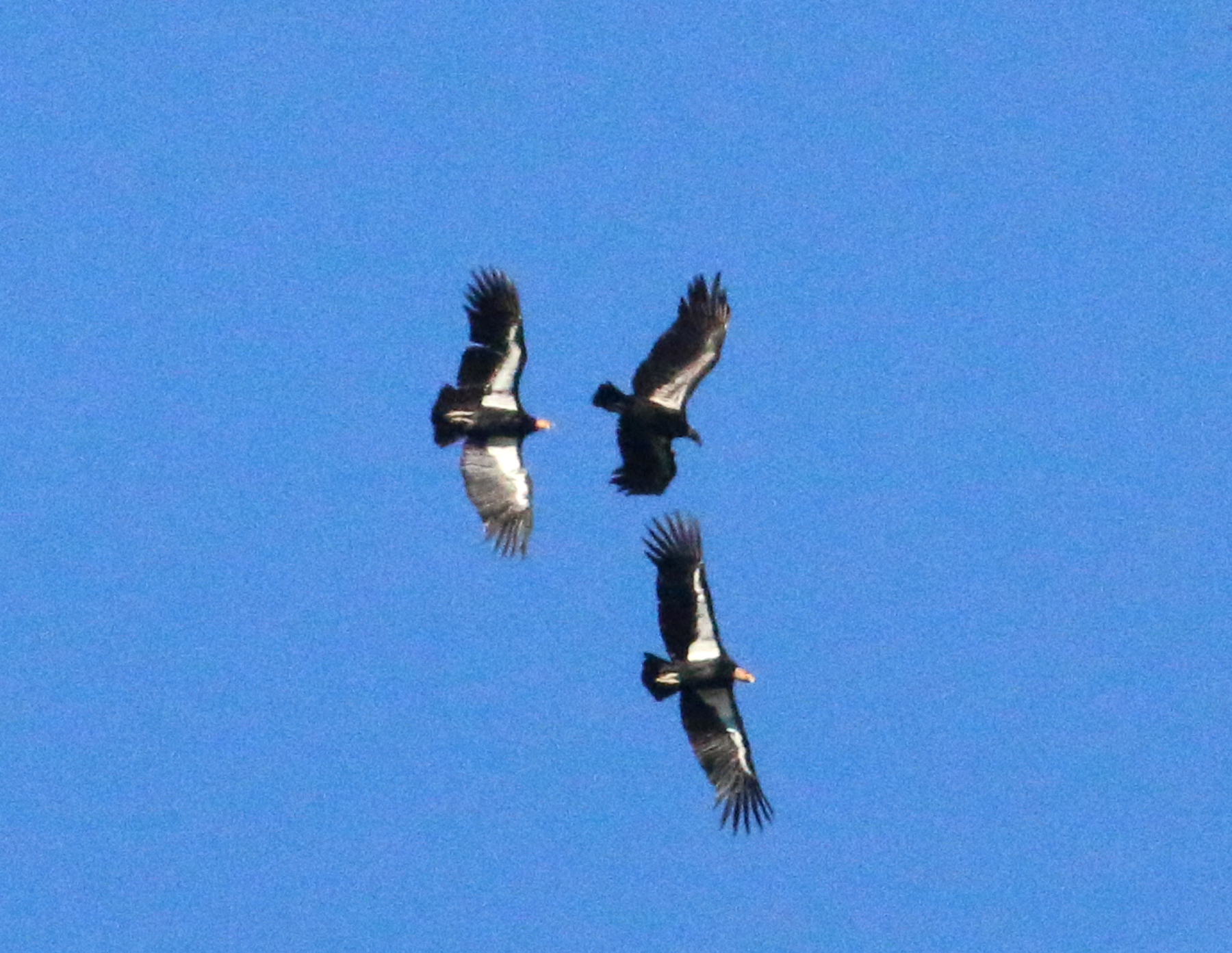
Three California Condors circling the ridge above our car at Lake Piru. The one with the black head is an immature bird. These birds have a 9 ft wingspan (compared to ‘just’ 5 1/2 ft. for a Turkey Vulture) Wow. Just wow.
Our next stop was north of Santa Barbara to the rolling hillsides in search of Yellow-billed Magpies. This is the southern-most end of the range for this species, which is one of the 18 or so birds that are endemic to the United States. In fact, it is found only in California. Moreover, this is a ‘good’ endemic, in the sense that it is morphologically distinct from any other species and not one of those ‘split’ species that are not possible to distinguish unless they are in your hand and measured. They had been seen the general area near the intersection of two nearly deserted roads: Alisos Rd. and Happy Canyon Rd. (Happy Canyon…a portent of good things to come?). Well, we drove those roads nearly a mile in each direction from that intersection with no luck. We couldn’t have missed them, could we? After all, the habitat is wide open and they are a large and showy and social species…pretty much a ‘can’t miss’ bird. Or so we thought. So should we move on to a different location, or try again? Being stubborn (or should I say ‘persistent’?) birders, we drove back again, and this time Jeanine spotted a pair flying across a pasture only to disappear into thick trees surrounding a roadside ranch house. I always feel odd pointing my binoculars anywhere near a house, so we drove on, and this time hit the motherload, with Jeanine again spotting more, but this time a group of seven or so feeding mostly on the ground just ahead of our car. We waited patiently, and the birds kept strolling past the car and into good light for a few photos. When they flew up into the roadside oak they seemingly disappeared even though there were no leaves on the tree. That made for a great day, with the rarest species in North America and an endemic within a few hours of each other.

Here’s an example of the lovely Yellow-billed Magpie country. We drove along these kinds of roads scanning the fields and the bare oaks for magpies. Photo by Jeanine Apgar.
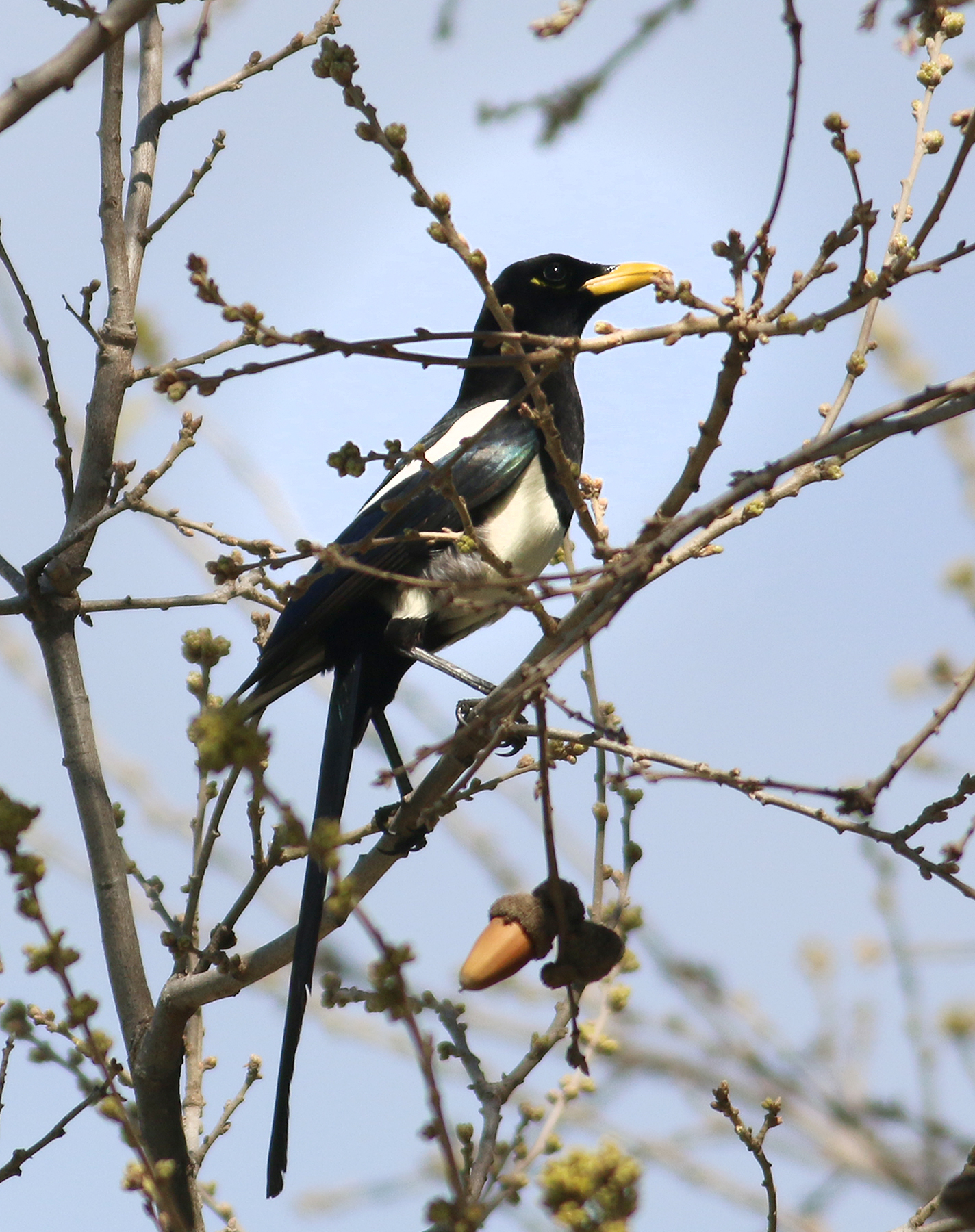
Yellow-billed Magpie in an oak tree, showing its elongated tail. It was surprising how tough it was for us to spot them in this tree despite the lack of leaves.
The following day we went in search of our next US endemic, taking the boat trip to Channel Islands National Park in search of Island Scrub-jays. Good fortune was on our side on this trip, as it was supposed to be raining through most of the day, but it didn’t rain until our boat docked at the end of the day. Seriously. Amazing timing! On the trip out to Santa Cruz Island we tried pelagic birding, spotting some Pacific Loons (another species that we see in small numbers in NJ), Cassin’s Auklets (which were tough for us to identify), and near the island the more obvious Pigeon Guillemots with their large white wing patch. Since this island is the only place in the world to see Island Scrub-jays, the pressure was on, but within five minutes or so of beginning our hike, Pete spotted a distant one in a bare tree. Whew. With the pressure off, now we could enjoy the walk. We ended up seeing at least four more, with much better views, along with a super displaying Spotted Towhee while enjoying lunch.
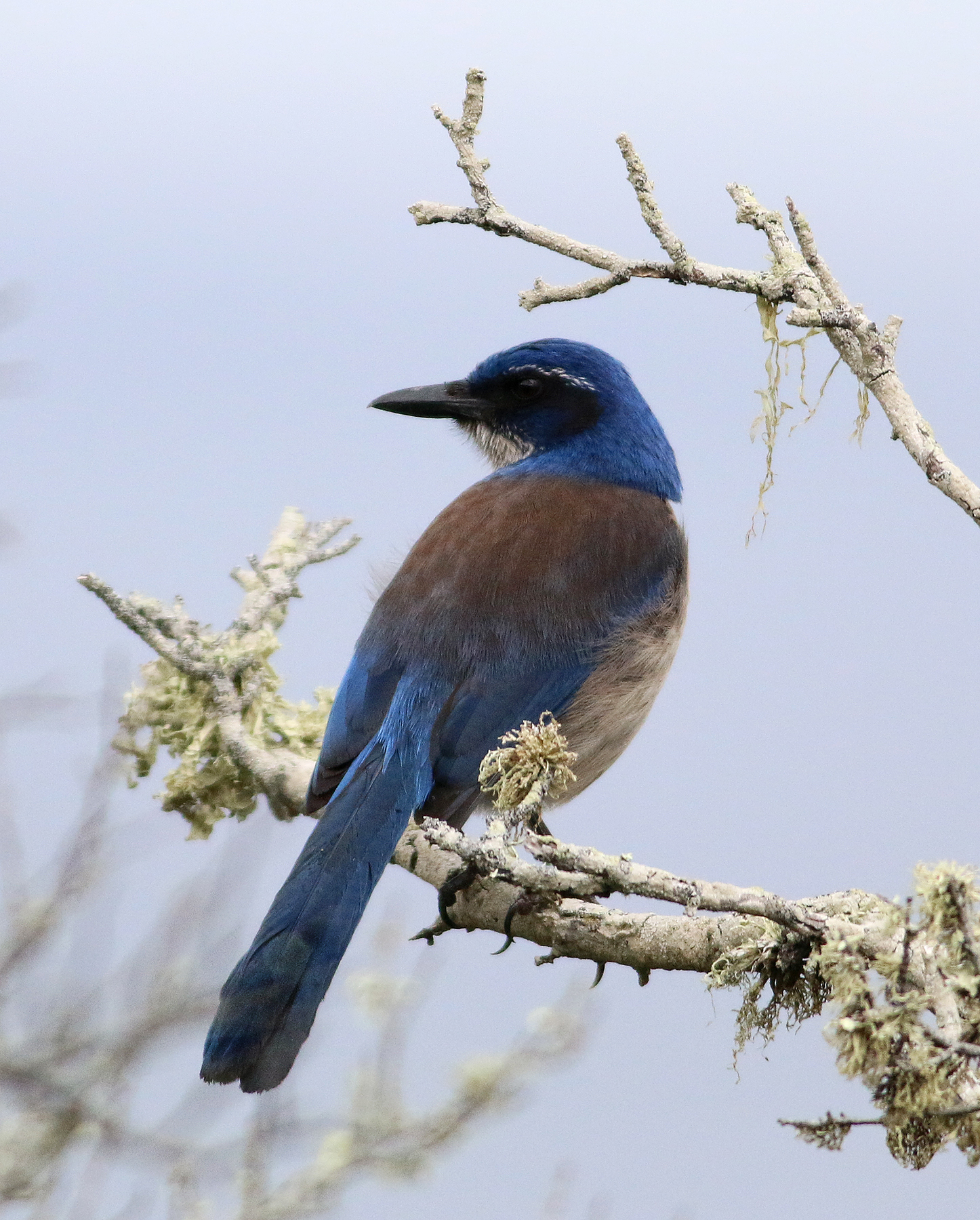
Here’s a classic cooperative Island Scrub-jay. They are distinguished from the similar California Scrub-jay by having a blacker facial mask and a cap that is darker blue.
Thus ended our birding tour of southern California. Can I make any recommendations to others going there for the first time? First of all, although we explored only a small section of California, for the trip that I described in these blog entries, it is still quite a large area to cover in ten days. If we were doing it again, I’d spend 12-to-14 days to cover the same area and feel less rushed. Some birders consider the Salton Sea a ‘must ‘ stop for any southern California tour. We could have opted for going to the Salton Sea instead of trying for the rarities (condor, magpie, and scrub-jay), but those are three five-star species, so I feel it was worth it in the end, but that is a matter of personal choice. With regard to the timing, we arrived before the peak of migration, so we could have found more western species (tanagers, vireos, orioles, terns, etc.) if we traveled in April or May, but part of our goal was simply to escape the cold and relatively birdless March in New Jersey, so for us it was good timing. (And yes, it did snow in NJ while we were away.) For the entire trip we ended with 156 species seen, with 36 new lifers for Jeanine and 12 for me. Although those numbers would pale in comparison to more exotic locations in South America, that is pretty darn good for a US destination. So give it a shot and enjoy. Contact me (greg@birdquiz.net) if you have any question or comments.
A remarkable thing about birding in southern California is how quickly you can be in completely different habitats. After 2 1/2 days in San Diego, we literally left the beach and just one hour later found ourselves in the Laguna Mountains, hoping to find some higher altitude species. We stayed overnight in a town called Pine Mountain (3,700 ft elevation) and woke up the following morning to a light fog that unfortunately became more dense as we drove up to higher altitudes, forcing a change in plans. The fog was likely due to the unseasonable snowstorm that they received the previous week, coating the ground outside of town in 6 inches of snow and resulting in some road closures in one of our destinations, Cuyamaca Rancho State Park.
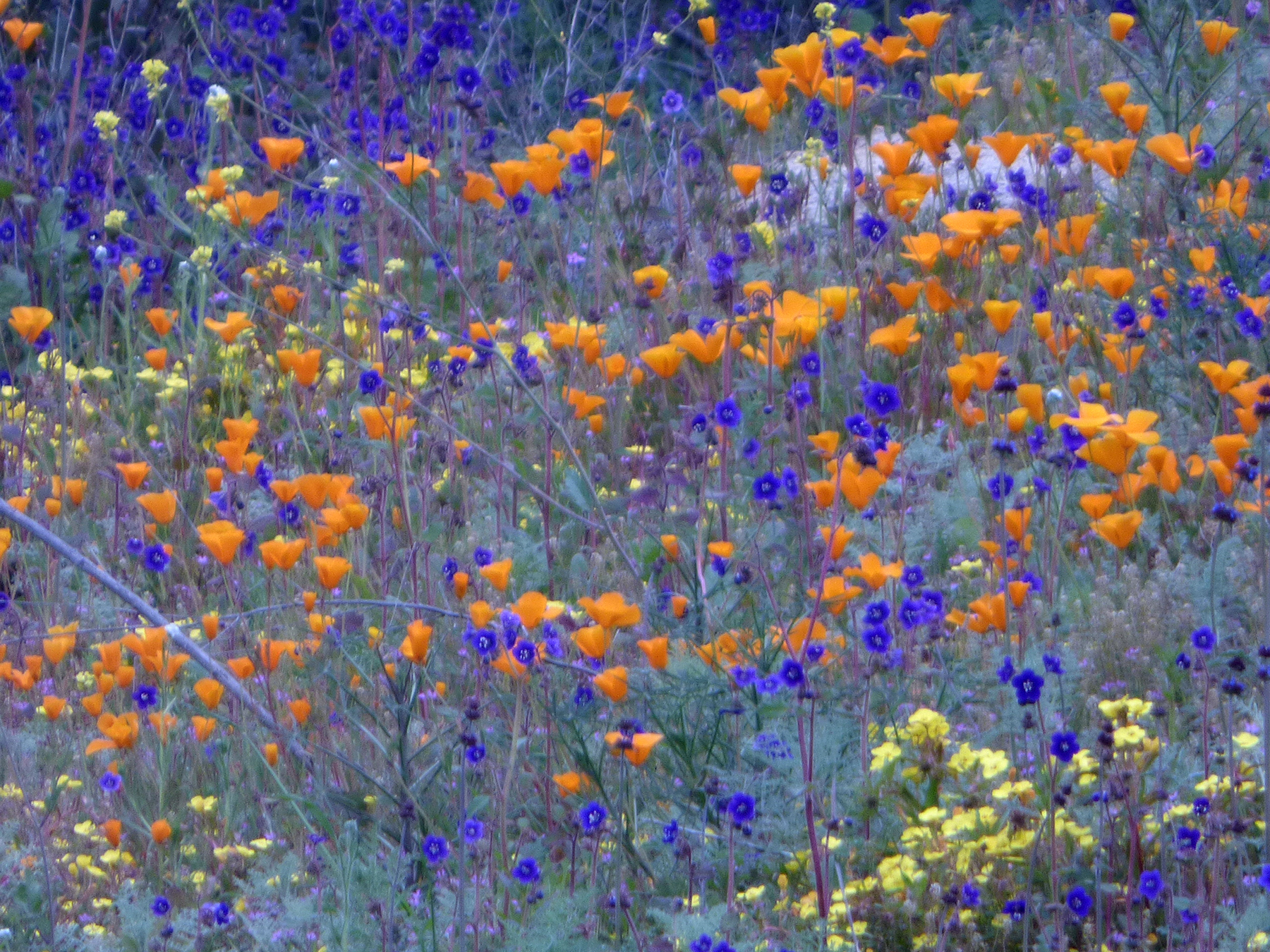
Wildflowers were blooming in colorful clusters in the foothills outside of San Diego. Photo by Jeanine Apgar.
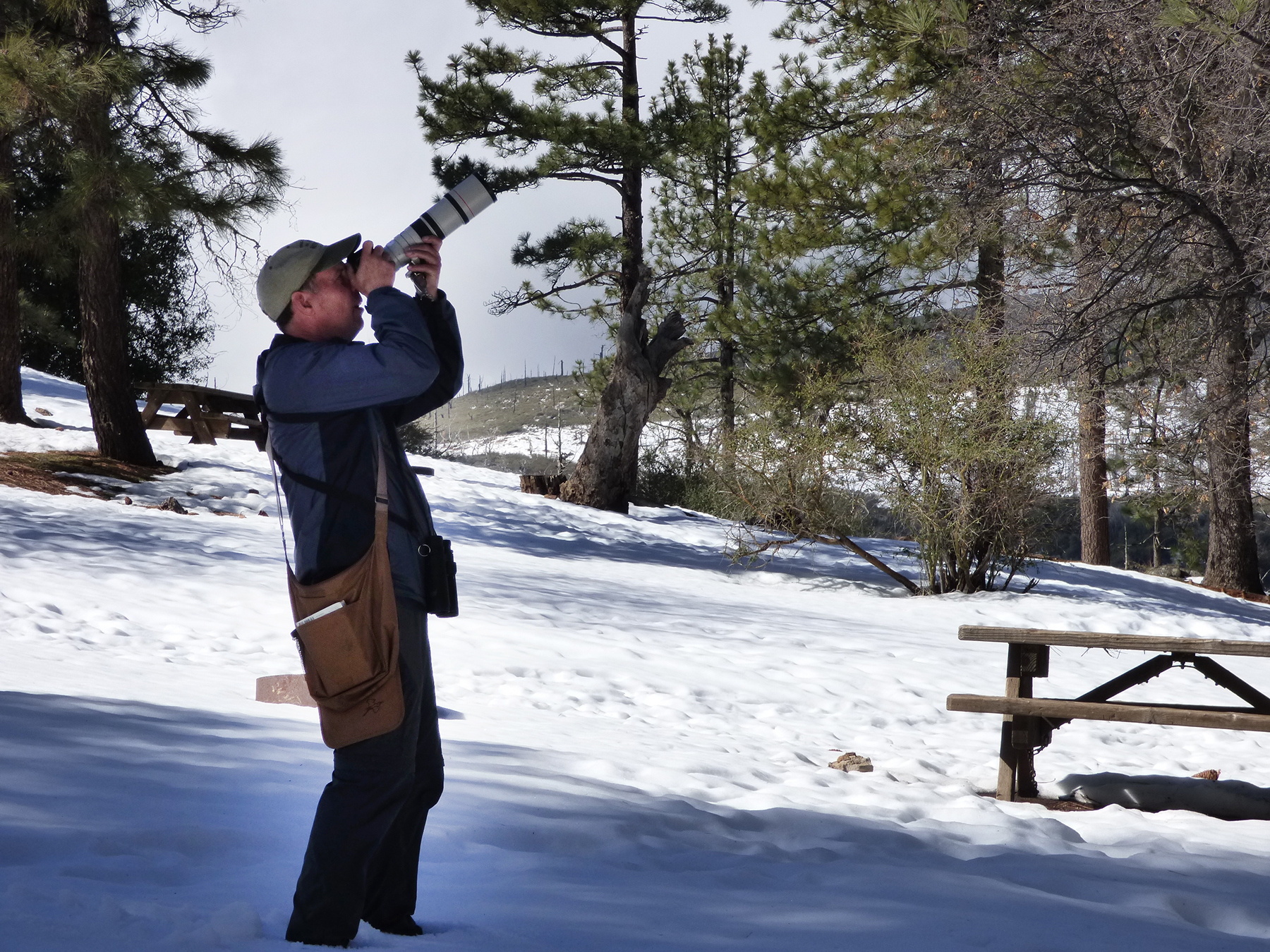
Just an hour drive eastward after we were strolling barefoot on the beach we were in mountain habitat with 4-6 inches of snow. Photo by Jeanine Apgar.
We made the best of the situation, and ultimately found most of our expected targets. In the town park we found our first Acorn Woodpeckers of the trip, and being a sociable species, a single oak hosted nearly a dozen of these distinctive birds. Dark-eyed Juncos were feeding on the ground, but for a nice change they were of the Oregon race, unlike the Slate-colored sub-species that we left behind in New Jersey. Groups of Band-tailed Pigeons flew above the pines, and a Bewick’s Wren and Steller’s Jay joined the group.
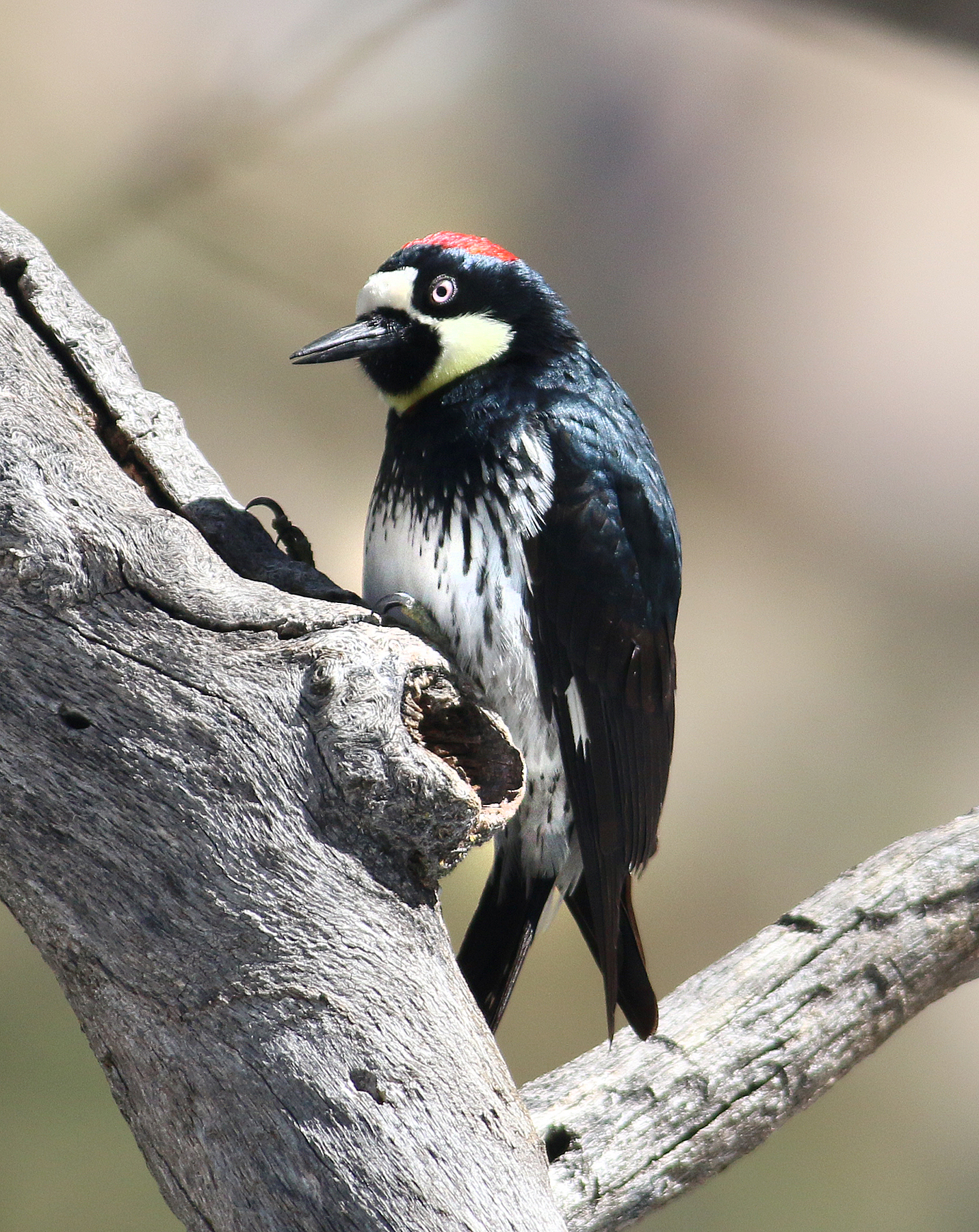
Acorn Woodpeckers were found in several types of habitats, and when you found one, you were sure to find more. They are very sociable.

The Oregon sub-species of junco was a slightly more colorful change from our eastern Slate-colored Juncos.
In Cuyamaca Rancho Park the trails were difficult to walk due to the snowcover, so we focused on the cleared roads in Paso Picacho Campground (5,000 ft). The Ponderosa Pines here were FILLED with Acorn Woodpeckers and their acorn stashes, but we had other birds in mind. We started with a brilliant Red-breasted Sapsucker, and then started finding species that replace our familiar eastern mixed-flock birds. In southern NJ we have Yellow-shafted Flicker, Carolina Chickadees, Tufted Titmouse, and White-breasted Nuthatch, but up here they were replaced with Red-shafted Flicker, Mountain Chickadees, Oak Titmouse, and Pygmy Nuthatch. (to be more accurate, both White-breasted and Pygmy Nuthatches were present, so it wasn’t a true nuthatch ‘replacement’).
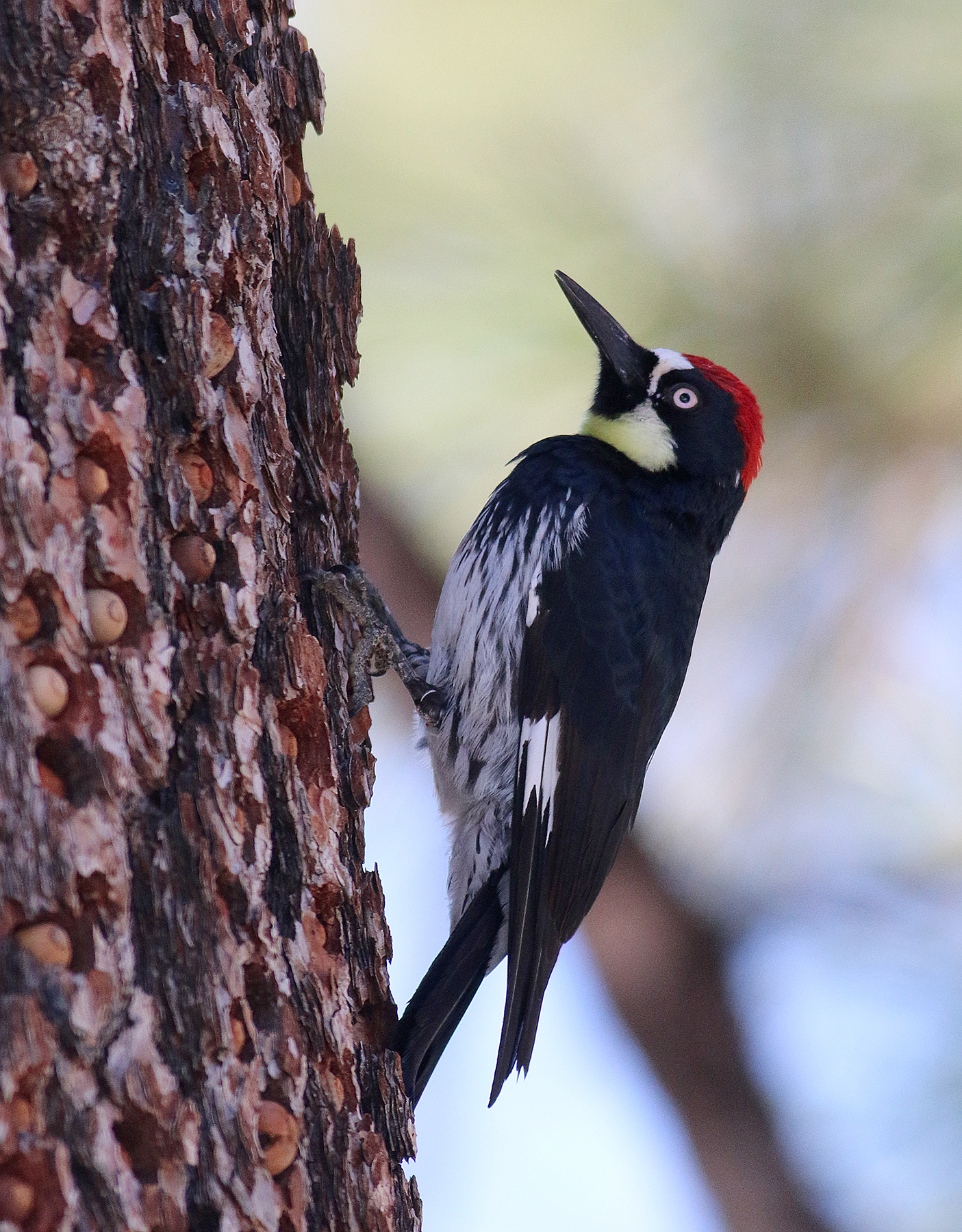
The Acorn Woodpeckers stash acorns in the Ponderosa Pine bark, as can be seen here. Some of the Ponderosas were just filled with acorns.

Oak Titmouse was seen in the mountains, desert, and foothills, but our first one was found in the higher altitude of Rancho Cuyamaca.
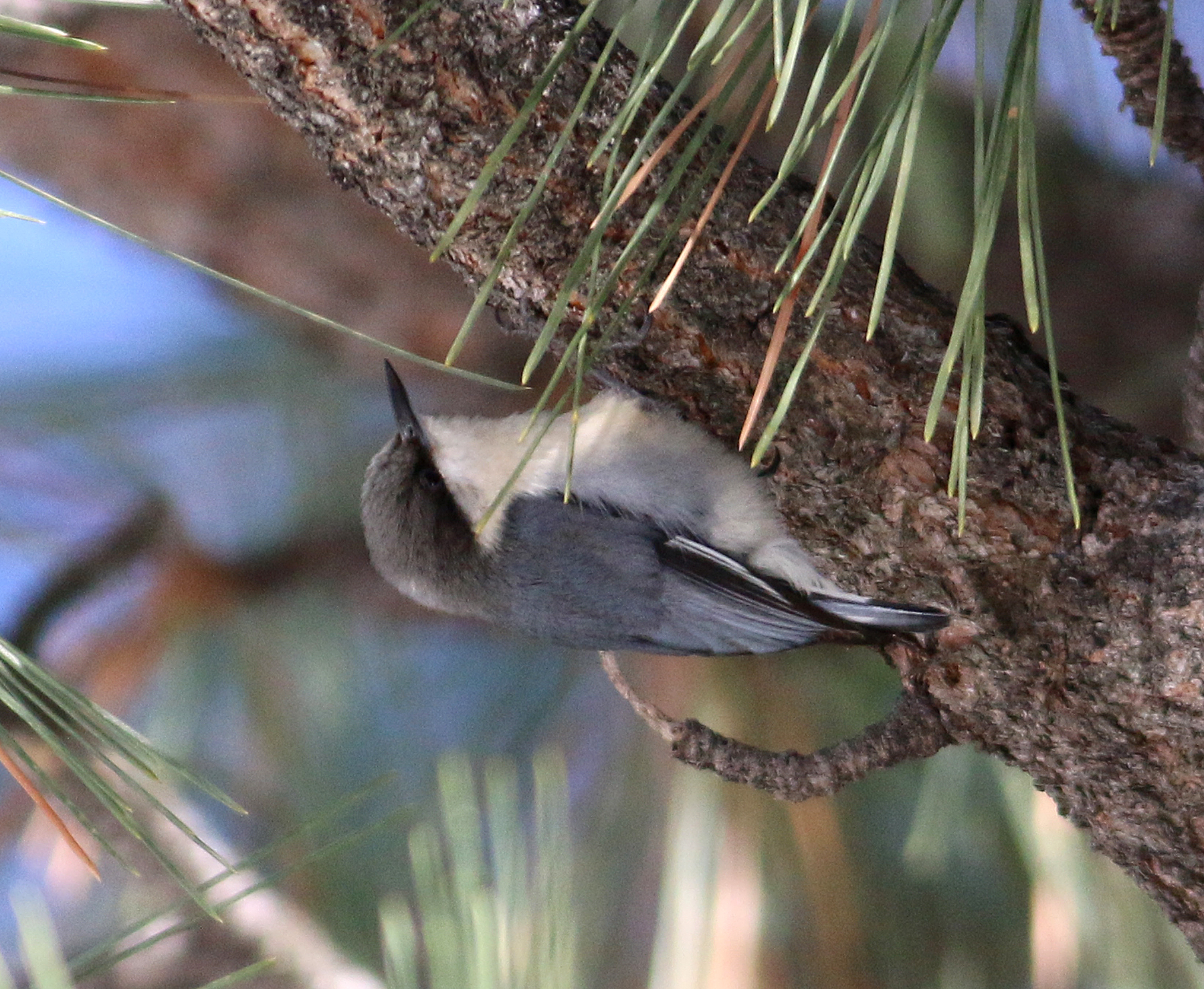
We struggled to find Pygmy Nuthatch, but when we did find them, they were in a group of about six birds working a single pine.
Driving downhill from Cuyamaca Rancho towards the desert we spied our first Phainopepla of the trip. Upon arrival in Borrego Springs we took a break in the desert warmth with a short walk around the Anza-Borrego State Park Visitor’s Center followed by a dip in the motel pool. A lone Verdin was our first introduction to the desert species that we would see over the next three days. For part three of the Southern California tour, click here.
March is a tough time of year for me to be in New Jersey. By this time of the year I’ve seen most of the winter birds, it has been cold for far too many months, and spring seems to take its sweet old time arriving. For these reasons I like taking birding vacations during this time of year, especially to a warmer climate to escape the lingering NJ winter. This year my friends Pete and Jeanine joined me for a 10-day trip to southern California, birding from San Diego up to Santa Barbara. This part of California has the advantage that different habitats, ranging from seaside to foothill scrub to mountains and deserts, occur within a relatively short distance. So we drew up a list of target species and set out to take advantage of those diverse habitats.
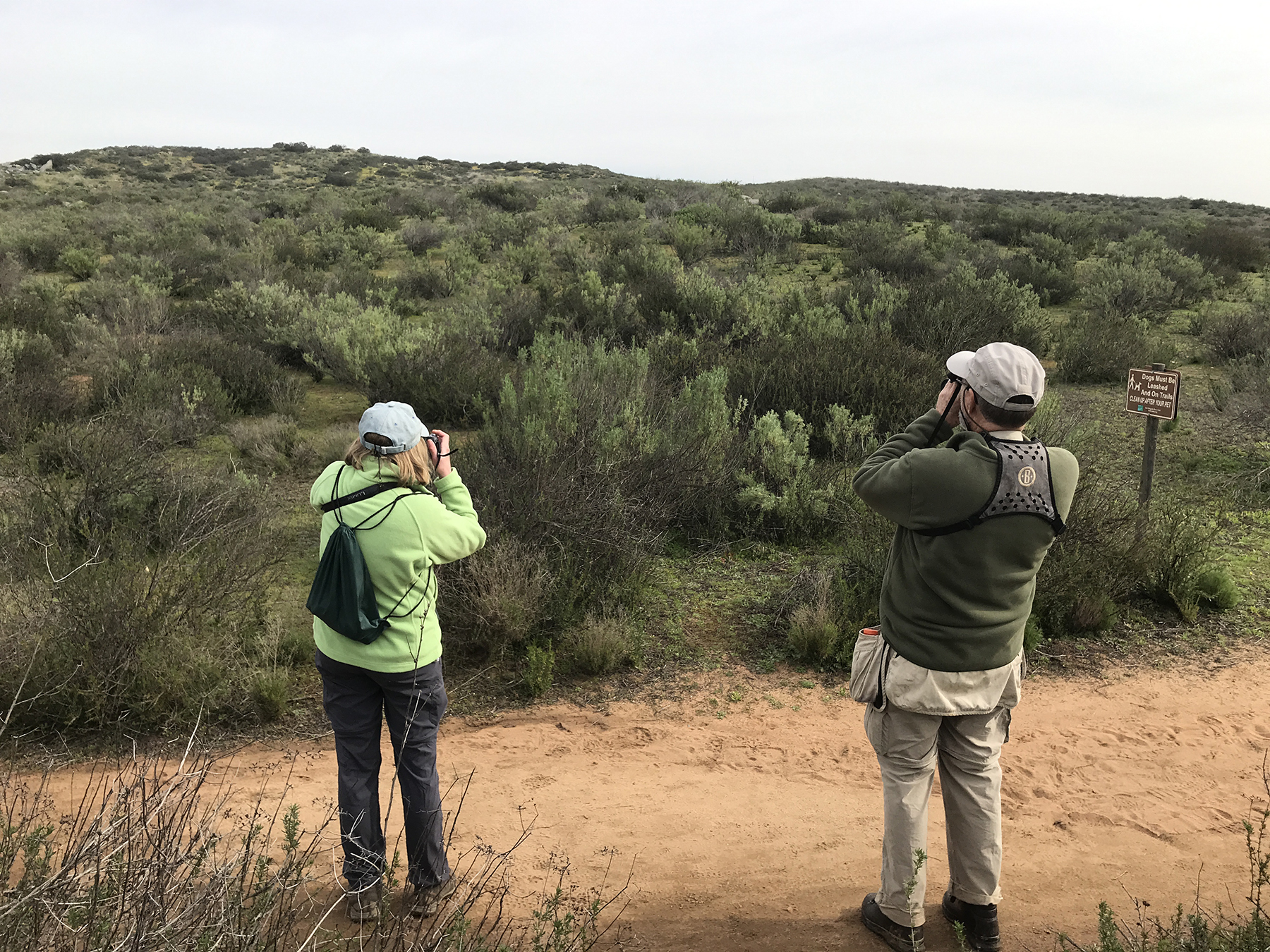
Pete and Jeanine scanning the coastal scrub habitat alongside Lake Hodges. You won’t get ‘warbler neck’ when birding here.

A coyote was also birdwatching in the scrub at Lake Hodges. Probably looking for that pesky Roadrunner.
We enjoyed two full days exploring the coastal scrub habitat in the San Diego area, especially Lake Hodges, located just 21 miles north of downtown San Diego (but still within the San Diego city limits). Before we even left the parking lot we were already enjoying species that we don’t see back home, with Western Bluebird, Black Phoebe, Nuttall’s Woodpecker, and Townsend Warbler. The scrub was filled with other species that soon would become familiar to us: Cassin’s Kingbird, Say’s Phoebe, Greater Roadrunner, California Towhee, and Bushtit. The lake hosted several ducks that we were familiar with from birding in the east, but also held dozens of Western Grebes and at least one Clark’s Grebe. Amazingly, some of the grebes were performing their mating dance ritual, which was A-MAZING to behold in person. Click here to see an example of the grebe display from the BBC.
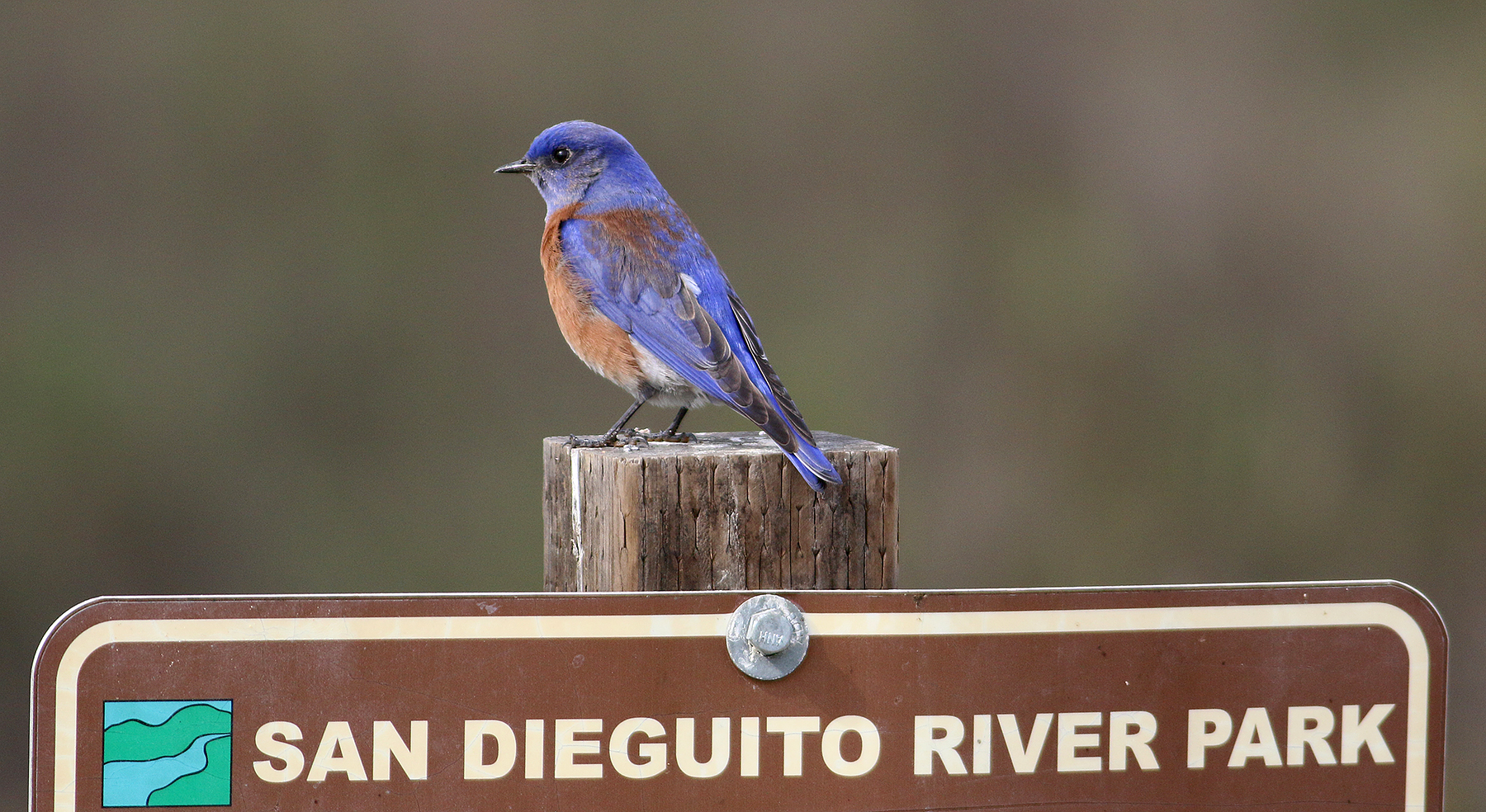
Western Bluebirds were common on this trip. I’m trying to remember….where was this one photographed?
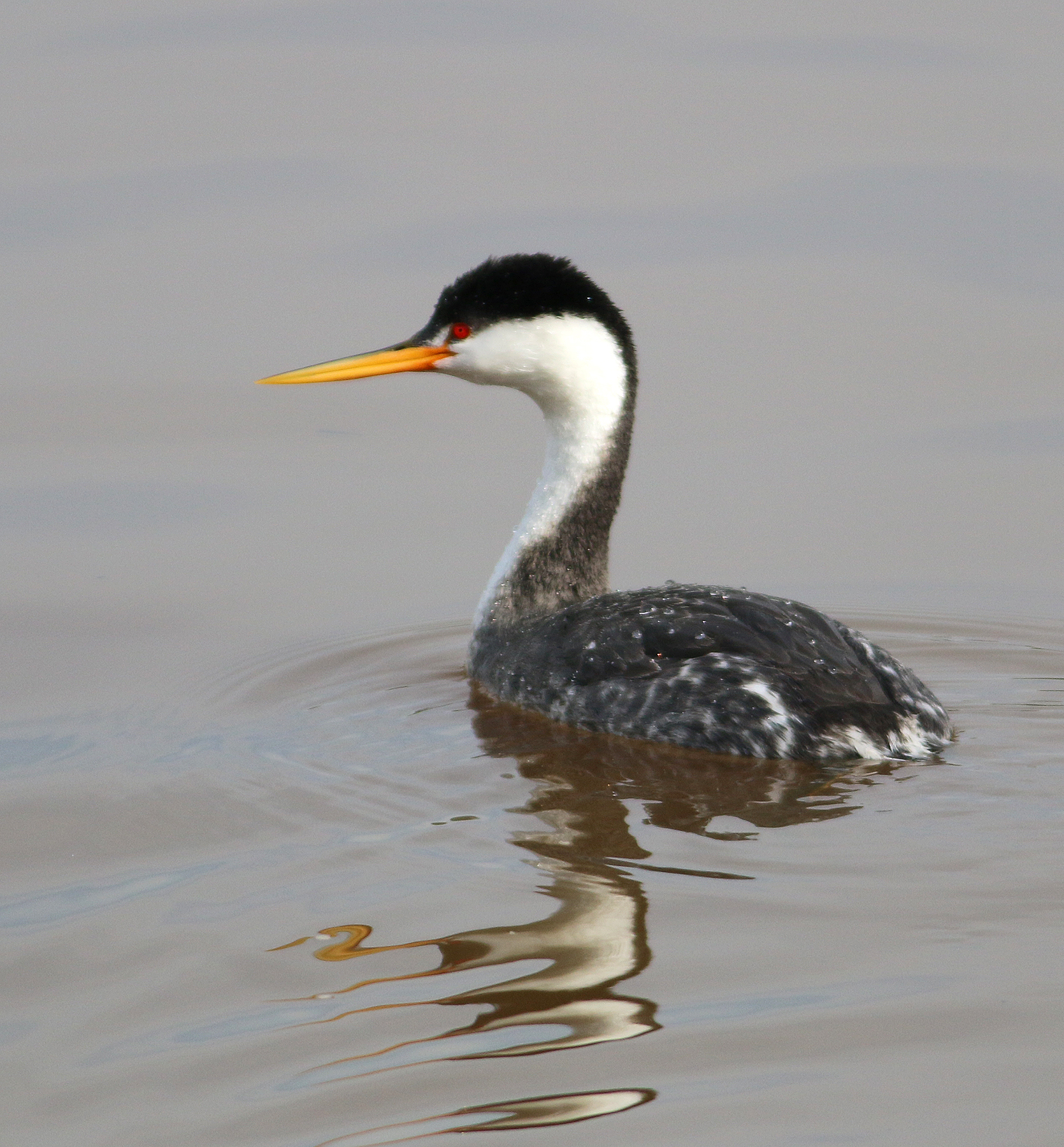
A Clark’s Grebe in non-breeding plumage at Lake Hodges. Note the partial black area by the eye. They were outnumbered by Western Grebes in a ~50-to-1 ratio.
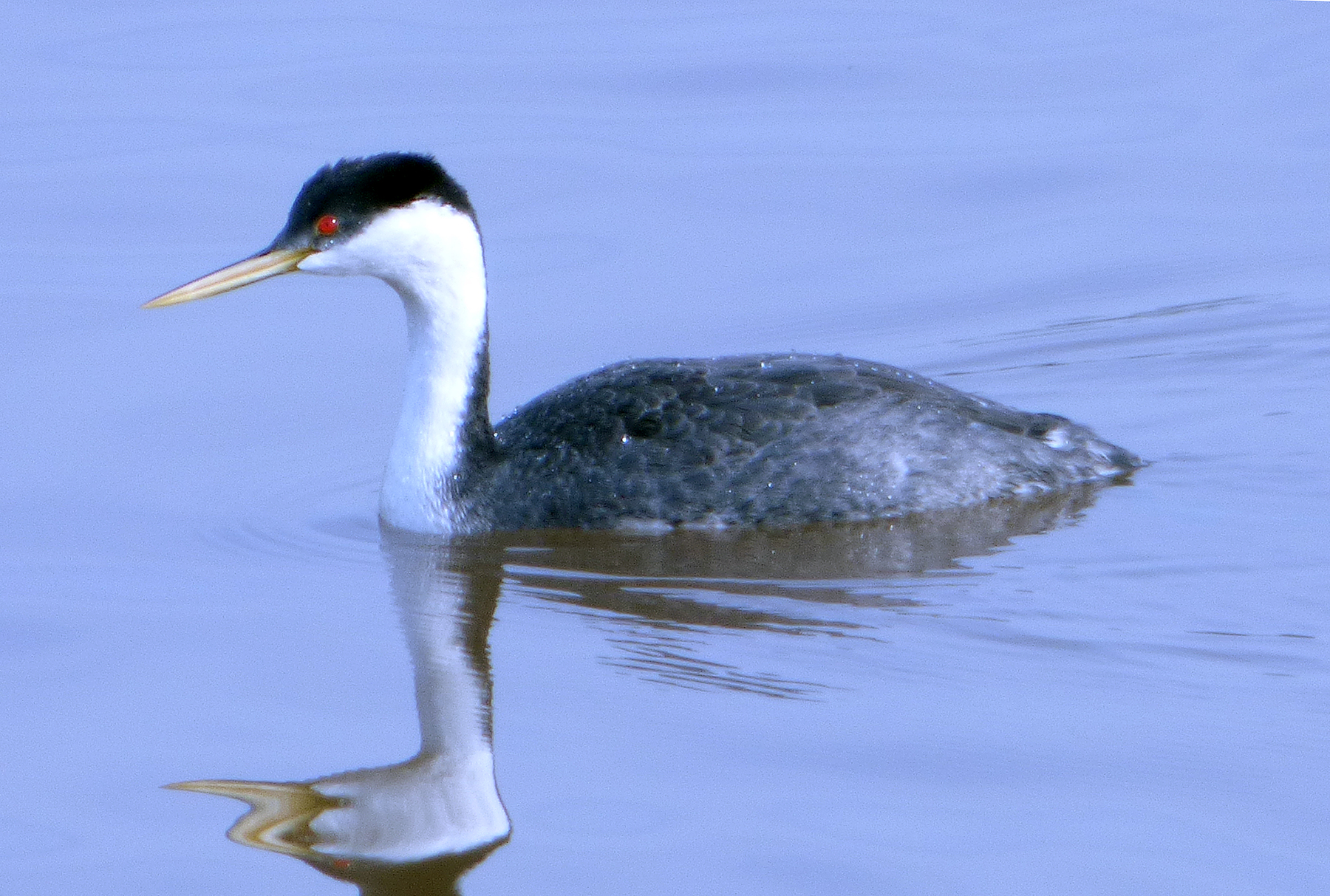
Here’s one of the more common Western Grebes for comparison. Note the eye completely surrounded by black, the olive-toned bill and the darker body plumage. Photo by Jeanine Apgar.
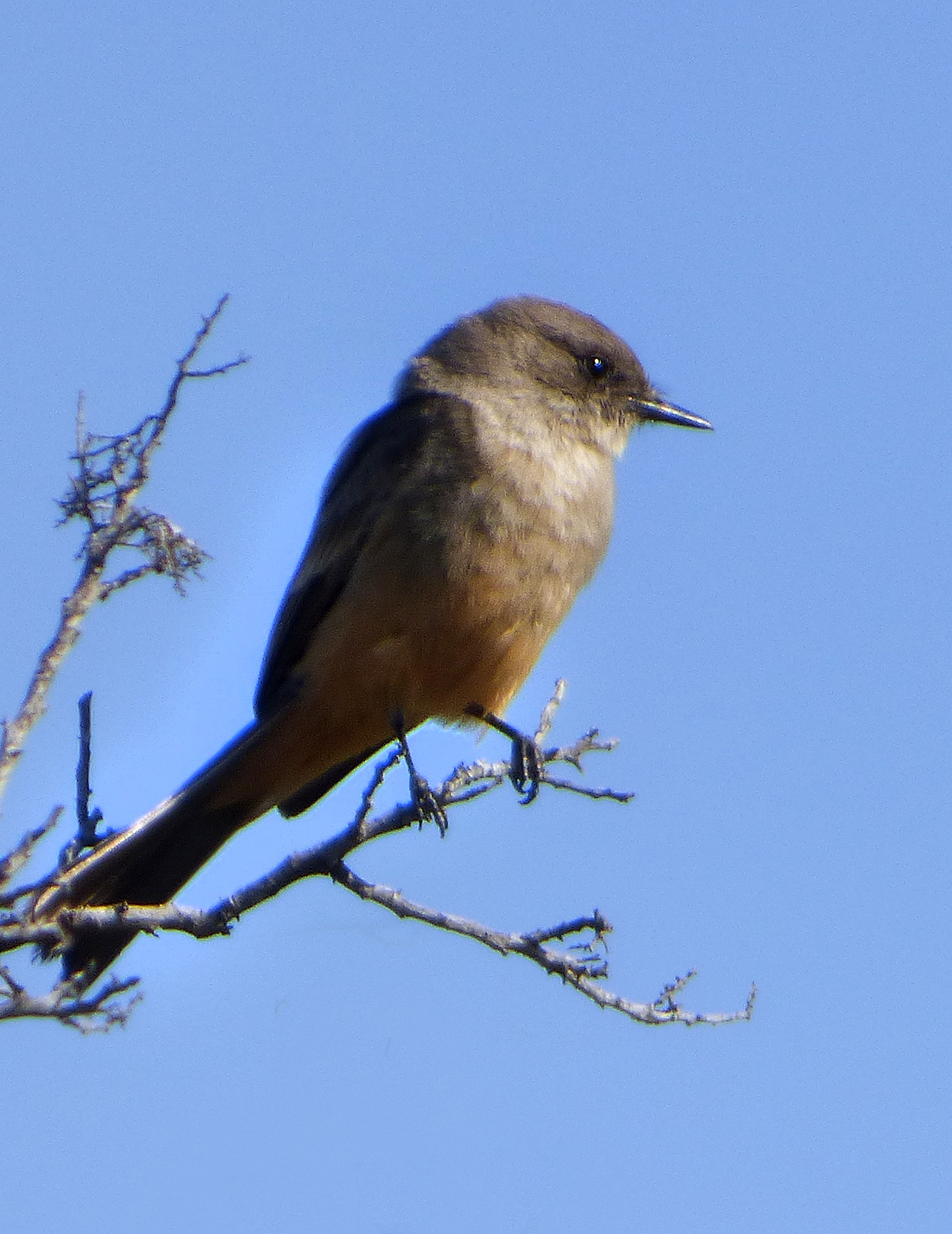
Say’s Phoebes would become a familiar sight on this trip, often in the same habitat as Black Phoebes. Photo by Jeanine Apgar.
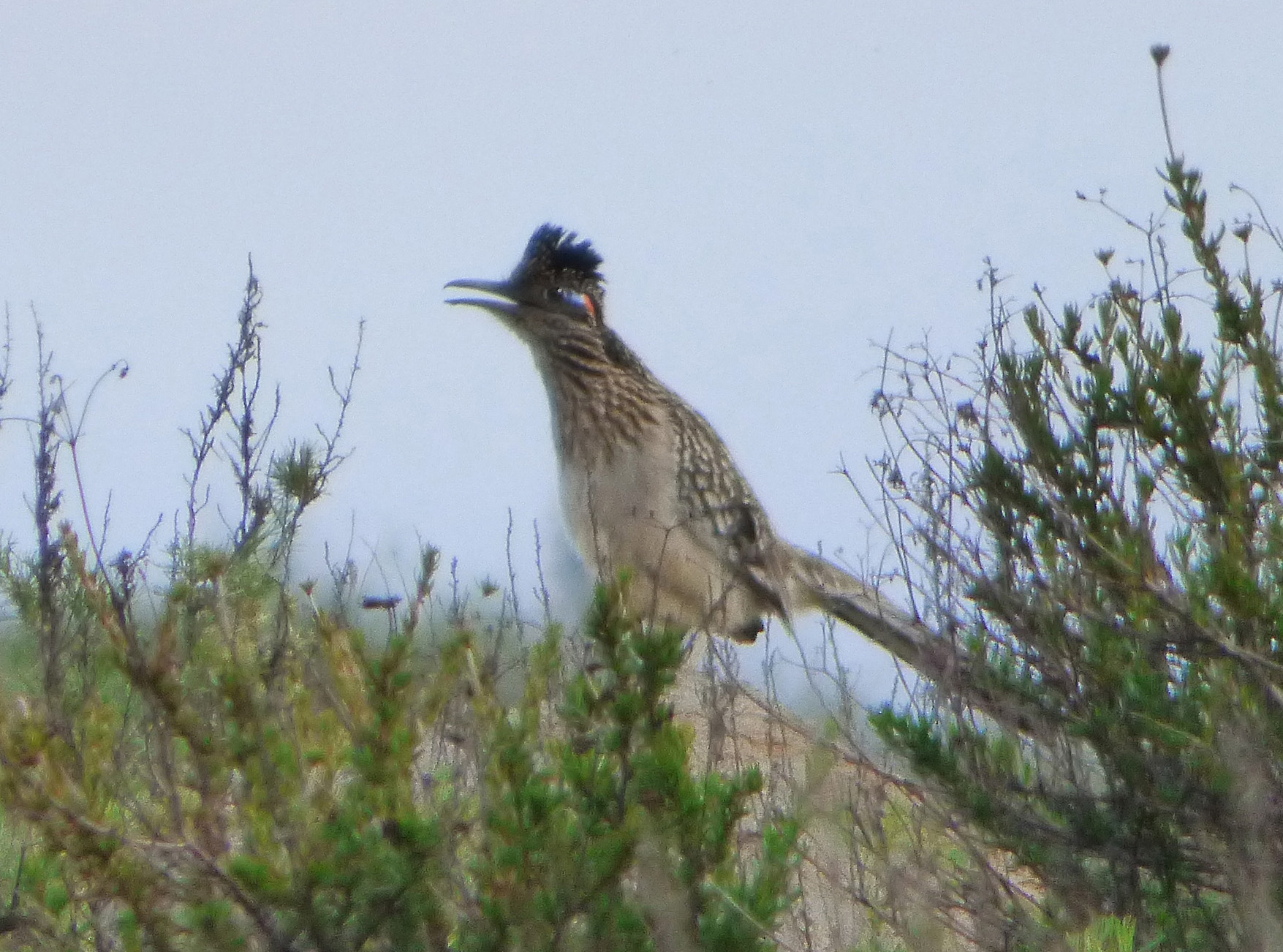
Yes, we did see a couple Greater Roadrunners, including this one near Lake Hodges that eluded the coyote. Meep-meep. Photo by Jeanine Apgar.
Two of our new lifer target species were also found at Lake Hodges: California Gnatcatcher and California Thrasher. The thrasher is even larger than our eastern Brown Thrasher. Luckily, they were singing loudly, and as expected they were doing so from the top of the trees, giving excellent views. My final landbird lifer from the SD scrub was a secretive Wrentit that Jeanine found deep in the brush at Tecolote Canyon the following morning.
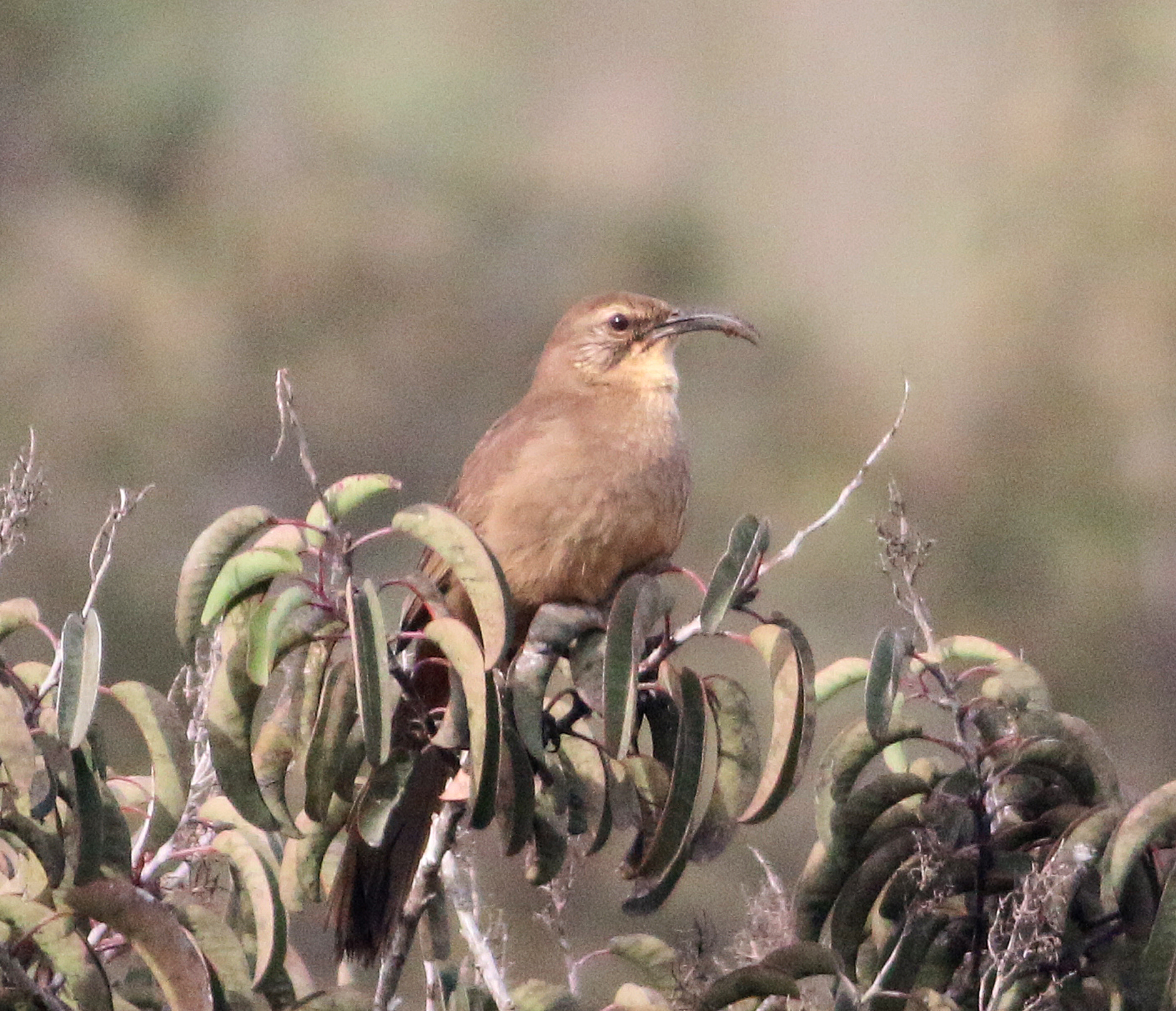
A California Thrasher taking a break from singing up a storm. That is quite a remarkable bill, isn’t it?
The SD waterfront provides ample opportunities for viewing gulls, terns, and shorebirds that we don’t see on the east coast. La Jolla Cove is a photographer’s dream, where we enjoyed impeccable views of Western, California, and the delightful Heermann’s Gulls among the nesting Brandt’s Cormorants. Both Brown Pelicans and American White Pelicans frequently patrolled the coastal waters. Western shorebirds such as Black Turnstone, Long-billed Curlew, Wandering Tattler, and Snowy Plover were all seen, although Black Oystercatcher and Surfbird eluded us.

I hereby nominate Heermann’s Gull as the handsomest gull in North America. This is exhibit A. I rest my case.

San Diego is not far from Tijuana Mexico. Here is part of ‘the wall’ that we hear so much about, visible from Tijuana River Valley Regional Park.
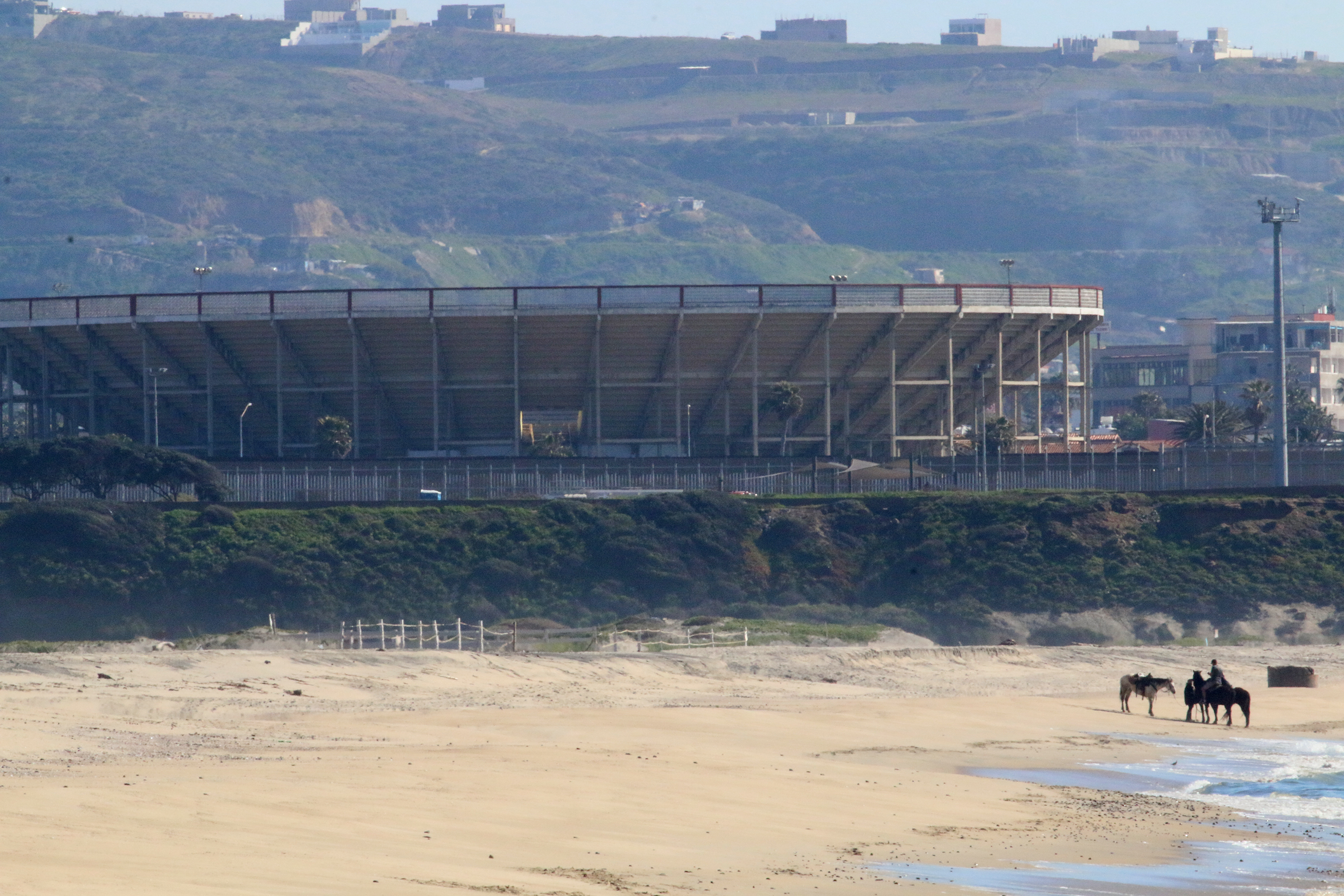
This is the bullring in Tijuana, just across the river mouth from where we were unsuccessfully searching for Pacific Golden-plover and Elegant Tern.

It helps when you know the locals who are tuned into the best places to eat. My good buddy Bri showed us the best Mexican restaurant in Ramona.
After 2 1/2 days of enjoying the birds and pleasant weather and Mexican food (best fish tacos ever!) of San Diego, it was time to move inland to the nearby mountains and deserts. Click here to continue on to that section.
In one of my recent posts I mentioned that it has been a wild winter for spotting Razorbills here in NJ. At the Avalon Seawatch near Cape May where they saw only three Razorbills the entire 2017 season and eleven the previous winter, thousands have been seen migrating by on individual days this year. Jeanine and I were fortunate to find one at Manasquan Inlet on January 1 (a very happy New Year’s present from the birding gods), and yesterday we returned back to Manasquan to see if we could spot any more, hopefully accompanied by some of its relative alcids (Dovekies, Murres, or Guillemots).

The end of Manasquan Jetty, south side. Unlike the longer (0.7 mi.), rougher, more risky boulder-strewn jetty at Barnegat Lighthouse, Manasquan Jetty (400 ft) is paved. And unfortunately, littered with graffiti now. The ease of access makes it very convenient.

It’s great when the Razorbills are so close that you can see the white vertical lines on their bill.
It was a perfect day for viewing. The seas were calm, with light westerly winds of 7 mph. It was completely overcast, but with a predicted high of 42 degrees. Perfect. We took our position at the end of the jetty and within the first hour or so spotted a single fairly close Razorbill and a group of two or three more distant ones too. (Question: is two birds officially a group? I digress with that petty technicality.) Then we spotted more further south, including a distant alcid that looked different enough that we decided to take the long walk on the sand to investigate further. When we arrived at that location, 0.5 mile to the south, we were ‘disappointed’ to find out that it was only another Razorbill. Accompanied by another.

It’s tough to see their eyes, because they are dark and superimposed on that dark black plumage, but we can see a well-lit eye here.
Instead of being satisfied with those results, being the ever-greedy birders we returned back to the jetty with renewed hope of finding different alcids, and were we ever glad that we did. Before we even reached the end of the jetty, Jeanine spotted two Razoriblls to our right, with nice bin views. Then we found one at the end of the north jetty. A photographer who was there with us, Chuck, called out more that were even closer. Before we knew it, we were seeing groups of two and three and four at a time, leaving us positively giddy with delight. It became hard to estimate exactly how many were present, because Razorbills have a habit of diving for long periods and then re-surfacing a long distance away or even mysteriously disappearing. But suffice it to say that today they were as close as I have ever seen them, feeding actively (but on what??) for perhaps an hour or so, during which time we nearly always had a Razorbill in sight. During one swing of the periphery we counted at least nine on the surface, more than were seen in an entire season at Avalon in 2017! Chuck was in photographer heaven, having been pursuing Razorbills unsuccessfully for six years, and now he was surrounded by them.

Eventually it became too commonplace to find individual Razorbills, so I started focusing on groups. Here’s an adult on the left, and an immature Razorbill with a less-pronounced bill on the right. I tried to turn it into a Thick-billed Murre, but was unsuccessful.
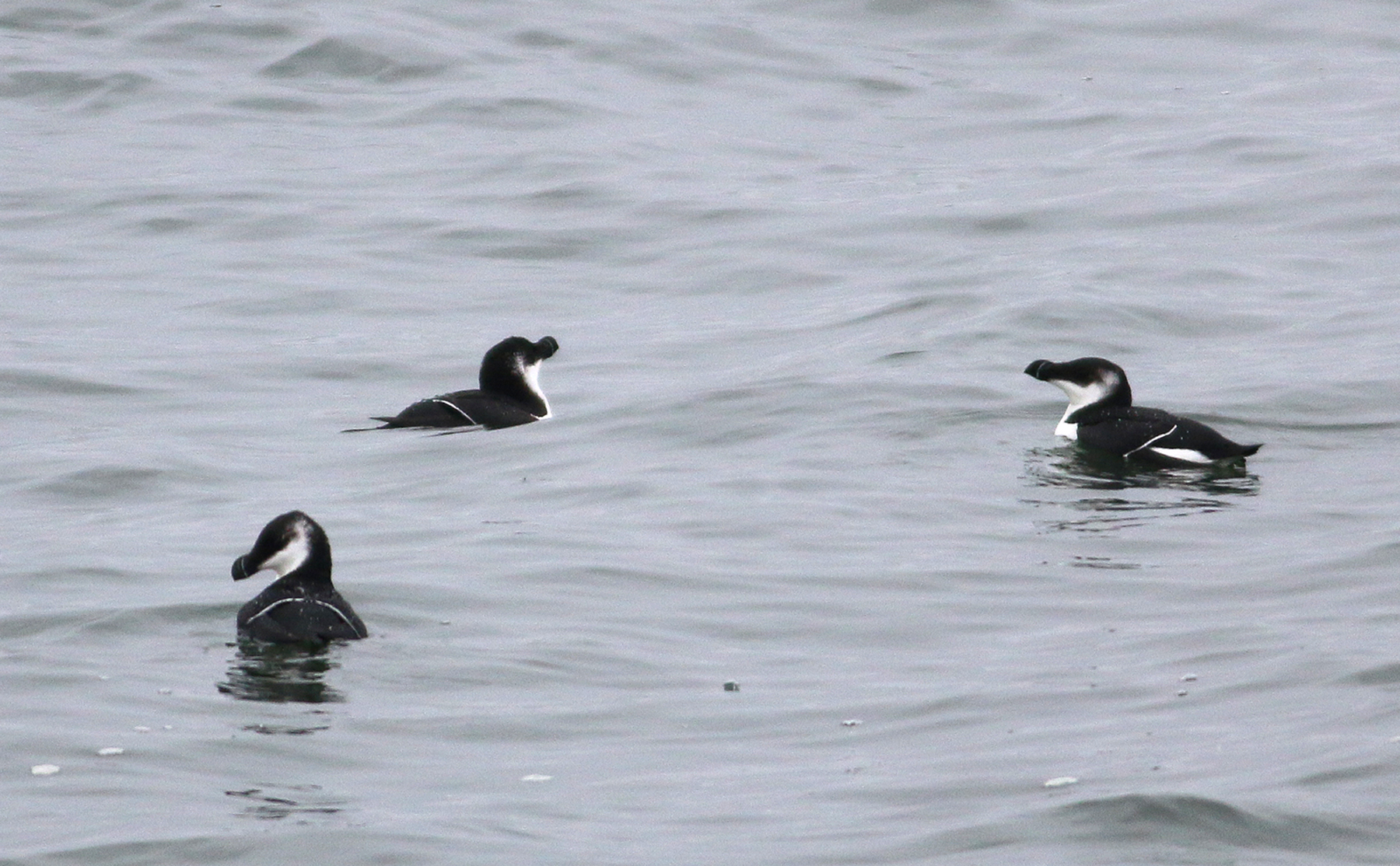
And here’s a group of three adult Razorbills on the surface together. I missed the photo of four Razorbills lined up perfectly.
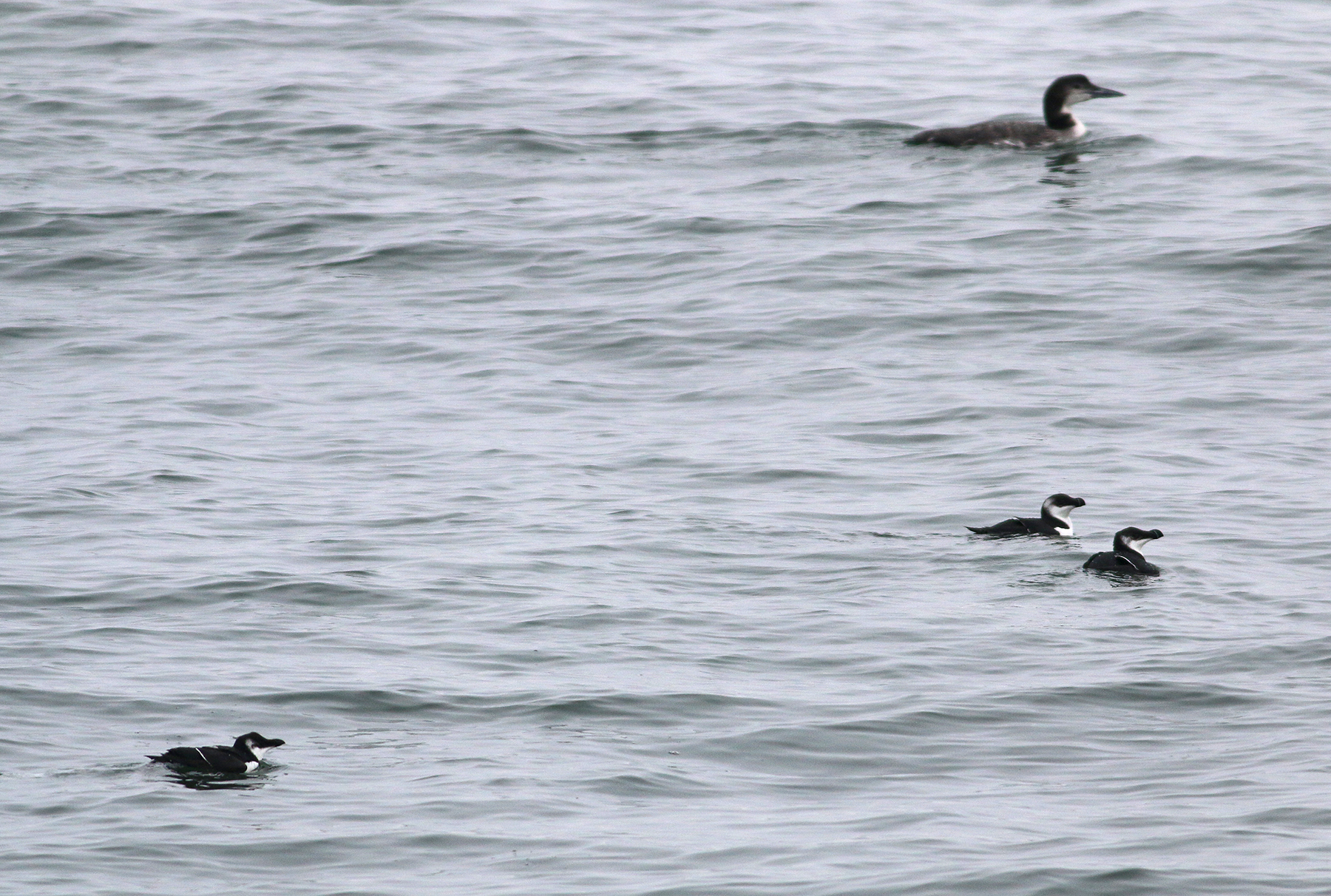
Here’s another group of three Razorbills, with a Common Loon in the background providing a nice size comparison.
So if you haven’t seen your lifer Razorbill yet, or your 2019 Razorbill, give Manasquan Inlet a try. It is unclear why the Razorbills don’t appear all up and down the coast (we spent five hours at Holgate Beach this week without a single alcid), but for whatever reason, they like Manasquan. Which means I like it there too.
Like many birders I used to have a New Years Day tradition of going out early on Jan. 1, trying to start the year off with a nice list of birds. Back when I was living in New York, that meant traveling the relatively short distance to Jones Beach, Point Lookout (where we would typically arrive around noon to witness the town’s annual polar bear plunge..brrrrr!), and finishing at Jamaica Bay. That tradition changed after I moved to New Jersey, and instead of finding a new New Years route, I essentially gave up on starting a big year list. I still like birding on New Year’s morning, but with more modest goals.
This year the weather was less than ideal, with 25 mph NW winds gusting into the mid-30s throughout the day. So instead of battling the winds all day, Jeanine and I decided to try a shorter Manasquan Inlet sit, where the wind should be mostly at our backs. We made the requisite stop at Lake of the Lilies, where it was nice to see a few Redheads and a surprise Wood Duck pair.
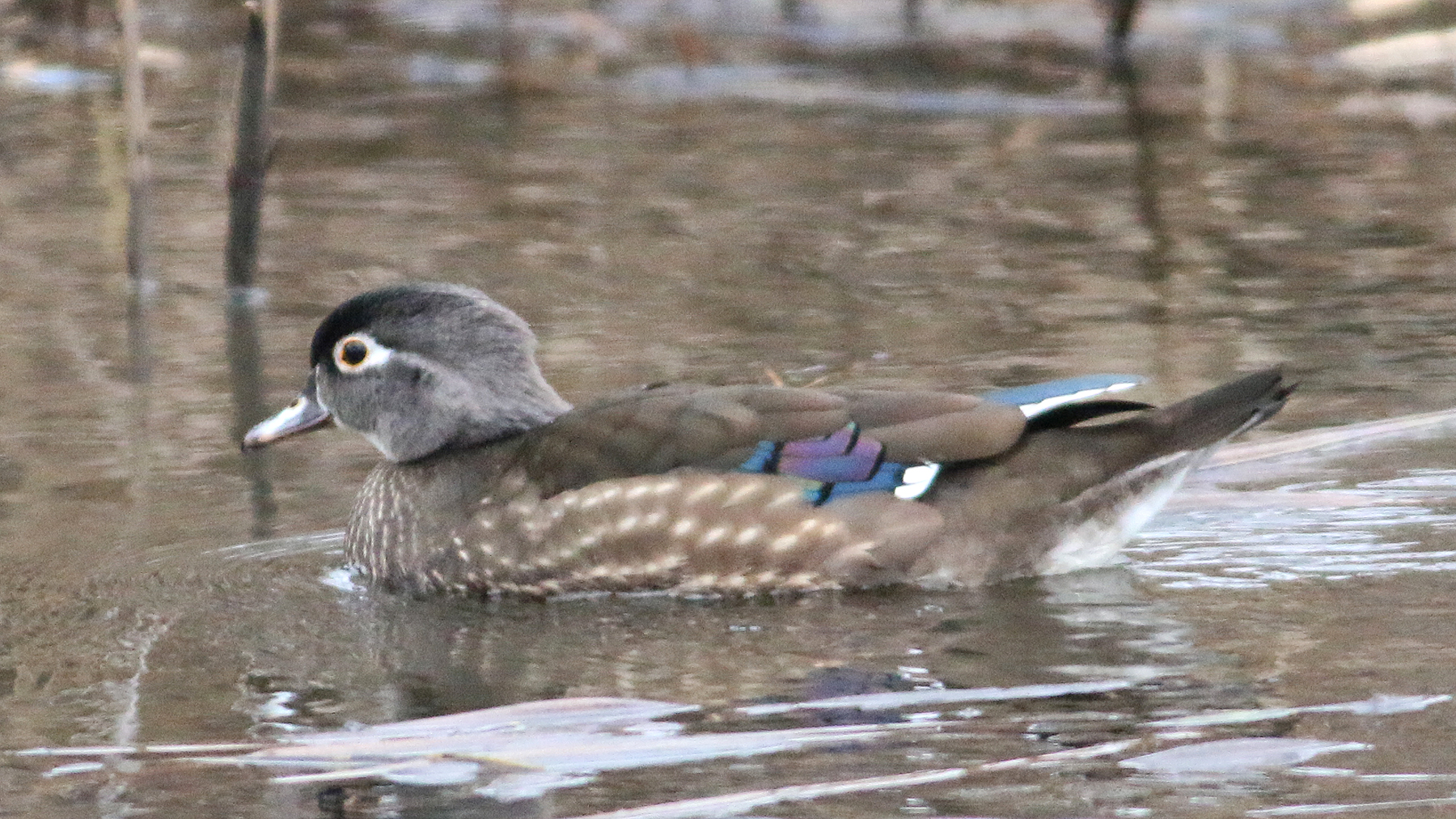
A hen Wood Duck. This would normally be considered quite a handsome bird If it wasn’t for the partner males being so gaudy.
Before heading out to the inlet, we decided to check the gull roost at the Baltimore Ave. sandbar. Fortunately it was low tide and filled with gulls, packed almost too tightly to scan well. Something flushed the flock, and after they landed again, I spotted a big white gull sitting alone. Glaucous Gull! I include the exclamation point because Glaucous Gull was a nemesis bird for me. I saw a distant one two or three years ago floating amidst the icepacks on the Delaware River for a lifer, but never got photos or great close looks. I have been trying to find one since then to add to my photo collection, but with no luck. So it was already a great start to the year.
We then went to the jetty hoping for some alcids just as two birders who had nothing notable to report were leaving. It’s never a very good sign to see disappointed birders leaving the location that you are heading to, but heck, it’s a new year so we were optimistic. Shortly after sitting down we started chatting, and a Razorbill popped up in the middle of the relatively narrow inlet! Razorbills are great to see, but are kind of scary because they have a nasty habit of diving and just disappearing, even though there is no place to hide. They have to surface again SOMEWHERE nearby, don’t they? Yet somehow they manage to disappear. This one was different. It dove for a minute or less, surfaced, and repeated doing that for maybe ten minutes or so. And then it was gone. Shortly before its last dive two more birders arrived, so they were able to see it, but it never appeared again despite four sets of eyes peeled out for this bird. That’s the way Razorbills go.
Later on as we were sitting there, Jeanine spotted another Glaucous Gull (perhaps the same one as we saw an hour previously) flying out southward at the end of the jetty, completing a wonderful day under challenging windy conditions. It was a great start for the year.
OK folks, it’s time for my top 10 list for 2018. This is not necessarily the list of the rarest birds that I’ve seen this year, but what I’d call the most rewarding birding experiences from this past year.
#10: Upland Sandpipers. This was a good year for me to see Upland Sandpipers. I volunteered in the summer bird census at Lakehurst Naval Air Station, which is the only place that I know of where Upland Sandpipers now breed in NJ. That provided ample opportunity to visit and see and hear the Uppies, but although their flying displays were impressive and delightful, views of them on the ground were rare and distant and fleeting. Then one day in August when Jeanine and I were driving around Brig, what do we see along the side of the road but an Upland Sandpiper, closer than I’ve ever seen one before. I love surprises like that.
#9: Kentucky Warbler. I have seen only one or two Kentucky Warblers in my life. I have heard a few more, but in dense brush and with little hope of getting good looks. We were given a hint as to a location where historically they have been seen, so we gave it a try this May. It was a fairly big reserve/park, so I was not overly optimistic, knowing the secretive habits of this species. Yet when we arrived near a creek, there was one feeding and calling, giving superb views. After birding the rest of the reserve, when we approached the area again, the bird was not visible, but we we able to hear and see it (or another one) a short distance away. So getting to find Kentucky Warblers twice in one day (whether the same bird or different ones) was a real treat.
#8: Ravens at Sandy Hook. Common Ravens are becoming much more common in New Jersey, but it is still a fortunate day when we can see one or two of them. Yet on a trip to Sandy Hook in November, Jeanine and I were treated to seeing seven Ravens flying and circling over us together and calling and interacting with each other and with a Merlin. Wow. Graaawwwwkkkkk.
#7: Razorbills. It is turning out to be a super Razorbill winter here in NJ in 2018-2019. To give you an idea of the extent of the event, there were only three Razorbills spotted during the entire SEASON at the Avalon Seawatch in 2017, and in 2016 the season total was 11 Razorbills. This year a few consecutive days at Avalon each yielded more than 1000 Razorbills!! Unfortunately, on the afternoon that we showed up, all of the activity that day was in the early morning. (groan!) So in the last week of this year, my friend Chris and I headed up to Sandy Hook to see if we could spot some on the water. Indeed, we got a quick look at one, which was a state bird for Chris, and later in the day I spotted a group of four more together, one of which gave extended great scope views. I have never seen that many Razorbills together previously. If the Razorbill sightings continue through this winter, I suspect that they will be a highlight for the 2019 season. And maybe other alcids will join them.
#6: Lakehurst Nighthawks. One morning while volunteering at the Lakehurst bird census, the fog was making things difficult. But as soon as the fog lifted, there were a dozen or so Common Nighthawks feeding all around me. Circling again and again, calling constantly. It was quite a show. If it were the old days of film cameras, I would have shot several rolls of film. At times like this, I am glad that we have digital photos. What a treat to see them!
#5: Fall migrants at Sandy Hook. Yet another Sandy Hook highlight was a fall migration day in late September that started with a Connecticut Warbler perched on a low branch for nice views. Since it is so tough to see Connecticut Warbler anywhere, that sighting alone would have made it a notable day. Then after it disappeared into the mugwort and we were trying to re-find it, another bird flew out to a distant tree. I gave up on the warbler and was able to re-find the second bird, which turned out to be a Dickcissel. What a nice duo. Then an hour or so later while strolling around and sorting through a nice sparrow flock, one of the birds had distinct facial markings. A Lark Sparrow. What a great trio for a fall migration day. We met a group later that asked “Did you see anything interesting?” Our smiles probably said it all.
#4: A 21-warbler day. If you want to see lots of warblers in NJ, the place to go is Garret Mountain. So Jeanine and I took our annual expedition there in May, and we weren’t disappointed. I spotted 21 warbler species that day, and Jeanine ended up with 22! Somehow I missed Blackpoll Warbler that day, which is normally easy up there. It was a wonderful excursion with lots of birds including multiple Nashvilles, Bay-breasteds, and Canadas, and singing Tennessees, which I don’t see or hear very often. There’s something wonderful about breaking the 20-warbler barrier in a single day.
#3. Yellow-green Vireo. It started out as yet another nice September fall day in Cape May. Until a text appeared saying that a Yellow-green Vireo was just captured in a banding operation, and they would be releasing the bird in about 5 minutes. Luckily we were only a few blocks away, so we stopped by. I wouldn’t call it outstanding birding, but it was definitely an interesting experience to see this bird (which is rare to see anywhere in the US, and a first for NJ) up close, with a tracking device attached, being displayed for the birding paparazzi surrounding it. And then upon being released, disappearing like a bullet across the street, never to be seen again.
#2: Ecuador. My only foreign birding trip this year was a January excursion to the east slope of Ecuador with Pete and Jeanine, ranging from the Amazonian lowlands up to the Andean paramo. It was an outstanding trip with many highlights: quetzals, aracaris, numerous tanagers, a variety of hummingbirds, Hoatzins, and much much more. This was my favorite kind of birding trip, in which we had to find and identify the birds almost entirely by ourselves, with just 2 1/2 days using local guides. I love waking up in a new location, walking out the door, and nearly every bird and plant is different from those that I see at home. Despite having been to Ecuador twice previously and not having much guiding on this trip, I still manged to find 59 new lifer species, a good indication of the number of species that can be found in Ecuador.
#1: Roseate Terns. I had never seen Roseate Terns clearly. Oh sure, there was that trip to Tobago where some terns were flying by that a guide identified as Roseates, but I couldn’t really identify them. They appear in NJ annually in small numbers, but not to me. Until this year. Then on June 25, on one of our many trips to the Sedge Island this year, Jeanine and I spotted a tern that looked different…longer winged, and lighter color overall, and with maybe a longer bill. It had to be a Roseate, right? But then before getting confirmation and a photo, it flew off and landed on a distant sandbar. We hiked over with scope, and now were able to see details, including bands. ROSEATE TERN! And then we saw another. And another. Wow. Three Roseates. We thought that was the end of the story, but then on our next trip we saw another one, and then on another trip a week later three more, so they were there for at least two weeks. The interesting thing is that there were were actually multiple Roseates cycling in and out of the Sedges this summer, based on the number of birds that we and others saw and their bands. Have they been there in previous years and we just not noticed them? Will they be back again next year? You know that we’ll be looking for them. Stay tuned.
This was predicted to be a banner year for winter finches here in New Jersey, and so far that is the case. For those who are adept at identifying them by their flight calls, reports are emerging throughout the state of Purple Finches, Pine Siskins, Red Crossbills, a few Common Redpolls, and even Evening Grosbeaks. Hearing them fly by is one thing, but it’s quite another to get good looks at them. I have seen a good number of Purple Finches this fall, which are probably the easiest and most regular of the winter finch group.
My first exposure to Pine Siskins this season was spotting two of them about two weeks ago at Cedar Bonnet Island. Last week I was able to see a nice group of around eight Pine Siskins at feeders in Cape May, and this past weekend we saw at least two of them at our monthly Cloverdale Park walk. Today I was treated to nine of them at my yard feeder. So it looks like it will be another banner siskin year. Two years ago we had Pine Siskins at Cloverdale into May, while last year we had none, nicely showing the irruptive nature of this species and its relatives.
Yesterday Jeanine and I were fortunate to be in Cape May when a report came in of a group of four Red Crossbills that were spotted feeding in the pine trees in Cape May Point. We made our way over, and using the ‘find the birders’ strategy, we were able to get great looks at four Red Crossbills methodically feeding on the pine cones. I am assuming that this is merely the tip of the iceberg, and we will be finding more and more of them this season. Heck, it’s only November and the finches are appearing in many places. Five years ago, before I moved back to NJ, we had an irruption year in NY, when both Red Crossbills and White-winged Crossbills were seen well into early spring. That year was the last time that I saw them until yesterday. Look at the photos to see how crossed their bills are, and the video gives an idea of their methodical feeding activity.
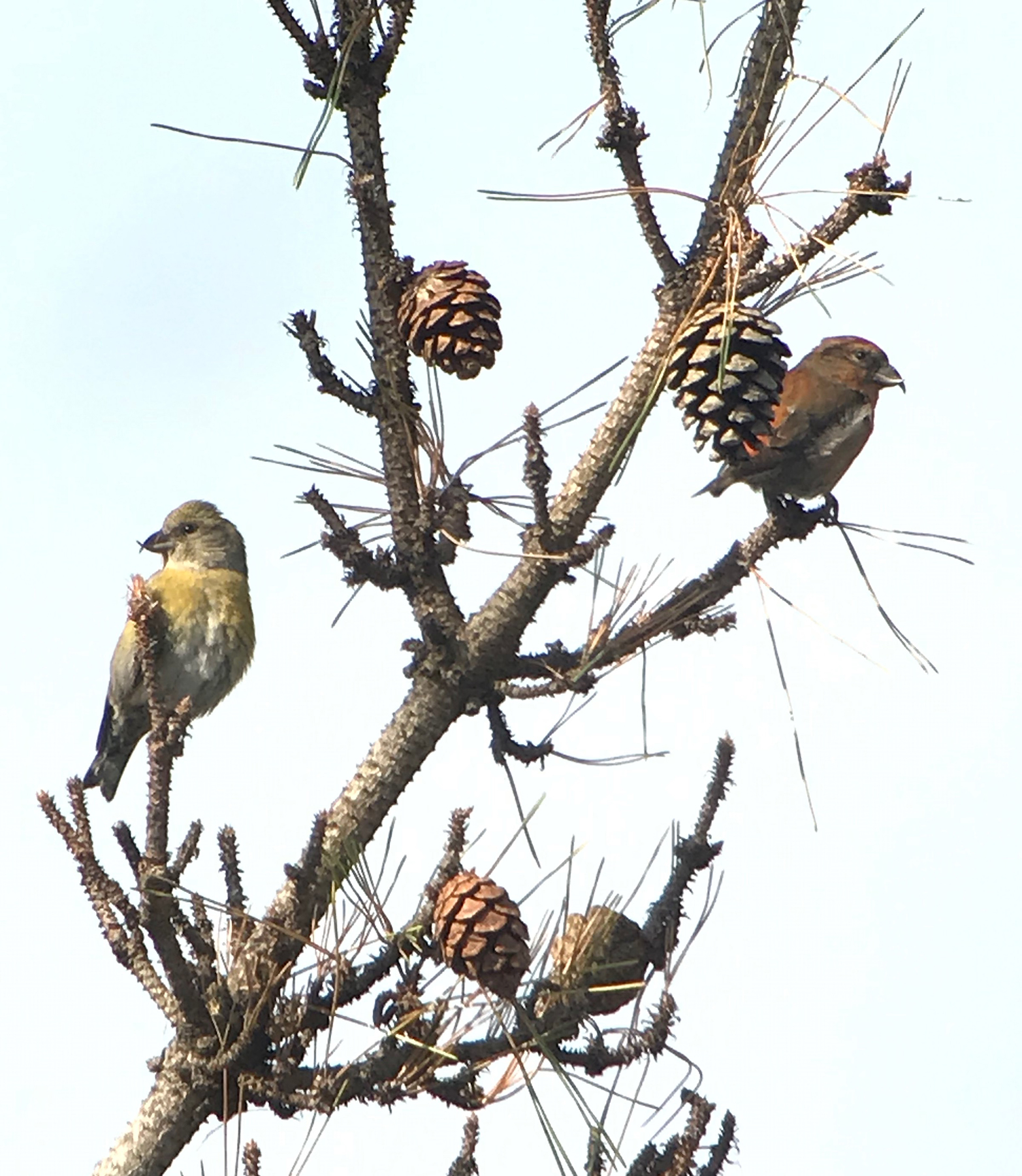
Male Red Crossbill on the right, and the yellowish female is on the left. Note the incredible crossing of their bill tips.
We have yet to spot any Evening Grosbeaks, which are the real prize this year, but it is only a matter of time. And will they be joined by White-winged Crossbills, Common Redpolls, and do we dare dream of Pine Grosbeaks? Stay tuned and keep your eyes and ears open.
I am proud to be a member of the Southern Ocean Birding Group. There are many advantages to the group: friendly birders, a super collection of presentations throughout the year, hosting the Tuckerton Christmas Bird Count, sponsoring yearly cleanups of Great Bay Blvd WMA, and providing scholarships to local college-bound environmental students. Another big advantage to being an SOBG member is that the group rents a house in Cape May for four nights each fall. And fall in Cape May is the nearest thing to birding heaven here in NJ. Even though we live an average of two hours north of Cape May, it is entirely different when you wake up right in the middle of the excitement.
This year we decided to arrive a few weeks earlier than our typical October stay, and it was interesting to note the differences in the birds this year compared with what we have seen for the past few years. There are so many good places to bird in Cape May that even during a five-day stay we didn’t have time to cover them all. One of the highlights each year is spending a few hours at the Cape May Hawk Watch, one of the premier hawk watch sites in the world. Mid-October here presents a nice mix of raptors dominated by Sharp-shinned and Coopers Hawks, while on this trip the story was falcons. Merlins and American Kestrels were more common than accipitors on this trip.
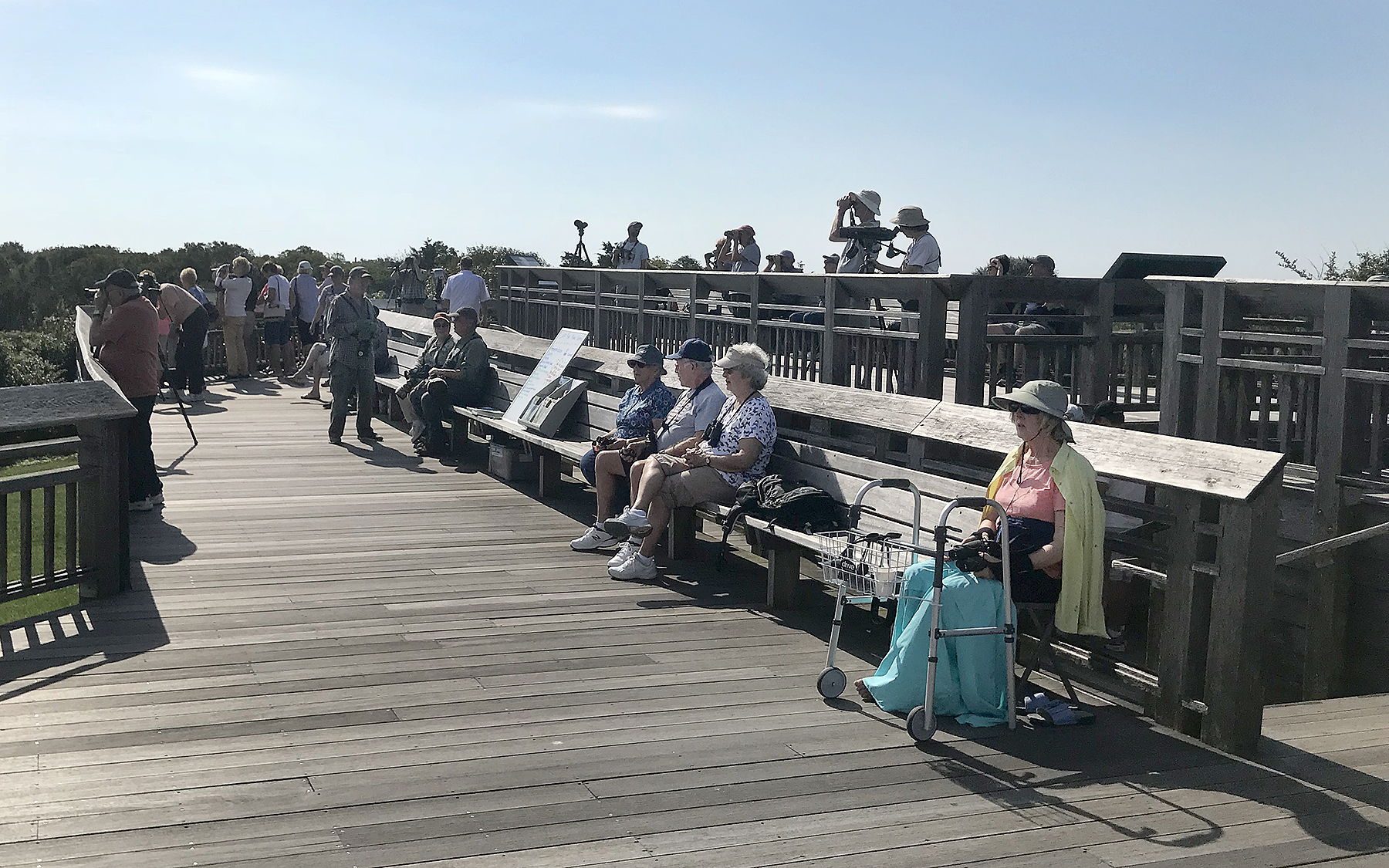
There’s plenty of room on the Hawk Watch, with sufficient benches to relax, a professional hawk counter highlighting interesting birds, naturalists to answer questions, and Swarovski scopes to view birds.
Another highlight each year is visiting Higbee Beach WMA to observe the morning flight phenomenon, where warblers and other migrants that arrived overnight traverse just above the treetops, heading northward to avoid a long flight over Delaware Bay. Our morning at Higbee was one of the most productive of the trip, highlighted by a surprising Clay-colored Sparrow and an immature Red-headed Woodpecker that were found within 15 minutes of each other. The Clay-colored Sparrow was only the third reported in NJ so far this year, and Red-headed Woodpecker is not very common in Cape May. It was interesting to watch the Red-headed Woodpecker noisily protect ‘its trees’ from the numerous Northern Flickers that were migrating through. Add in birds like Philadelphia Vireo, Northern Waterthrush, Swainson’s Thrush, and Canada Warbler and you have the recipe for a terrific morning.
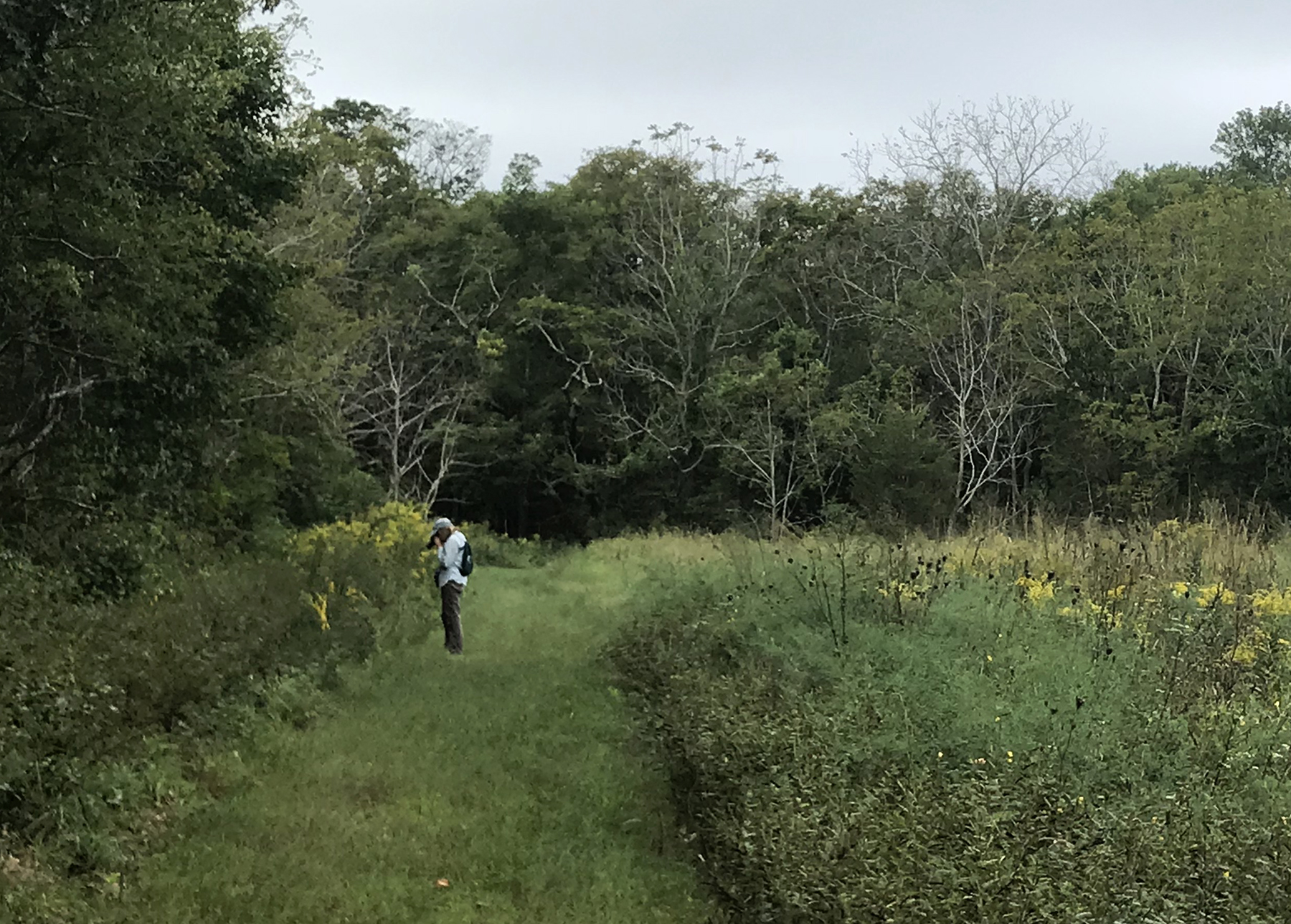
The fields and mowed paths of Higbees, combined with birds moving through the treetops and raptors patrolling the skies, provided hours of productive birding.
The day that we arrived at the house, a text alert reported that activity was strong around Lake Lily, especially on the north and western sides. This was great news, since our house is on the western shore of Lake Lily. And indeed, it was quite productive this year. In past years, because we usually arrive in mid-October, most warblers have already passed through, with the vast majority that remained being Yellow-rumped Warbler. This year we had a greater diversity of warblers, with Blackpolls being the most common, followed by Northern Parulas, American Redstarts, and Black-and-white Warblers. In previous years, sightings of Cape May Warblers were rare for us, while this year they were not uncommon. (yay!) Overall, the group spotted 18 species of warblers on this trip, and somewhat refreshingly, we didn’t see a single Yellow-rumped Warbler, highlighting the advantage of visiting here at a different time of year.
One problem with renting this house in Cape May is that it is tough to stop birding. On most days we would start birding when birds stopped becoming featureless sillhouettes around 7AM, return back to the house around noon for lunch and rest, and while trying to eat lunch on the porch (always with binoculars within an arm’s reach away!) finding that we were being distracted by nearby activity. Red-breasted Nuthatches squeaked from the nearby trees. A cooperative Wilson’s Warbler stayed in a holly tree just alongside our porch for an entire day. And one day Jeanine accidentally flushed a Mourning Dove from the front pine. A Mourning Dove sighting is not unusual, but this bird returned back to nearly the same location shortly afterward. Closer inspection revealed a nest with two chicks on it that provided my first sighting of a Mourning Dove nest. It’s amazing that such a common bird avoided detection of its nest for so long. In fact, we were there for three days before we noticed the nest just a few feet from our front porch.
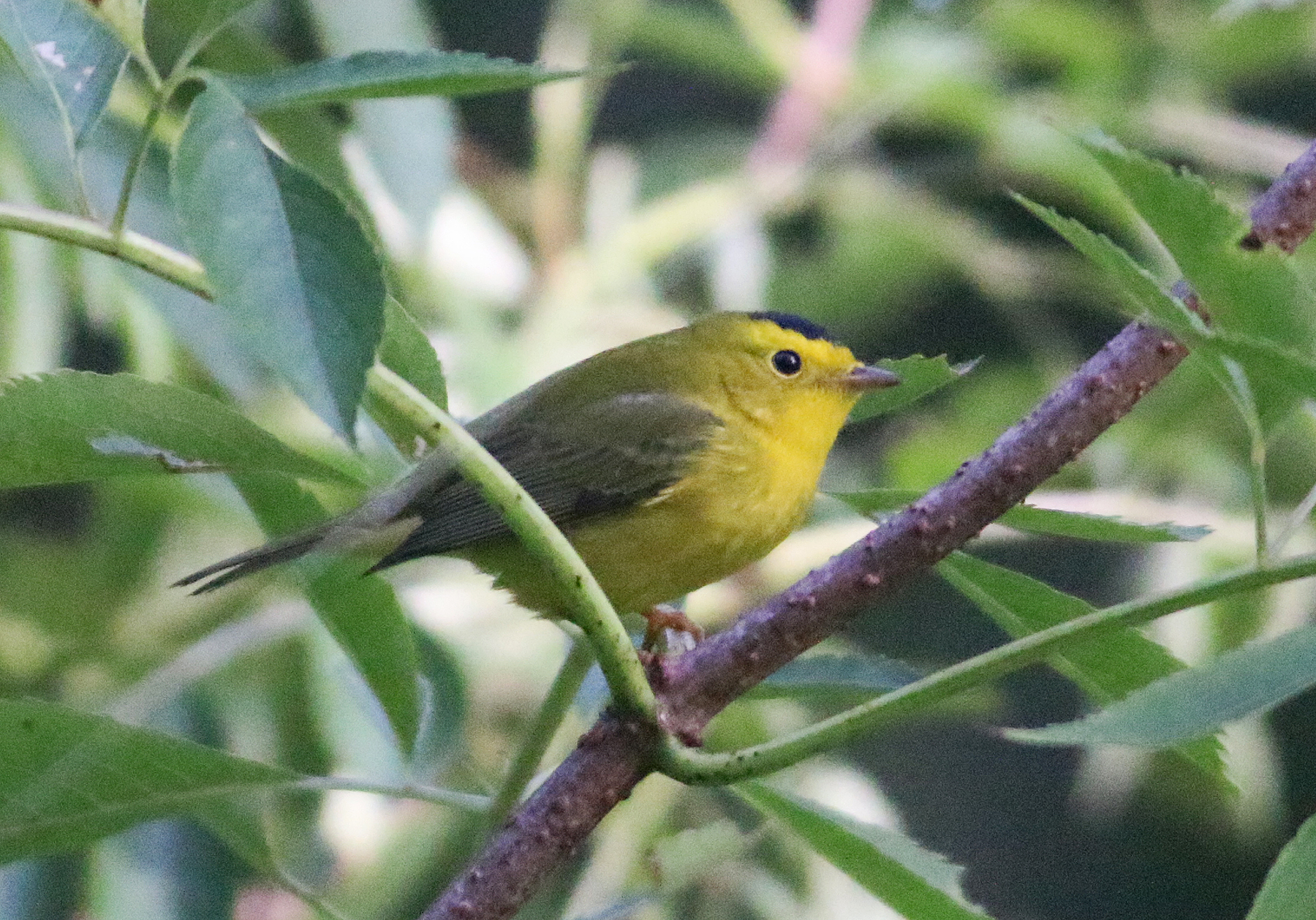
Wilson’s Warblers were seen at the CMBO Northwood Center and in a holly tree next to our front porch.

Mourning Dove adult with one of its chicks on the well-hidden nest just a few feet from our front porch.
This year’s trip included two remarkable episodes that were detailed in other blog entries. One was the capture of a Yellow-green Vireo in the banding nets at the Meadows, allowing us to view this first-for-NJ species up close. You can read more about it here. The second episode was a sighting of a Parasitic Jaeger on land off of the Coral Ave. viewing platform. You can read about that experience here.
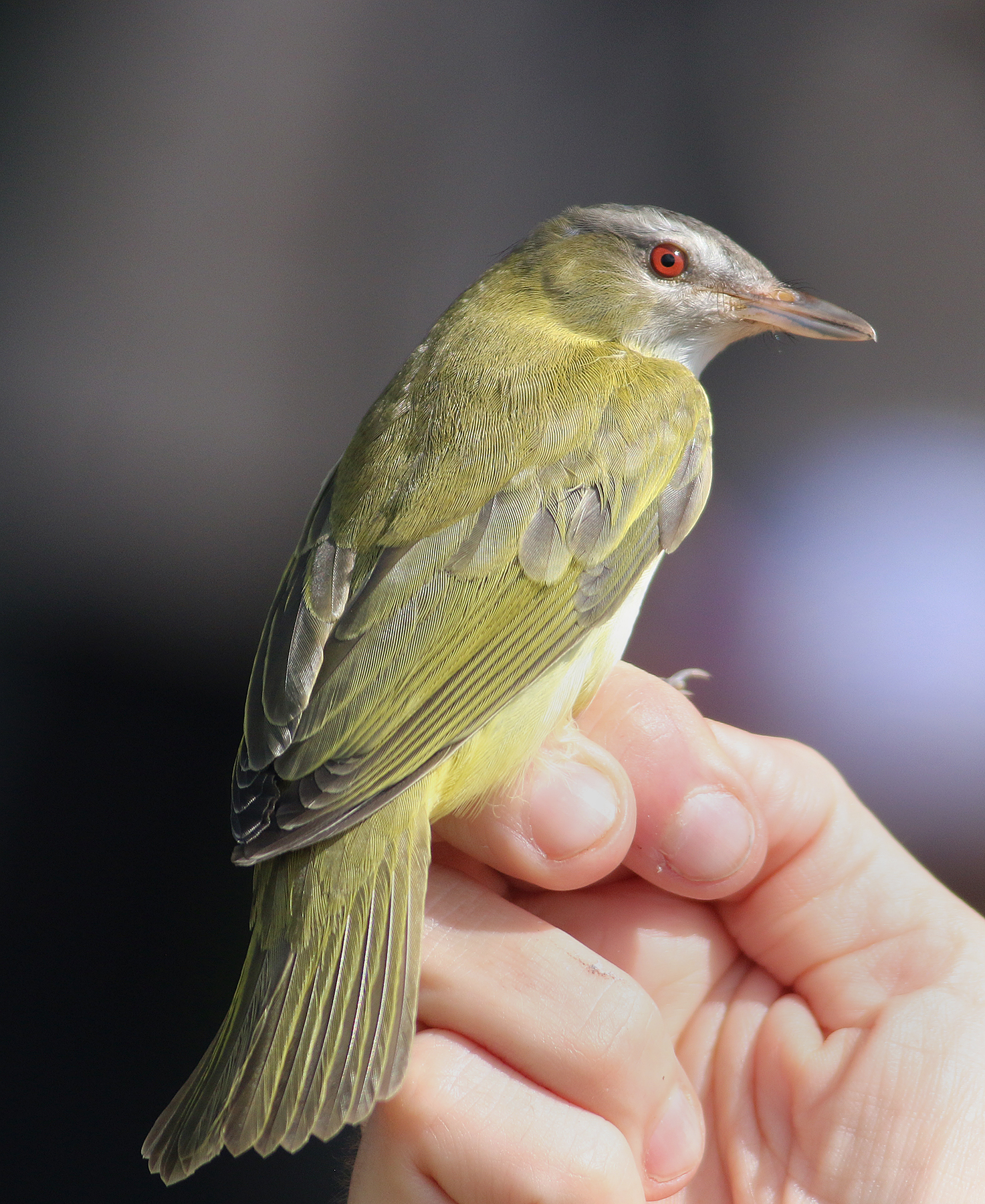
New Jersey’s first record of Yellow-green Vireo, captured in a banding net and released at the Cape May Meadows.
Cape May in fall is much more than birds. Wildflowers are still in bloom, butterflies are migrating, and dragonflies are in the air. Here’s a sample of some of our non-bird distractions.
Another highlight of any SOBG outing is food, and we had our share of day visitors and great home-cooked meals. One reason for renting this house is the spacious dinner table, which held fifteen participants one night, including dinner guests Kevin Karlson and Dale Rosselet. Good times.
I already am looking forward to returning back next year.
Our birding group is in Cape May for five days. This morning after we just finished scanning for birds at the Concrete Ship a text alert arrived as we were ready to head back to our rental home for lunch. I normally keep the text alerts off when I am birding since I don’t want to be distracted, but when in Cape May it is a good idea to know what is being seen in real time. This time it paid off. The text reported that a banding project had just captured a Yellow-green Vireo in its nets. The bird was healthy and would be released in 15 minutes, presumably after measurements and documentation were completed. We were only 3-5 minutes away. So should we go look at the bird being released or head home for lunch? Jeanine and I were both ready for lunch, but while driving home we changed our minds and both agreed that it might be fun to see this bird.
Why would be care about a Yellow-green Vireo? This is a species that had never been seen previously in New Jersey. It is a bird of the tropics; one that barely makes it into southern-most Texas, and the furthest north that it had been documented on the east coast was in North Carolina. So it was indeed a rarity. A mega-rarity.
We arrived at the Meadows with about five minutes to spare, and a group of 25-30 people were assembled, including many of Cape May’s elite birders. After a few minutes, CMBO director David La Puma announced that they were requesting permission to tag the bird with a device to monitor its movements, so the release would be delayed slightly. In the meantime they brought the bird out for a few photos. It was a lovely bird indeed, looking like a very bright Red-eyed Vireo and with a much larger bill.
Permission was obtained to tag the bird with a monitoring device, so it was brought back into the banding shed, and five minutes or so later it was brought back out for release. The banders showed off the attached monitoring device, which weighs less than a postage stamp. A visiting bird guide from Uganda was given the opportunity to release the bird, which immediately flew off across Sunset Blvd., not to be seen in the area again.
I have seen Yellow-green Vireos while in the tropics, so it wasn’t a new life bird for me, but it is always great to see birds close-up, and moreso to be present for a small part of NJ birding history. You never know what will happen in Cape May.
